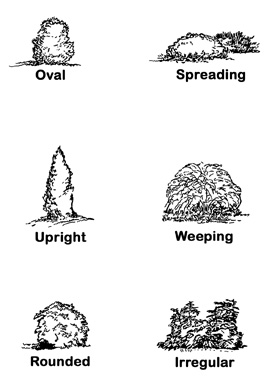Our native landscape is the inspiration for this guide to native plants for Georgia gardens.
- Acknowledgments
- Introduction
- Plant Ecology of Georgia
- Establishing Native Plants in the Landscape
- Guide to Plant Descriptions
- Medium and Large Trees
- Small Trees
- Shrubs
- Woody Vines
- Glossary
- Suggested References
"A thing is right if it tends to preserve the beauty, integrity and stability of the biotic community; it is wrong when it tends otherwise." —Aldo Leopold, "The Land Ethic," A Sand County Almanac
Acknowledgments
We would like to acknowledge the following University of Georgia faculty who wrote the original manuscript for this publication: Mel Garber, E. Neal Weatherly Jr., Kim Coder and Darrel Morrison.
We also extend sincere appreciation to the following individuals who provided images of the plants described in this publication. Many of the images are copyrighted and have been used with special permission from the photographers and/or the organizations providing them. Any use of these images beyond this publication is discouraged and will require permission from the photographers.
- Guy Anglin
- Chuck Bargeron
- Steve Baskauf
- Ted Bodner
- Matthew Chappell
- William M. Ciesla
- Shirley Denton
- Chris Evans
- Troy Evans
- Wendy VanDyk Evans
- Dennis Gerard
- Rich Gillis
- Tim Grissom
- Alan S. Heilman
- Walter Hodge
- Todd Hurt
- Walter S. Judd
- Ernest Koone
- Gerard Krewer
- Ed Lambert
- Ron Lance
- John Little
- Tom McClendon
- Ed McDowell
- David McManus
- Fred Mileshko
- James H. Miller
- Robert H. Mohlenbrock
- David J. Moorhead
- Fred Nation
- Gil Nelson
- Carol Nourse
- Hugh Nourse
- John Ruter
- Steve Sanchez
- Theresa Schrum
- David Stephens
- Michael Strickland
- Gary Wade
- Betty Wargo
- Paul Wray
- Bob Westerfield
We also express appreciation to the Georgia Native Plant Society for providing funds for technical support.
Introduction
What Are Native Plants?
There are many definitions for native plants. Several references say native plants are those that grow naturally in a particular region without direct or indirect human intervention. Other references place a historical timeline on native plants, saying they are plants that were present in a particular area prior to European settlement of that area. Others say they are plants that have inhabited a particular region for thousands of years. Even the federal government published an "official" definition in the Federal Register, defining native plants as those that are "naturally occurring, either presently or historically, in any ecosystem of the United States."
Before the development of the nursery industry, native plants were the only choice for landscape plantings. Early settlers transplanted dogwood, redbud, oak-leaf hydrangea and other plants with appealing qualities from the woods into their landscapes. Harvesting native plants from the wild for landscape purposes is no longer acceptable and is illegal in some areas. Today, nurseries and garden centers offer a wide variety of native plants, and some even specialize in native plants exclusively.
Why Plant Native Plants?
A native plant community, left undisturbed and incorporated into a landscape, is low-maintenance and self-sufficient. Today, there is a growing interest in preserving native landscapes as "green space" in residential communities, giving them a park-like ambiance and providing space for birds and other wildlife. A casual stroll through a woodland setting teeming with ever-changing flora and fauna is a relaxing and peaceful diversion from our daily lives.
Native plants provide "watchable" wildlife habitats. Native butterflies, insects, birds, mammals, reptiles and other animals evolve with the native flora and are sustained by it year round, providing diverse food, shelter and support for native food webs. They also create a sense of place, fostering appreciation of our natural heritage and the diverse beauty of unique regional landscapes.
Weather extremes, either temperature or drought, have shown us one of the best and most practical reasons for using native plants — their adaptations to local climate. Many Georgians will recall the extremely low temperatures in December 1983 and January 1985 that killed or critically damaged many introduced species. Few native plants, however, were injured because of the cold hardiness they had developed over many generations. When provided with growing conditions like those of their native habitat, native plants are dependable additions to cultivated landscapes.
Ecological preservation is another reason for using native plants. With the increasing destruction of natural environments for urban and agricultural use, many plant species and the animals they support have declined dramatically in numbers and in range. In fact, some native plants, having a limited growing range and very specific growing requirements, may decline or die when subtle alterations are made in their native habitat. Oconee-bells (Shortia galacifolia) and Florida Torreya (Torreya taxifolia) are examples of plants that require specific habitats and are rare in the woods of Georgia. Failure to conserve, tend and preserve the habitats of these and other native plants can lead to their extinction. Habitat protection and preservation are obligations of all Georgia citizens.
Plant Ecology of Georgia
The ecological diversity in Georgia is complex and wide-ranging, from high mountain ridges of north Georgia to flatwoods and swamps of south Georgia. Among the geographic regions of the state, numerous ecosystems or environments exist where unique plants and animals have adapted. In some cases, plant species have adapted to very specific and restricted environmental conditions. Others occur over much wider and more general environments.
Georgia environments can be divided into a number of basic groupings: wet, moist, dry, upland or bottomland. There are more than 100 distinct environments or plant communities in the state. Depending upon past adaptive changes in each of these environments, some plants will be dominant while others will be rare or unable to survive. Plants grow where they do because they have finely adjusted to the local environment. For example, some plants require a bare, mineral soil for seed germination. A thick layer of pine straw or leaf litter on the surface of the soil will prevent this type of species from getting started. Some bottomland species of trees grow well on upland sites once they have germinated. Their seeds, however, require wet soils in which to germinate. Other plants are tightly constrained by the environment to small ecological niches or "homes." Although many of these plants will not grow and reproduce in cultivated landscapes like they do in their native habitat, they can adapt and become fine specimens.
Planting trees in areas similar to their native habitat will maximize their chances of survival and success. In nature, the macroclimate of an area, including winter and summer temperature extremes, precipitation and humidity, dictates the geographic distribution of a native plant. For instance, white pine and sugar maple can be found in the mountains of north Georgia, but the heat and humidity of the Piedmont and Coastal Plain restrict their occurrence in south Georgia. Fevertree (Pinckneya bracteata), Red Titi (Cyrilla racemiflora) and Black Titi (Cliftonia monophylla) are limited to the southern half of the state because the soils and climate there satisfy their special growing requirements.
Environmental features such as moisture, soil pH and sunlight level of a smaller, more focused area, are called the microclimate. Subtle changes in microclimate influence where native plants grow. Mountain Laurel (Kalmia latafolia), for example, is common in certain areas of north Georgia, but it is rarely found in the Coastal Plain. Pockets of Mountain Laurel, however, can be found as far south as the Florida panhandle in areas where it receives its required growing conditions, including adequate moisture, shade and cool soils.
Establishing Native Plants in the Landscape
Design Considerations
Our native habitats are full of subtle beauty that can be skillfully and beautifully incorporated into our gardens. Few people can resist the dramatic and breathtaking beauty of native azaleas, the fragile white blooms of the Silverbell (Halesia spp.) or the delicate white, drooping spikes of Sourwood (Oxydendrum arboreum). True plant lovers will carefully select from the array of plants available, both native and introduced, to create the most beautiful and functional gardens possible.
People who own naturally wooded lots or acreage will benefit from and enjoy the shade, coolness and beauty of a forest. There are several ways to develop these types of properties while capitalizing on their native beauty. One way is to leave the largest and healthiest trees that form the canopy untouched, remove weak, spindly and diseased trees, then selectively thin the undergrowth. Pine straw and leaf litter left on the site provide natural mulch, and grass and/or ground cover planted in open areas fill the gaps where trees have been removed.
Another approach is to remove no more vegetation than is necessary to locate and build the house. This hands-off approach is more environmentally friendly. It preserves species diversity and distribution, and maintains the natural environment. If other species are introduced, their cultural requirements should be compatible with those of plants already there.
Unfortunately, many new landscapes do not have a plant community already in place. It takes time for a tree canopy and subsequent plant community to evolve on a site. If existing trees are small, delay planting shade-loving plants until tree canopies develop and cast shade. Deciduous trees provide moist, fertile mulch for understory plants. Broadleaf evergreens, coniferous trees and shrubs are useful in providing natural windbreaks, screening unattractive views, and creating areas of privacy for outdoor living and enjoyment.
In large, sunny, open areas, such as fields and rights-of-way, native grasses may provide a low-maintenance alternative to turfgrasses. Broomsedge (Andropogon virginicus) and other early succession forbs, may already be present in open, sunny areas. Mints, goldenrods, asters and legumes can often be found growing naturally with many native grasses. These areas can be mowed once a year to prevent forest succession. Otherwise, they can be left alone.
Site Evaluation and Plant Selection
The guidelines when planting a native landscape are the same as those for any landscape: select plants adapted to the soil, local site conditions and climate. Putting the right plant in the right spot will help ensure your long-term satisfaction and success with the landscape. Also, make certain all plants in a given location have similar cultural requirements for ease of maintenance.
Native plants vary widely in their requirement for plant nutrients and soil pH (a unit used to measure the acidity or alkalinity of a soil). Since pH influences nutrient availability in the soil and nutrient uptake by the plant, it is a useful measurement to know before planting. A soil test, available through your local county extension office for a nominal fee, will provide information on the nutrient content and pH level of the soil. Many soils in Georgia are acidic (pH less than 7.0). Most native plants grow well at a slightly acidic pH around 6.0, although some ericaceous plants, like blueberries and rhododendrons, prefer strongly acid soils having a pH below 5.0. Although native plants generally do not require supplements to their native environment, adjustments may be necessary when they are planted outside their native habitat to provide suitable soil fertility for best growth.
The level of sunlight is an important consideration. Most large trees require full sun to grow and develop properly because, in nature, they are dominant plant species. Planting sun-loving plants in shaded areas will result in spindly, weak growth, while planting shade-loving plants in full sun may cause leaf scorching or anemic-looking foliage.
Plants that naturally occur under the shade of more dominant trees are called understory plants. To simulate the understory, plant shade-loving native plants where they will receive partial shade, particularly during the afternoon when sunlight levels are usually more intense. It often requires one to two growing seasons to determine when a plant can adjust to the specific light environment provided. Furthermore, light levels change as the plant canopies mature and change.
Water is essential for plant growth. In nature, plant growth on moist sites is usually abundant and lush. On dry sites, plant growth is often sparse and stunted. Plants vary tremendously in their need for moisture and their tolerance of moisture extremes. Northern and eastern exposures, slopes and bottomland are normally moist, while southern and western exposures, ridge tops and rocky soils tend to be dry. Red maple, bald cypress, willow and buttonbush are common species found in wet areas, although they will also adapt to dry sites when planted in landscapes. Species that occur where it may be wet in winter and dry in summer, such as southern wax myrtle and yaupon holly, also are reliable landscape plants.
For a sustainable stream bank environment, plant native trees and shrubs. Over time, grass alone will not keep stream banks intact during flooding. Stream banks have moist, well-drained soils that fit the habitat needs of several native species, including rhododendron, mountain laurel, stewartia and oakleaf hydrangea. Trees such as tulip poplar, black walnut and southern sugar maple also require moist, well-drained soils for best growth and are excellent choices for stream bank planting.
Dry sites are home to some of our toughest native plants, including some oaks, persimmon, beargrass, some pines, sassafras and sumac.
If rainfall is not adequate, all newly installed plants, including native plants, need supplemental watering their first year or until they become established.
Site Preparation and Establishment
Good soil preparation is essential for satisfactory plant growth. Dig a large hole at least two times wider than the root ball of the plant and as deep as the root ball. Remove any rocks, roots or other debris from the excavated soil and work it up thoroughly. Set the top of the root ball level with the soil surface or slightly above the surface if the soil is prone to settling. Then backfill with the same soil removed from the hole and water thoroughly to remove air pockets. Mulch with pine straw, pine bark, hardwood mulch or other organic material. For more detailed information on the planting process, see UGA Extension Bulletin 932, Soil Preparation and Planting Procedures for Ornamental Trees and Shrubs.
Guide to Plant Descriptions
This publication focuses on native trees, shrubs and woody vines. It is not our intent to describe all native species — just those available in the nursery trade and those that the authors feel have potential for nursery production and landscape use. Rare or endangered species are not described. Information on each plant is provided according to the following categories:
Common Name(s)/Botanical Name/Family:
Generally accepted scientific and common names, as used by specialists in the field, are listed except in cases where names have recently been changed. If the names are in debate, the most widely used names are given. The family is given as a point of information since some unifying threads are common to plants in the same family.
Characteristics:

Figure 1. Tree forms
This category provides general descriptive information about the plant, including whether it is deciduous (drops its leaves in fall), evergreen or semi-evergreen. Evergreen plants may be further described according to their leaf shape. Broad-leaf evergreens include plants like holly and anise tree, while narrow-leaf evergreens include hemlock and pine.
Other characteristics described for some plants include their texture, growth rate and habit. Texture describes the visual appearance of the leaves and twigs of the plant, from finely textured to coarsely textured.
Growth rate is defined as fast, medium or slow. Factors influencing growth rate include the age of the plant (most growth rates decrease with age), genetic background and site conditions.
Habit describes the general form or shape of the plant. See figures 1 and 2 for illustrations of common tree and shrub forms.
Landscape Uses:
Suggestions are made for using the plant in the landscape. For instance, trees can serve as functional components providing shade. Other trees provide focal points in the landscape and are called specimen plants. Shrubs are often useful in mass plantings, but some may be planted as individual specimens. Vines are generally useful for quickly covering objects such as arbors, trellises, fences or mailboxes. The noteworthy ornamental features of the plant — such as flowers, fruit, bark, leaf color or shape, visual texture or pest resistance — are described in this section.
Size:
Mature plant size may vary due to site conditions and genetics of the plant. A tree that grows to a height of 120 feet in its native habitat may only grow 75 feet under cultivation. Therefore, the mature size of the plant projected in this publication is only an estimate of the size of the plant when it is 10 years old.
Zones:
Hardiness zones are listed for Georgia. They are an estimate of the plant’s winter hardiness according to established U.S. Department of Agriculture hardiness zones. Most native plants are hardy throughout the state. However, nature does not always cooperate with the guidelines humans develop. Variations in microclimates may extend the growing range north or south of the zone listed. The USDA plant hardiness zones in Georgia are shown in Figure 3.
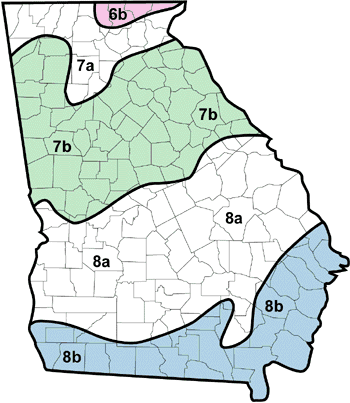
Figure 3.
| Range of average annual minimum temperatures for each zone | |
| Zone | Range in degrees Fahrenheit |
| 6b | -5 to 0 |
| 7a | 0 to 5 |
| 7b | 5 to 10 |
| 8a | 10 to 15 |
| 8b | 15 to 20 |
Habitats:
By understanding a plant’s native habitat and simulating it in the landscape, you are more likely to have success growing the plant. Below are the eight major habitats in Georgia, listed from north to south Georgia:
| North | 1. Cove hardwoods (rich, moist, protected pockets) | |
| 2. Mixed pine/hardwoods ("climax") upland forest along valley slopes and bluffs | ||
| 3. Forest gaps (breaks in the main forest canopy where light reaches the soil surface) | ||
| 4. Rock outcrops (rocky ridge tops and bluffs) | ||
| 5. Meadows (herbaceous pastures or prairies) | ||
| 6. Pine woods (well-drained sands on the Coastal Plain) | ||
| 7. Bottomland forests (streams, low slopes, flood plain and river areas with cypress and hardwoods) | ||
| South | 8. Swamps |
One or more of these eight habitats are home to all of the plants listed in this publication.
Native To:
This refers to the broad geographic area (within the United States) where the plant naturally occurs. In Georgia, there are three geographic regions: Mountains, Piedmont and Coastal Plain. The distribution of plants is sometimes described in terms of these geographic regions.
Comments:
Additional information about the plant, such as its wildlife value or whether cultivars are available.
Medium and Large Trees
In this section:
- American Beech / Fagus grandifolia
- American Holly / Ilex opaca
- American Yellowwood / Cladrastis kentukea
- Bald Cypress / Taxodium distichum
- Black Gum or Tupelo / Nyssa sylvatica
- Black Walnut / Juglans nigra
- Chestnut Oak / Quercus prinus
- Eastern Hemlock / Tsuga canadensis
- Eastern Red Cedar / Juniperus virginiana
- Green Ash / Fraxinus pennsylvanica
- Hickory Species / Carya
- Laurel Oak / Quercus hemisphaerica
- Live Oak / Quercus virginiana
- Loblolly Pine / Pinus taeda
- Longleaf Pine / Pinus palustris
- Northern Red Oak / Quercus rubra
- Palmetto Palm or Cabbage Palm / Sabal palmetto
- Post Oak / Quercus stellata
- Red Maple / Acer rubrum
- River Birch / Betula nigra
- Scarlet Oak / Quercus coccinea
- Shortleaf Pine / Pinus echinata
- Shumard Oak / Quercus shumardii
- Slash Pine / Pinus elliottii
- Southern Magnolia / Magnolia grandiflora
- Southern Red Oak / Quercus falcata
- Spruce Pine / Pinus glabra
- Sugar Maple / Acer saccharum
- Sugarberry / Celtis laevigata
- Swamp Chestnut Oak or Basket Oak / Quercus michauxii
- Sweetgum / Liquidambar styraciflua
- Sycamore / Platanus occidentalis
- Tulip Poplar or Yellow Poplar / Liriodendron tulipifera
- Virginia Pine / Pinus virginiana
- Water Oak / Quercus nigra
- Willow Oak / Quercus phellos
- White Ash / Fraxinus americana
- White Oak / Quercus alba
- White Pine / Pinus strobus
- Yellow Buckeye / Aesculus flava
Red Maple / Acer rubrum
Family: Maple / Aceraceae
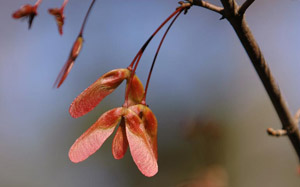
Photo: Wendy VanDyk Evans, Bugwood.org.
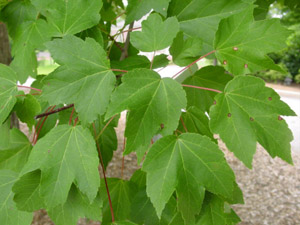
Photo: Gary Wade.
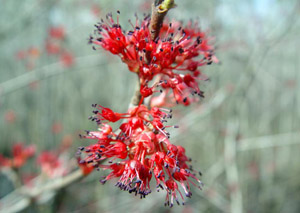
Photo: Wendy VanDyk Evans, Bugwood.org.

Photo: Hugh & Carol Nourse.
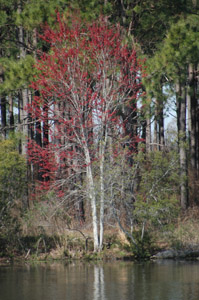
Photo: Chris Evans, Bugwood.org.
Characteristics:
Red Maple is a deciduous tree with medium texture, medium growth rate and an oblong to oval form. It is widely used in landscaping because it has good site tolerance. The bark is smooth and light gray. Clusters of small, red flowers appear in February and are followed by winged fruit in March. Fall color is variable yellow to red.
Landscape Uses:
Use Red Maple as a shade tree in moist soils and full sun. It will adapt to hot, dry locations when irrigated. Red Maple is easy to transplant and tolerates wet soils. Surface roots are common as the plant ages.
Size:
40 to 50 feet tall with a spread of 24 to 35 feet
Zones:
6b, 7a, 7b, 8a, 8b
Habitat:
Low-lying areas and swamps, always in association with water.
Native To:
Canada to the middle of the Florida peninsula and west to Minnesota, Oklahoma and Texas.
Comments:
Because this tree has such a wide growing range, its origin is very important. In other words, don’t plant a Red Maple from New England in Georgia; it may not adapt to the South’s heat and humidity. Some cultivars have been over-used and are subject to diseases.
Sugar Maple / Acer saccharum
Family: Maple / Aceraceae
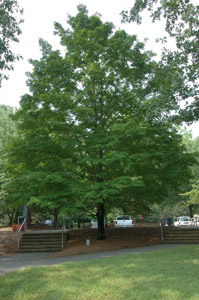
Photo: Ed McDowell.
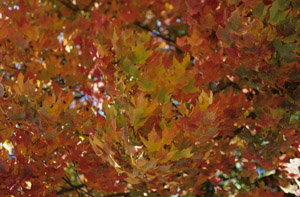
Photo: Gary Wade.
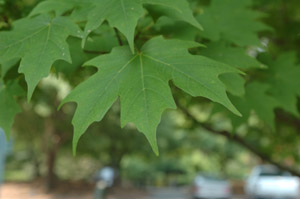
Photo: Ed McDowell.
Characteristics:
Sugar Maple is a deciduous tree having a medium texture, medium to slow growth rate and an upright to oval form. It is best known for its brilliant yellow to orange to red fall color.
Landscape Uses:
Sugar Maple makes a fine specimen, street or shade tree. It needs moist, well-drained, loamy soils and does not tolerate hot, dry sites. It produces dense shade, which may be a problem for sun-loving plants grown beneath its canopy.
Size:
60 to 80 feet tall with a spread of 25 to 40 feet
Zones:
6b, 7a, 7b
Habitat:
Moist, well-drained soils of the north Georgia mountains; found occasionally in the upper Piedmont on fertile north slopes.
Native To:
Eastern Canada to Georgia, Alabama, Mississippi and Texas.
Comments:
No other native tree matches the brilliant yellow, orange and red coloration of Sugar Maple in autumn.
Yellow Buckeye / Aesculus flava
Family: Buckeye / Hippocastanaceae
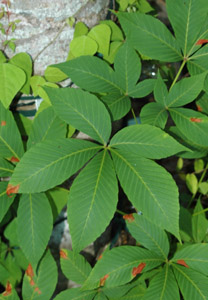
Photo: Chris Evans, Bugwood.org.
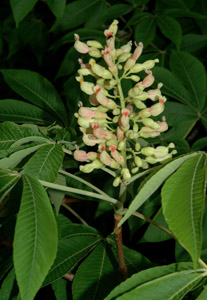
Photo: William M. Ciesla, Bugwood.org.
Characteristics:
Yellow Buckeye is a large tree with an upright to slightly-spreading crown. The compound palmate leaves are dark green above, yellow-green and pubescent beneath in youth and smooth at maturity. The flowers are yellow tinged with green, borne in erect panicles, 6 to 7 inches long by 2 to 3 inches wide from middle to late April. The bark is gray and smooth in youth, becoming scaly or having large gray to brown plates on older trunks.
Landscape Uses:
Yellow Buckeye is a beautiful, fast-growing tree when properly grown. It can be used as a specimen tree since it provides good shade as well as ornamental flowers. It prefers deep, moist, well-drained soils and needs plenty of moisture for optimum growth. Yellow Buckeye is mainly found in extreme north Georgia, but it does occur in a few Piedmont counties. Sosebee Cove Scenic Area near Blairsville, Ga., has several wonderful specimens.
Size:
60 feet high, with a spread of 30 feet
Zones:
7a, 7b
Habitat:
Yellow Buckeye attains its largest size in rich Appalachian soils in coves and in cool slope forests.
Native To:
Pennsylvania, west to Ohio and Illinois, and south to Tennessee, northern Alabama and northern Georgia.
River Birch / Betula nigra
Family: Birch / Betulaceae
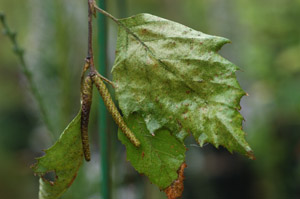
Photo: Ed McDowell.

Photo: Chris Evans, Bugwood.org.

Photo: Hugh & Carol Nourse.
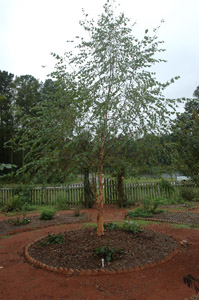
Photo: Ed McDowell.
Characteristics:
River Birch is a deciduous tree having medium texture and a fast growth rate. In youth, it tends to have an oval shape with somewhat drooping branches and is often multi-stemmed. Young trees have a handsome, exfoliating, reddish-brown bark that ages to a dark gray-brown color.
Landscape Uses:
Use River Birch as a shade or specimen tree, particularly in groupings. It looks particularly nice as a multi-stemmed form. A very rapid grower, it is one of the most popular trees for Georgia conditions, adaptable to most landscape sites. It requires adequate moisture during dry weather and prefers acid soils. Iron chlorosis may be a problem in high pH soils. Leaves are occasionally deformed by infestations of aphids. The tree is also affected by webworms.
Zones:
6b, 7a, 7b, 8a, 8b
Habitat:
Moist, well-drained soils along riverbanks and streams, swamps and flood plains.
Native To:
Massachusetts to Florida, west to Minnesota and Kansas.
Comments:
Several cultivars are available. It is an early-succession tree, needing sun for establishment.
Hickory Species
Family: Walnut / Juglandaceae
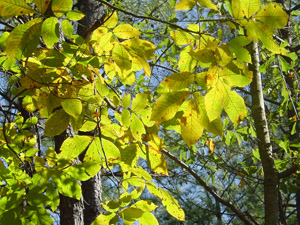 Photo: Gary Wade.
Photo: Gary Wade.Hickories in this publication are treated as a group rather than individually because of their limited use in home landscapes. Property owners should recognize their beauty and value their presence in naturalized areas. Although extremely beautiful and valuable to wildlife, hickories develop a deep taproot and are difficult to transplant. Only recently has the nursery industry developed pots that enable hickories to be grown from seed, which will make them more widely available in the future.
Characteristics:
Hickories are large, deciduous trees, 60 feet or more tall, with alternate, pinnately compound leaves.
Pignut / Carya glabra
Leaves are 8 to 12 inches long with five to seven leaflets. The terminal leaflet is the largest. Both sides of the leaflets are smooth. Bark on young trees is smooth, eventually developing braided ridges.
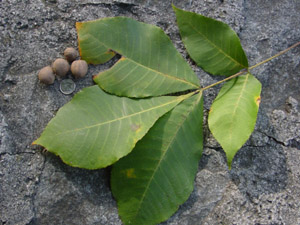 Carya glabra / Pignut Hickory. Photo: Gary Wade.
Carya glabra / Pignut Hickory. Photo: Gary Wade.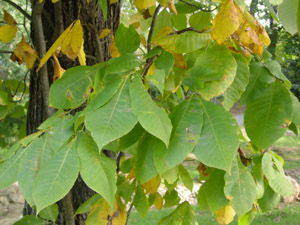 Carya glabra / Pignut Hickory. Photo: Gary Wade.
Carya glabra / Pignut Hickory. Photo: Gary Wade.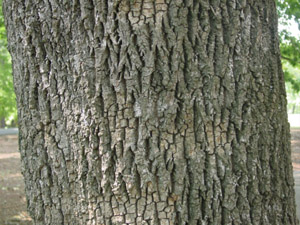 Carya glabra / Pignut Hickory. Photo: Gary Wade.
Carya glabra / Pignut Hickory. Photo: Gary Wade.
Shagbark / Carya ovata
Leaves are 8 to 14 inches long with five leaflets, sometimes seven. The upper surface is smooth, but the lower surface is pubescent. Bark is gray to brownish, exfoliating with age into narrow plates that are detached at both ends.
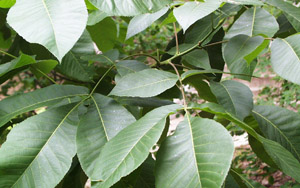 Carya ovata / Shagbark Hickory. Photo: Paul Wray, Bugwood.org.
Carya ovata / Shagbark Hickory. Photo: Paul Wray, Bugwood.org.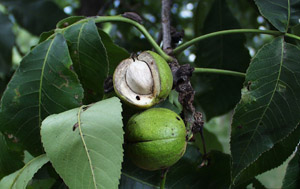 Carya ovata / Shagbark Hickory. Photo: Paul Wray, Bugwood.org.
Carya ovata / Shagbark Hickory. Photo: Paul Wray, Bugwood.org.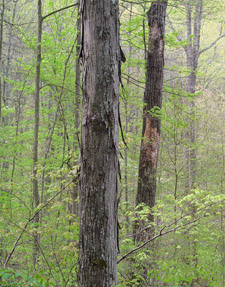 Carya ovata / Shagbark Hickory. Photo: Chris Evans, Bugwood.org.
Carya ovata / Shagbark Hickory. Photo: Chris Evans, Bugwood.org.
Mockernut / Carya tomentosa
Leaves are 8 to 15 inches long with five to seven leaflets. The lower leaf surface is densely pubescent and glandular. Leaves are aromatic when bruised. Bark is dark gray with shallow furrows in youth, becoming deeply furrowed with distinct interlacing ridges with age. On older trees, the bark develops a diamond-like or "expanded metal" pattern.
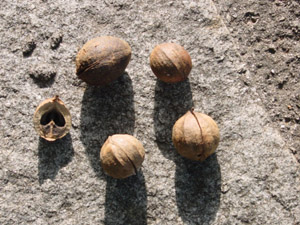 Carya tomentosa / Mockernut Hickory. Photo: Gary Wade.
Carya tomentosa / Mockernut Hickory. Photo: Gary Wade.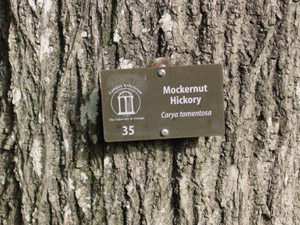 Carya tomentosa / Mockernut Hickory. Photo: Gary Wade.
Carya tomentosa / Mockernut Hickory. Photo: Gary Wade.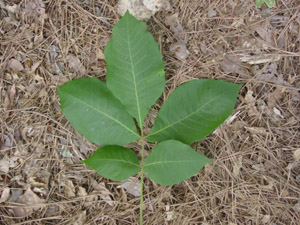 Carya tomentosa / Mockernut Hickory. Photo: Gary Wade.
Carya tomentosa / Mockernut Hickory. Photo: Gary Wade.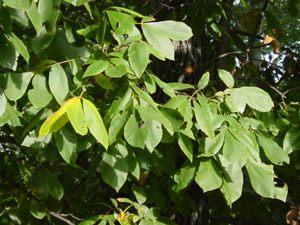 Carya tomentosa / Mockernut Hickory. Photo: Gary Wade.
Carya tomentosa / Mockernut Hickory. Photo: Gary Wade. Carya tomentosa / Mockernut Hickory. Photo: Gary Wade.
Carya tomentosa / Mockernut Hickory. Photo: Gary Wade.
Landscape Uses:
The fall color of all hickories is glowing, luminescent yellow. No other tree matches the brilliant color in the late October to November landscape. All have excellent wood for timber, and their nuts are coveted by wildlife.
Size:
60 to 80 feet tall, with a sparse branching habit.
Zones:
6b (Carya glabra and Carya tomentosa), 7a, 7b, 8a, 8b
Habitat:
Pignut is common on upland sites in association with oaks and other hickories. Shagbark grows best on moist alluvial river and valley soils and on adjacent slopes and ridges. Mockernut is the most common hickory in Georgia, and is found in upland forests.
Native To:
Pignut — Maine to Ontario, south to Florida and west to Louisiana. Shagbark — Quebec to Minnesota, south to Georgia and west to Texas. Mockernut — Massachusetts to Ontario and Nebraska, south to Florida and west to Texas.
Comments:
Hickories have a taproot that penetrates downward 2 to 3 feet the first season, while top growth is just a few inches. They work to establish their root systems for several years before putting on top growth. They are excellent wildlife resources. Seedlings are tolerant of shade and can remain in the shrub layer for years, waiting for a "gap" that provides light.
Sugarberry / Celtis laevigata
Family: Elm / Ulmaceae
Characteristics:
Sugarberry is a deciduous tree with medium texture, medium growth rate and a broad oval to rounded form. Leaves are dark green above and pale green below. They are alternately oblong and lance-shaped, and are 2 to 4 inches long and 1.25 inches wide. The trunk is light gray and smooth, with prominent corky, somewhat warty, ridges. Fruit are brownish-red, about one-third of an inch in diameter. They ripen from September to October
Landscape Uses:
Sugarberry is a long-lived shade tree. It grows best in moist soils in full sun.
Zones:
7a, 7b, 8a, 8b
Habitat:
Moist soils on river flood plains and in alluvial forests, predominately in the lower Piedmont and the Coastal Plain.
Native To:
Southern Indiana and Illinois, south to Texas and Florida.
Comments:
It is the larval host of the hackberry emperor butterfly and is a food source for fall migrating birds.
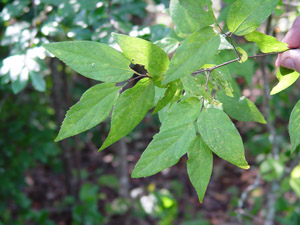 Photo: Chris Evans, Bugwood.org.
Photo: Chris Evans, Bugwood.org.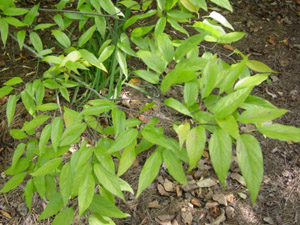 Photo: Gary Wade.
Photo: Gary Wade.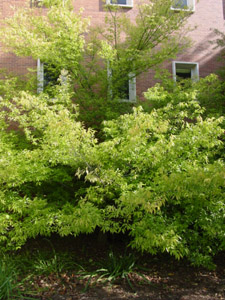 Photo: Gary Wade.
Photo: Gary Wade.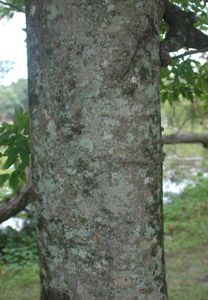 Photo: Chris Evans, Bugwood.org.
Photo: Chris Evans, Bugwood.org.American Yellowwood / Cladrastis kentukea (Syn. Cladrastis lutea)
Family: Pea / Fabaceae
Characteristics:
American Yellowwood is a medium-size, deciduous, flowering tree bearing panicles of fragrant, white, pea-like flowers in late spring that cascade from the ends of the branches. It is spectacular in bloom, but a young tree may not bloom until it is five to eight years old. Mature trees tend to be alternate bearing, with good flowering one year, then few to no flowers the next year. Flowers are followed by brown pods, 2 to 4 inches long, each containing four to six flat, hard-coated seeds. Leaves are pinnately compound, each with nine to 11 leaflets. Fall color is golden yellow. The tree gets its name from the color of its heartwood, which is bright yellow.
Landscape Uses:
A wonderful specimen tree for the landscape. Breathtaking in bloom.
Size:
30 to 50 feet tall and 30 feet wide at maturity
Zones:
6b, 7a, 7b, 8a
Habitat:
Rich soils on hill slopes or along ravines near streams. It prefers a more basic soil.
Native To:
North Carolina to Tennessee and Kentucky, south to Georgia and west to Oklahoma.
Comments:
A 1999 Georgia Gold Medal Winner.
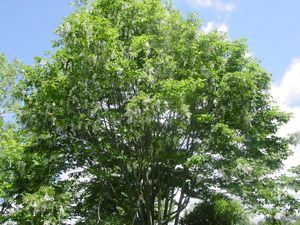 Photo: Gary Wade.
Photo: Gary Wade.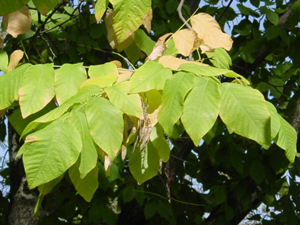 Photo: Gary Wade.
Photo: Gary Wade.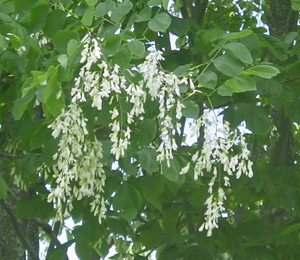 Photo: Gary Wade.
Photo: Gary Wade.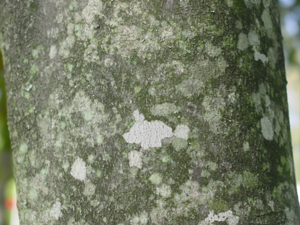 Photo: Gary Wade.
Photo: Gary Wade.American Beech / Fagus grandifolia
Family: Beech / Fagaceae
Characteristics:
American Beech is a deciduous tree with medium texture and medium to slow growth rate. It has smooth, bluish-gray bark and golden bronze fall color. Dead leaves persist on the tree throughout the winter. Fruit, called beech nuts, are yellowish-brown, unevenly triangular and enclosed in a spiny bur less than 1 inch long. Fruit production tends to be heavy every two to three years.
Landscape Uses:
Use American Beech as a shade or specimen tree. It prefers moist, acidic, well-drained soils and full sun to partial shade. It is shallow-rooted and not for dry sites.
Size:
50 to 80 feet tall with a canopy width of 40 to 60 feet
Zones:
6b, 7a, 7b, 8a, 8b
Habitat:
Moist, rich soils of uplands and well-drained lowlands; eastern United States.
Native To:
New Brunswick to Ontario, south to Florida and west to Texas.
Comments:
American Beech produces deep shade that discourages other plants from growing under its canopy.
 Photo: Hugh & Carol Nourse.
Photo: Hugh & Carol Nourse.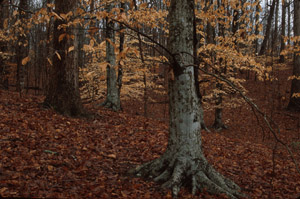 Photo: Hugh & Carol Nourse.
Photo: Hugh & Carol Nourse.
 Photo: Gary Wade.
Photo: Gary Wade.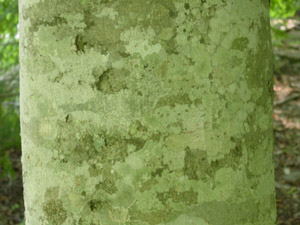 Photo: Gary Wade.
Photo: Gary Wade.White Ash / Fraxinus americana
Family: Olive / Oleaceae
Characteristics:
White Ash is a large, handsome deciduous tree with medium to coarse texture and medium growth rate. It is dioecious (having male and female flowers borne on separate trees). Flowers are borne in panicles before the leaves emerge in April. Leaves are opposite, pinnately compound, 8 to 15 inches long with five to nine leaflets (usually seven). The leaves have a drooping quality and are dark green above and light green below. The bark is ashy-gray to gray-brown with interlacing diamond-shaped ridges. Fall color ranges from yellow to deep purple or maroon.
Landscape Uses:
Use White Ash as a specimen or street tree for large areas. It maintains a central leader in youth with an even distribution of branches. It transplants easily and prefers moist, well-drained soils and full sun.
Size:
50 to 80 feet tall, with a similar spread
Zone:
6b, 7a, 7b, 8a, 8b
Habitat:
Deep, moist, well-drained forest soils. It does not like harsh conditions.
Native To:
Nova Scotia to Minnesota, south to Florida and west to Texas.
Comments:
White Ash is subject to several pests and diseases. It is difficult to distinguish from Green Ash (Fraxinus pennsylvanica).
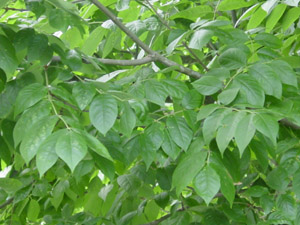 Photo: Gary Wade.
Photo: Gary Wade.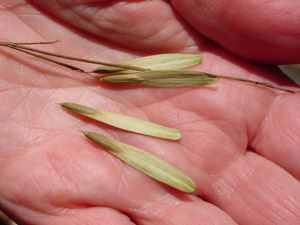 Photo: Gary Wade.
Photo: Gary Wade.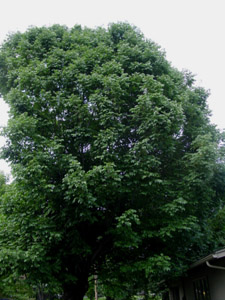 Photo: Gary Wade.
Photo: Gary Wade.Green Ash / Fraxinus pennsylvanica
Family: Olive / Oleaceae
Characteristics:
Green Ash is a deciduous, fast-growing tree with an upright, spreading habit. It is dioecious (having male and female flowers borne on separate trees). It develops three to five main branches and many coarse, twiggy branchlets that bend downward and then up at the ends. Leaves are opposite, pinnately compound and 12 inches long with five to nine leaflets. They are lustrous dark green above and pubescent underneath. The yellow fall color is inconsistent, especially on seed-grown plants.
Landscape Uses:
Green Ash is a popular shade tree because it transplants readily and grows in a wide variety of soils and site conditions. It is subject to a variety of insect and disease problems.
Size:
50 to 60 feet tall and 25 to 30 feet wide
Zones:
6b, 7a, 7b, 8a, 8b
Habitat:
Flood plains, wetlands and stream banks.
Native To:
Nova Scotia to Manitoba, south to northern Florida and west to Texas.
Comments:
Cultivars are available. Green Ash and White Ash (Fraxinus americana) look identical except for their seeds. The White Ash’s samara wing extends less than halfway down the cylindrical fruiting body, and Green Ash’s samara wing extends halfway or more down the cylindrical fruiting body. Green Ash is an early succession tree and needs sun to become established.
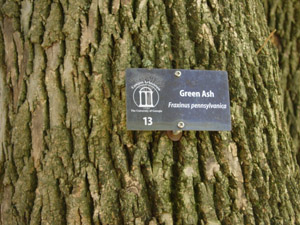 Photo: Gary Wade.
Photo: Gary Wade.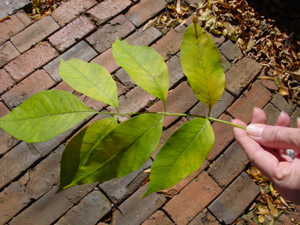 Photo: Gary Wade.
Photo: Gary Wade.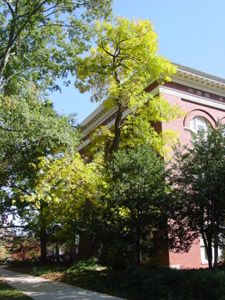 Photo: Gary Wade.
Photo: Gary Wade.American Holly / Ilex opaca
Family: Holly / Aquifoliaceae
Characteristics:
American Holly is a broadleaf evergreen tree with medium-coarse texture and a moderate growth rate. Distinctly pyramidal when young, it becomes more open and irregular with age. Leaves are alternate evergreen, 1.5 to 4 inches long and half as wide, with spiny teeth along their margins. Bright red fruit persist throughout winter and are eaten by birds. Native seedlings are appropriate for restoration projects.
Landscape Uses:
Use American Holly for screening or as a specimen tree. It prefers deep, fertile soils with adequate moisture and partial shade. It will adapt to full sun.
Size:
20 to 50 feet tall and 15 to 30 feet wide
Zones:
6b, 7a, 7b, 8a, 8b
Habitat:
Grows on moist sites, flood plains and lower slopes. It can be found in mixed hardwood forests and occasionally on dry, sandy sites in south Georgia.
Native To:
Massachusetts to Florida and west to Missouri and Texas.
Comments:
The foliage is traditionally cut (along with berries) for Christmas decorations; it is sometimes used as an outdoor Christmas tree. Fruit are enjoyed by cedar waxwings, cardinals and other birds. Fruit are borne on female trees only (male and female trees are separate).
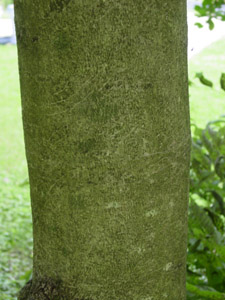 Photo: Gary Wade.
Photo: Gary Wade.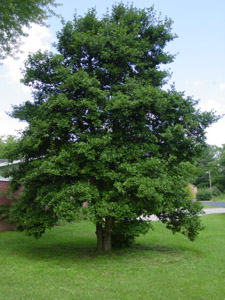 Photo: Gary Wade.
Photo: Gary Wade.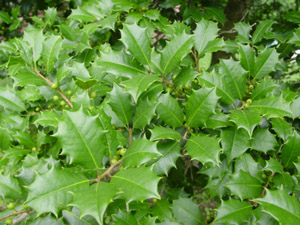 Photo: Gary Wade.
Photo: Gary Wade.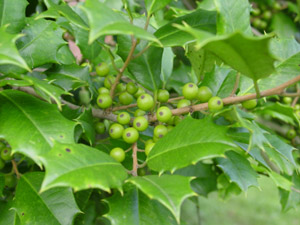 Photo: Gary Wade.
Photo: Gary Wade.Black Walnut / Juglans nigra
Family: Walnut / Juglandaceae
Characteristics:
Black Walnut is a large tree with a fine texture and loose, open form. It often develops a trunk that is devoid of branches for several feet from the ground. Its wood is valuable for furniture and veneers because of its beautiful grain. Leaves are alternate, pinnately compound, 12 to 24 inches long, with 15 to 23 leaflets. The terminal leaflet is often missing. Fruit are hard nuts encased in a green husk.
Landscape Uses:
Black Walnut is a fine shade tree for stream banks and flood plains. It prefers moist soils. Avoid planting it next to parking lots because falling fruit can dent vehicles.
Size:
75 to 100 feet tall with a canopy width of 50 to 75 feet
Zones:
6b, 7a, 7b, 8a, 8b
Habitat:
Moist, well-drained soils in the wild. It was often planted around old home sites.
Native To:
Massachusetts to Florida, and west to Minnesota and Texas.
Comments:
Black Walnut produces the chemical juglone in its roots and leaves, which kills or inhibits growth of other plants nearby. It is a high-value wildlife tree.
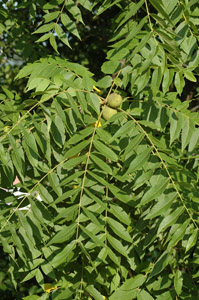 Photo: Steve Sanchez.
Photo: Steve Sanchez.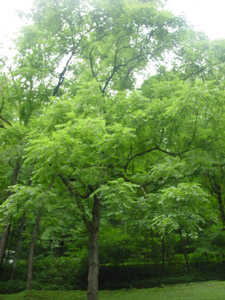 Photo: Gary Wade.
Photo: Gary Wade.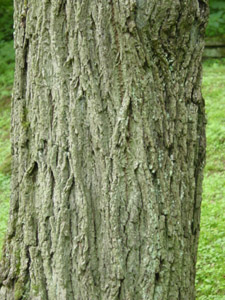 Photo: Gary Wade.
Photo: Gary Wade.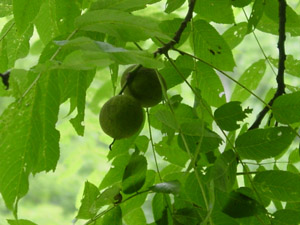 Photo: Gary Wade.
Photo: Gary Wade.Eastern Red Cedar / Juniperus virginiana
Family: Juniper / Cupressaceae
Characteristics:
Eastern Red Cedar is an aromatic evergreen tree with a conical to columnar shaped crown. It has a medium growth rate and texture. Handsome grayish- to reddish-brown bark exfoliates into long strips. Leaves are scale-like, closely pressed and overlapping. Summer color is medium green and winter color is dull green. There are male and female trees.
Landscape Uses:
Eastern Red Cedar is an excellent specimen tree. It also is useful for windbreaks, hedges, shelter belts and topiary. It is tolerant of adverse conditions and poor soils as well as a wide range in pH. It prefers a sunny location and moist loam on well-drained subsoil. It is not shade tolerant and does not like growing under a heavy overstory.
Size:
40 to 50 feet tall and 8 to 20 feet wide. Size is extremely variable over its extensive native range.
Zones:
7a, 7b, 8a, 8b
Habitat:
Dry, upland, rocky soils, particularly calcareous soils. It also is found on moist flood plains, edges of swamps, in abandoned fields and along fence rows.
Native To:
East and central North America, east of the Rocky Mountains.
Comments:
Many cultivars have been selected for ornamental use in residential and commercial landscapes. The mature berry-like cones are eaten by many kinds of mammals and birds, including the cedar waxwing. It provides refuge and cover for birds in inclement winter weather. Majestic specimens are found in old cemeteries.
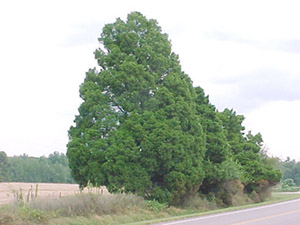 Photo: Gary Wade.
Photo: Gary Wade. Photo: Gary Wade.
Photo: Gary Wade.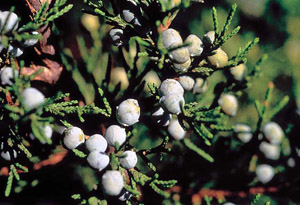 Photo: USDA-NRCS PLANTS Database.
Photo: USDA-NRCS PLANTS Database.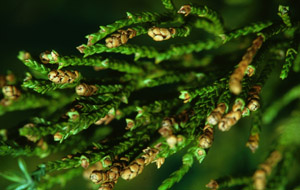 Photo: USDA Forest Service, Bugwood.org.
Photo: USDA Forest Service, Bugwood.org.
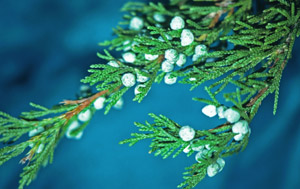 Photo: USDA Forest Service, Bugwood.org.
Photo: USDA Forest Service, Bugwood.org.Sweetgum / Liquidambar styraciflua
Family: Witchhazel / Hamamelidaceae
Characteristics:
Sweetgum is a deciduous tree with a medium texture and a medium to fast growth rate. Form is oval to pyramidal when young, developing into a broad-headed tree with age. Fall color ranges from yellow to orange or purple. Leaves have five to seven star-shaped lobes and are a lustrous green in summer. The foliage is aromatic when crushed. Fruit are round, spiny balls on 2- to 3-inch pedicels.
Landscape Uses:
Use Sweetgum as a shade or specimen tree. It is fast-growing and moderately easy to establish, especially when young. The spiny fruit can present a maintenance problem. It prefers moist, rich, acid soils and has moderate drought tolerance.
Size:
80 to 100 feet tall with a spread of 40 to 50 feet
Zones:
6b, 7a, 7b, 8a, 8b
Habitat:
Flood plains on moist soils of valleys and lower slopes.
Native To:
Connecticut to Illinois, south to Florida and west to Texas.
Comments:
Sweetgum is an early succession plant. It is a prolific seeder and quickly invades cut-over hardwood stands and pine plantations on upland sites. It also sprouts profusely from stumps and lateral roots. Birds like the seeds.
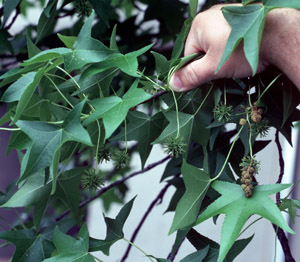 Photo: Gary Wade.
Photo: Gary Wade.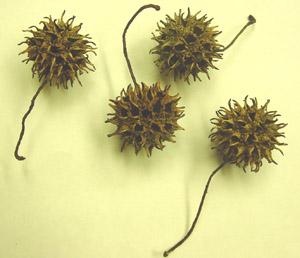 Photo: Gary Wade.
Photo: Gary Wade.
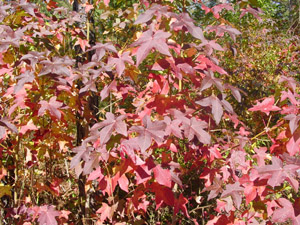 Photo: Gary Wade.
Photo: Gary Wade.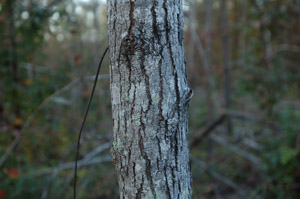 Photo: Ed McDowell.
Photo: Ed McDowell.
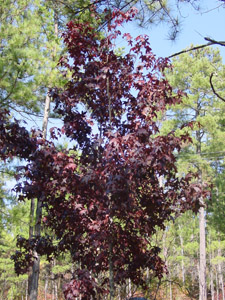 Photo: Gary Wade.
Photo: Gary Wade.Tulip Poplar or Yellow Poplar / Liriodendron tulipifera
Family: Magnolia / Magnoliaceae
Characteristics:
Tulip Poplar, also called Yellow Poplar, is a deciduous tree with coarse texture and a medium to fast growth rate. It is pyramidal in form when young, becoming oval-rounded with age. It has a fleshy root system characteristic of the magnolia family. Leaves are tulip-shaped with four lobes. Fragrant orange-yellow tulip-like flowers appear from April to May.
Landscape Uses:
Tulip Poplar is a fast-growing shade or specimen tree. It prefers moist, well-drained soils and full sun. Avoid planting it in open, exposed sites and dry soils. Allow plenty of room for development.
Size:
80 to 100 feet tall and 30 to 40 feet wide
Zones:
6b, 7a, 7b, 8a, 8b
Habitat:
Moist, well-drained soils.
Native To:
Massachusetts to Wisconsin, south to Florida and west to Mississippi.
Comments:
Tulip Poplar is an early succession tree and is intolerant of shade. It needs full sun to become established and grow well. It is a good wildlife tree.
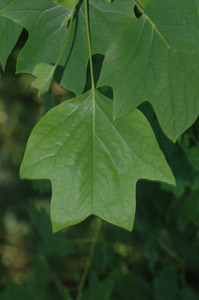 Photo: Chris Evans, Bugwood.org.
Photo: Chris Evans, Bugwood.org.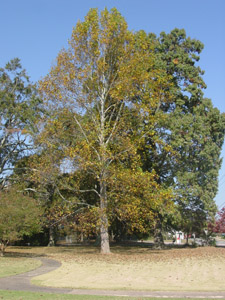 Photo: Gary Wade.
Photo: Gary Wade.
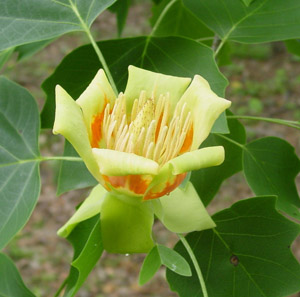 Photo: Gary Wade.
Photo: Gary Wade.Southern Magnolia / Magnolia grandiflora
Family: Magnolia / Magnoliaceae
Characteristics:
Southern Magnolia is a broadleaf evergreen flowering tree with coarse texture and a medium to slow growth rate. It is pyramidal when young, then develops an oval shape at maturity. Foliage is dark green and glossy. Large, fragrant, showy white flowers appear in early summer. Fruit consist of cone-like aggregates of follicles from which bright red, shiny seeds are suspended by slender elastic threads.
Landscape Uses:
Use Southern Magnolia as a specimen plant or for screening. Plant it in moist soils and full sun or light shade. It does not tolerate hot, dry sites. Branches are best left on ground level because of the leaf litter problem and the fleshy surface root system.
Size:
60 to 80 feet tall with a canopy spread of 40 to 50 feet
Zones:
7a, 7b, 8a, 8b
Habitat:
Moist hardwood forests and wet swampy areas in the Coastal Plain.
Native To:
North Carolina to Florida, west to Arkansas and Texas.
Comments:
Many cultivars are available. Seeds are relished by birds and other wildlife. Suckers may need to be pruned from root or branch sprouts.
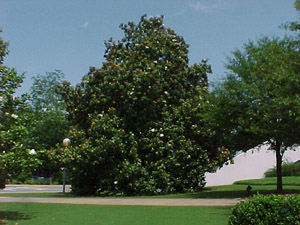 Photo: Gary Wade.
Photo: Gary Wade.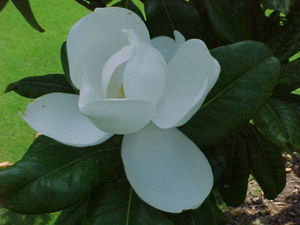 Photo: Gary Wade.
Photo: Gary Wade.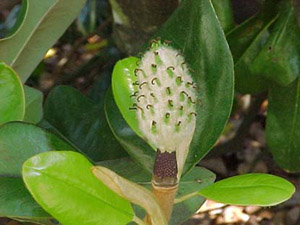 Photo: Gary Wade.
Photo: Gary Wade.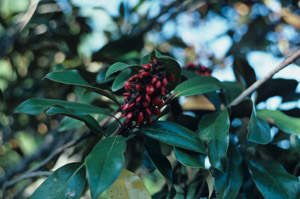 Photo: Gary Wade.
Photo: Gary Wade.Black Gum or Tupelo / Nyssa sylvatica
Family: Nyssa / Nyssaceae
Characteristics:
Black Gum, or Tupelo, is a deciduous tree having medium texture and a medium growth rate. Form is narrow upright, pyramidal, with strong horizontal branching. It is dioecious, with male and female flowers on separate trees. Female trees bear tiny, greenish-yellow flowers during leaf development in April or May. Fruit appear only on female trees and are bluish-black drupes about 0.5 inches long, borne two to three per stalk.
Landscape Uses:
Grow Black Gum as a specimen tree. It is difficult to transplant and is best planted from a container-grown plant. It prefers moist, fertile soils but adapts to a wide range of conditions. Leaves color early in the fall and are showy crimson-red.
Size:
70 to 80 feet tall and 40 to 50 feet wide
Zones:
6b, 7a, 7b, 8a, 8b
Habitat:
Moist soils of valleys and uplands in hardwood and pine forests.
Native To:
Maine to Michigan, south to Florida and west to Texas.
Comments:
This beautiful tree is becoming more available in the nursery trade. Another species, Swamp Tupelo (Nyssa biflora), is commonly found in south Georgia. Wildlife relish the seeds.
 Photo: Steve Sanchez.
Photo: Steve Sanchez.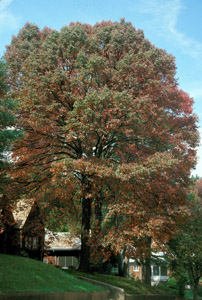 Photo: Steve Sanchez.
Photo: Steve Sanchez. CE.JPG) Photo: Chris Evans, Bugwood.org.
Photo: Chris Evans, Bugwood.org.Shortleaf Pine / Pinus echinata
Family: Pine / Pinaceae
Characteristics:
Shortleaf Pine is a fast-growing, medium to tall tree. It is pyramidal in youth, developing a long, clear trunk with a small, open pyramidal crown as it ages. The dark bluish-green needles are 3 to 5 inches long in fascicles (bundles) of two or three, sometimes on the same tree. Shortleaf Pine bark is nearly black when trees are young, aging to reddish-brown with many small resin pockets scattered through its corky layers.
Landscape Uses:
Shortleaf Pine has a huge taproot and is harder to transplant than other pines.
Size:
80 to 100 feet tall, but more likely 50 to 60 feet under most landscape conditions.
Zones:
7a, 7b, 8a, 8b
Habitat:
Open upland areas including grassy or abandoned agricultural land.
Native To:
Central New Jersey west to southern Missouri, south to Texas and into Northern Florida. Absent from the upper slopes of the Appalachian Mountains.
Comments:
It is one of the most abundant pines in Georgia, second only to Loblolly. Shortleaf is subject to pine bark beetles and pine-tip moths, as are most pine species, as well as to littleleaf disease. The fruit is a prickly cone 1.5 to 2.5 inches long.
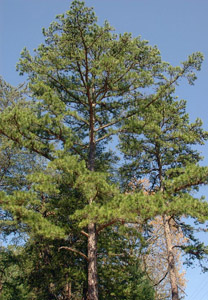 Photo: Chris Evans, Bugwood.org.
Photo: Chris Evans, Bugwood.org.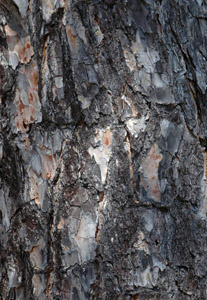 Photo: Chris Evans, Bugwood.org.
Photo: Chris Evans, Bugwood.org.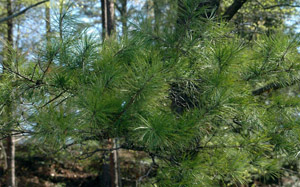 Photo: Chris Evans, Bugwood.org.
Photo: Chris Evans, Bugwood.org.
Slash Pine / Pinus elliottii
Family: Pine / Pinaceae
Characteristics:
Slash Pine is a large tree often planted as an ornamental because it grows fast and has dense lustrous-green foliage. Foliage consists of two and three needles arranged in fascicles (bundles). Loblolly and Longleaf Pine, in contrast, both have three needles per fascicle.
Landscape Uses:
Use Slash Pine as a specimen tree or for windbreaks or screening. Its heavy needle crop and brittle branches make it susceptible to ice damage when planted outside the Coastal Plain. It prefers full sun and moist soils.
Size:
60 to 100 feet tall and 20 to 40 feet wide
Zones:
8a, 8b
Habitat:
Moist to wet, sandy, poorly-drained soils bordering shallow ponds and swamps. It occurs in maritime forests and wet flatlands, where it sometimes is the primary canopy species.
Native To:
The Coastal Plain from South Carolina to Florida, west to Louisiana.
Comments:
Slash Pine is planted widely for timber production in and out of its natural range and habitat. All pines are intolerant of shade and need sun to establish and thrive.
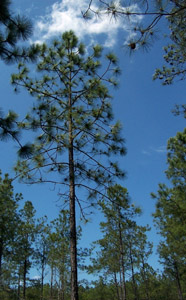 Photo: David Stephens, Bugwood.org.
Photo: David Stephens, Bugwood.org.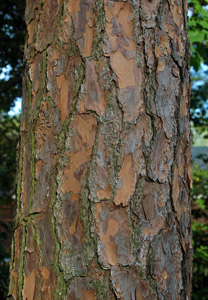 Photo: Chris Evans, Bugwood.org.
Photo: Chris Evans, Bugwood.org.
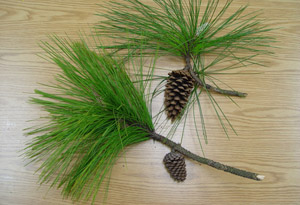 Photo: David McManus.
Photo: David McManus.Spruce Pine / Pinus glabra
Family: Pine / Pinaceae
Characteristics:
Spruce Pine is an evergreen tree with a medium-fine texture and a medium to fast growth rate. Needles are dark green, two per fascicle, spirally twisted, and 2 to 4 inches long. Cones are brown, up to 3.75 inches long, with minute prickles on the scales. They may persist two to four years on the plant. Young trees have a dense, broadly pyramidal form, becoming more open and irregular with age. Bark is dark, brownish-gray and attractive.
Landscape Uses:
A dense canopy, slow early growth and attractive yellow-green foliage make Spruce Pine suitable for landscaping. Use it for a windbreak, screening or as a specimen tree. It performs best in moist, fertile soils, but it has been observed growing satisfactorily on dry sites and heavy soils. It requires full sun for best growth
Size:
50 to 60 feet tall and 40 to 50 feet wide
Zones:
8a, 8b
Habitat:
Moist alluvial flood plains or hammocks with mixed hardwoods in the lower Coastal Plain.
Native To:
South Carolina to northern Florida and west to Louisiana.
Comments:
A good wildlife food source.
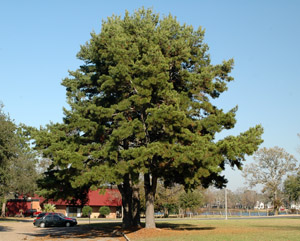 Photo: Steve Sanchez.
Photo: Steve Sanchez.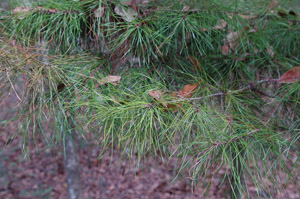 Photo: Chris Evans, Bugwood.org.
Photo: Chris Evans, Bugwood.org.
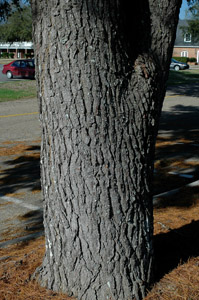 Photo: Steve Sanchez.
Photo: Steve Sanchez.Longleaf Pine / Pinus palustris
Family: Pine / Pinaceae
Characteristics:
Longleaf Pine is an evergreen tree with needles approximately 10 inches long, grouped in bundles of three. They persist on the tree for two seasons. Its long needles, large cones and sparse branching pattern make it the most distinctive pine of the Coastal Plain. Young seedlings have a unique grass-like appearance, which may last two to seven years or more because the tree first uses its energy to put down a deep tap root. Once the tap root is developed, it provides the resources for rapid top growth, often exceeding 3 feet in a year. It is a long-lived pine, often growing for more than 300 years. It has adapted to frequent ground fires that were common in the longleaf-wiregrass ecosystem that once covered 90 million acres of the southeastern Coastal Plain.
Landscape Uses:
Longleaf Pine is a canopy tree and is best used as a specimen. It provides filtered shade for other plants, like azaleas and dogwoods. It thrives in the well-drained, sandy soils of the Coastal Plain, but it will adapt to Piedmont clay. It is best planted as a seedling and is attractive in its grass-like stage.
Size:
This long-lived giant may reach heights of 80 to 100 feet, with a trunk diameter of 2 to 2.5 feet.
Zones:
7a, 7b, 8a, 8b
Habitat:
Well-drained, sandy, acidic soils in the Coastal Plain up to the fall line
Native To:
Southeastern Virginia to Florida, west to Texas. There is a race of mountain longleaf growing on ridges from Paulding County, Ga., to Rome, Ga., and into the Talladega National Forest in Alabama.
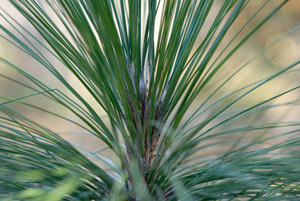 Photo: Ed McDowell.
Photo: Ed McDowell.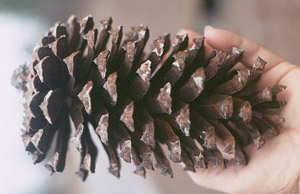 Photo: Dennis Girard.
Photo: Dennis Girard.
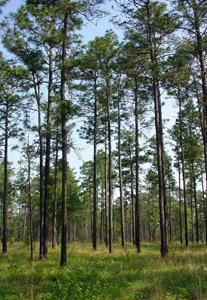 Photo: Chuck Bargeron, Bugwood.org.
Photo: Chuck Bargeron, Bugwood.org.White Pine / Pinus strobus
Family: Pine / Pinaceae
Characteristics:
White Pine is an evergreen tree having medium-fine texture and a medium-fast growth rate. It has soft, bluish-green needles 2 to 3 inches long, five per fascicle. They remain on the tree for two years. The mature bark is dark gray and deeply furrowed. Cones are 3 to 8 inches long and 1.5 inches wide, often curved.
Landscape Uses:
Use White Pine for a windbreak, screening or as a specimen tree. It has a pyramidal form when young and becomes more spreading with age. It is a graceful tree. It is easy to transplant and prefers moist, fertile, well-drained soils. It is a mountain species, so it may struggle and be short-lived in the lower Piedmont and Coastal Plain. Expect it to live only 10 to 15 years when planted outside its natural range.
Size:
50 to 60 feet tall and 30 to 40 feet wide
Zones:
6b, 7a, 7b
Habitat:
Variable, from dry, rocky ridges to wet, poorly-drained areas.
Native To:
Newfoundland to Manitoba, south to Illinois and Iowa and southeast to Georgia.
 CE.JPG) Photo: Chris Evans, Bugwood.org.
Photo: Chris Evans, Bugwood.org.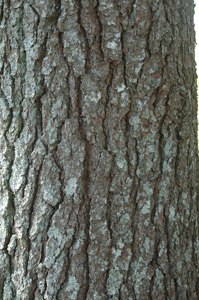 Photo: Chris Evans, Bugwood.org.
Photo: Chris Evans, Bugwood.org. CE.JPG) Photo: Chris Evans, Bugwood.org.
Photo: Chris Evans, Bugwood.org.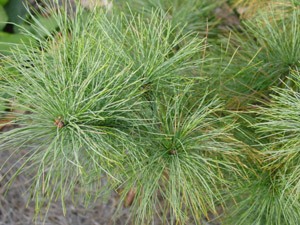 Photo: Gary Wade.
Photo: Gary Wade.
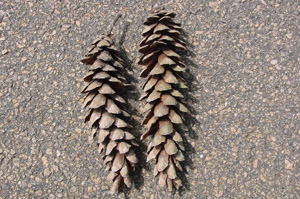 Photo: Gary Wade.
Photo: Gary Wade.Loblolly Pine / Pinus taeda
Family: Pine / Pinaceae
Characteristics:
Loblolly pine is an evergreen tree with medium texture and a fast growth rate. Form is upright, broad and oval with irregular horizontal branching. Needles are sometimes twisted, 6 to 10 inches long, in fascicles of two or three. They persist on the tree for up to four years. Cones are 3 to 6 inches long, in clusters of three to five. There are sharp spines on the tips of the cone scales. It is one of the most widespread and valuable pines of the southeast. In Georgia, it comprises most of the timber harvested in the Piedmont.
Landscape Uses:
Use Loblolly as a specimen tree or for screening. It provides lightly-filtered shade, so other plants will grow beneath it. Plant it in full sun on well-drained soils. It tolerates poor sites.
Size:
80 to 100 feet tall with a spread of 20 to 30 feet
Zones:
7a, 7b, 8a, 8b
Habitat:
River bottoms, abandoned farmland. This is a pioneer species.
Native To:
Southern New Jersey to Florida, west to eastern Texas and Oklahoma.
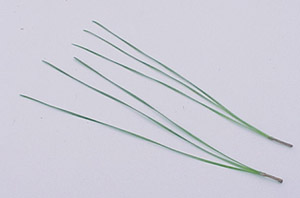 Photo: Gary Wade.
Photo: Gary Wade.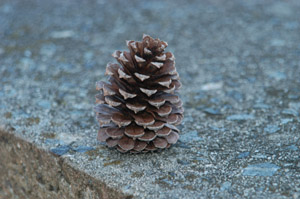 Photo: Ed McDowell.
Photo: Ed McDowell.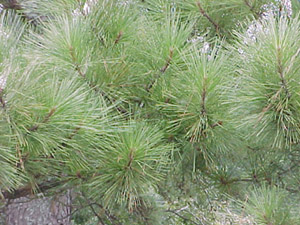 Photo: Gary Wade.
Photo: Gary Wade.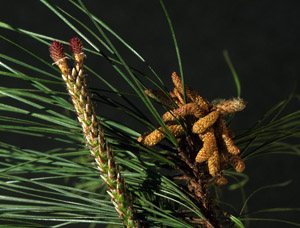 Photo: Hugh & Carol Nourse.
Photo: Hugh & Carol Nourse.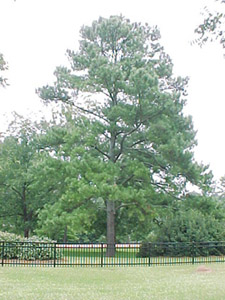 Photo: Gary Wade.
Photo: Gary Wade.Virginia Pine / Pinus virginiana
Family: Pine / Pinaceae
Characteristics:
Virginia Pine is a medium-size tree with medium texture and rapid growth rate. It is somewhat scrubby in appearance because of numerous branches that may extend to the ground. Its evergreen needles, arranged two per fascicle, are 2 to 3 inches long and persist for three to four seasons. Virginia Pine is easily confused with Shortleaf Pine, but it can be distinguished by its twisted needles. The cones are up to 3 inches long and approximately 1 inch wide, grouped in clusters of four. The cone scales have sharp points.
Landscape Uses:
Virginia Pine is frequently used for screening or windbreaks. It also has been widely cultivated in the southeast for Christmas trees because of its dense branching habit, fast growth and soil adaptability. Like other pines, it needs full sun for best growth.
Size:
40 to 70 feet tall
Zones:
6b, 7a, 7b, 8a
Habitat:
A wide range of sites, including well-drained upland slopes, heavy clays and dry, rocky ridges.
Native To:
New York, southwest through the Appalachians and the Ohio valley, to central Alabama and east to Georgia.
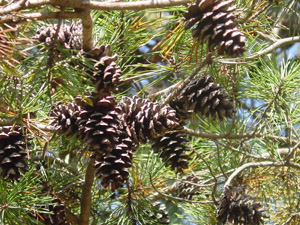 Photo: Gary Wade.
Photo: Gary Wade.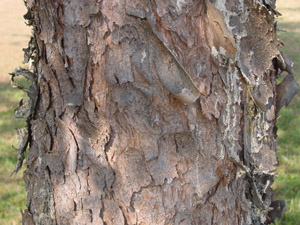 Photo: Gary Wade.
Photo: Gary Wade.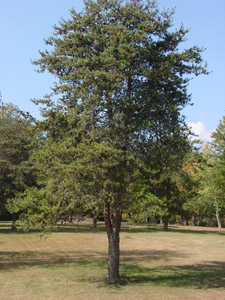 Photo: Gary Wade.
Photo: Gary Wade.Sycamore / Platanus occidentalis
Family: Sycamore / Platanaceae
Characteristics:
Sycamore is a deciduous tree with coarse texture and a rapid growth rate. Its most striking characteristic is the exfoliating, dark brown to gray bark, which flakes off to expose a white inner bark.
Landscape Uses:
Use Sycamore as a shade or large specimen tree. It prefers deep, moist, fertile soils. It transplants easily and is moderately drought tolerant. It suffers from some disease and insect problems and is always dropping leaves and branches. Still, it is a rapid grower and a widely-used shade tree.
Size:
80 to 100 feet tall with a spread of 40 to 50 feet
Zones:
6b, 7a, 7b, 8a, 8b
Habitat:
Wet soils along stream banks, on flood plains and at edges of lakes and swamps.
Native To:
Maine to Ontario and Minnesota, south to Florida and west to Texas.
Comments:
In natural areas, especially along streams, it is an impressive landscape plant with its white bark defining Piedmont streams.
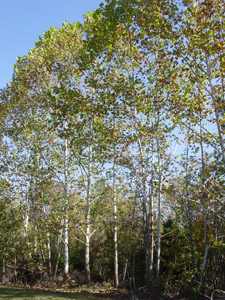 Photo: Gary Wade.
Photo: Gary Wade.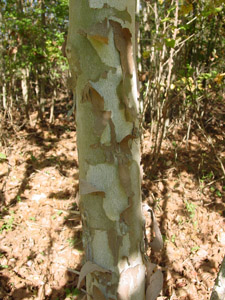 Photo: Gary Wade.
Photo: Gary Wade.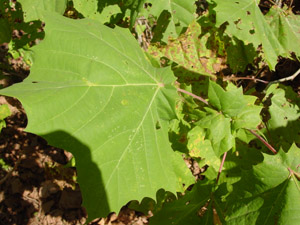 Photo: Gary Wade.
Photo: Gary Wade.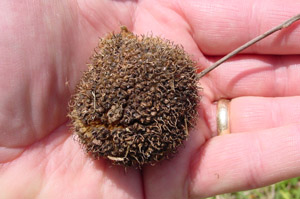 Photo: Gary Wade.
Photo: Gary Wade.
Oaks
The genus Quercus is divided into two groups, or subgenera. White oaks are in subgenus Leucobalanus. They have leaves lacking bristles on their lobes or leaf apexes, and their acorns require one growing season to mature. Red Oaks are in the subgenus Erythrobalanus. This group has leaves with bristles at the tips of the lobes and the leaf apexes. The acorns require two growing seasons (biennial) to mature. These are just two of the most obvious differences in these two sub-genera.
White Oak / Quercus alba
White Oak Subgenus: Leucobalanus
Family: Beech / Fagaceae
Characteristics:
White Oak is a deciduous tree with medium-coarse texture and a slow to medium growth rate. Form is oval to upright, rounded, with wide-spreading branches. Foliage is blue-green in summer, turning wine-red in fall.
Landscape Uses:
White Oak is a beautiful, stately shade tree. It does best when planted in moist, acid, well-drained soils and full sun. It is best planted as a young tree. Avoid root damage or soil compaction on established trees. There are some minor disease and insect problems, but they are not life-threatening.
Size:
60 to 100 feet tall with a spread of 40 to 60 feet
Zones:
6b, 7a, 7b, 8a, 8b
Habitat:
Moist, well-drained uplands and rich, moist slopes.
Native To:
Maine to Minnesota, south to Florida, west to Texas.
Comments:
Probably the most common oak tree in north Georgia, but less common in south Georgia.
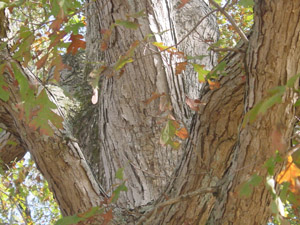 Photo: Gary Wade.
Photo: Gary Wade.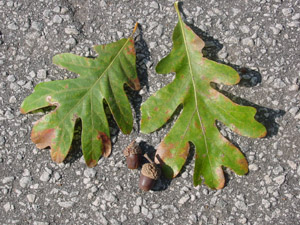 Photo: Gary Wade.
Photo: Gary Wade.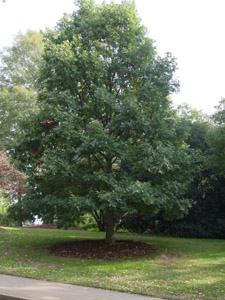 Photo: Gary Wade.
Photo: Gary Wade.Scarlet Oak / Quercus coccinea
Red Oak Subgenus: Erythrobalanus
Family: Beech / Fagaceae
Characteristics:
Scarlet Oak is a deciduous tree having medium texture and medium to fast growth rate. It is pyramidal to rounded in form. Foliage is glossy green in summer and brilliant scarlet-red in fall.
Landscape Uses:
Use Scarlet Oak as a shade or specimen tree, especially on dry sites and ridge tops. It is difficult to transplant from the wild, so it is best to plant a container-grown tree. It prefers well-drained soils and full sun. It has good drought tolerance once established.
Size:
60 to 80 feet tall with a spread of 50 to 60 feet
Zones:
6b, 7a, 7b, 8a
Habitat:
Poor, dry uplands and slopes.
Native To:
Maine to Minnesota, south to Florida, west to Missouri.
Comments:
Acorns are an important wildlife food. This tree often survives forest fires.
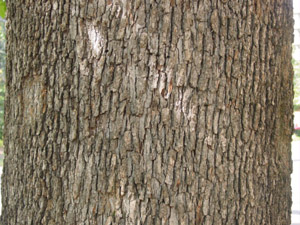 Photo: Gary Wade.
Photo: Gary Wade.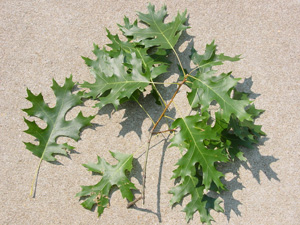 Photo: Gary Wade.
Photo: Gary Wade.
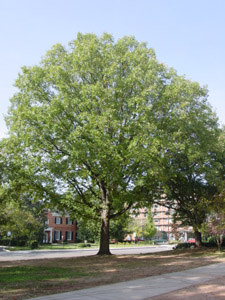 Photo: Gary Wade.
Photo: Gary Wade.Southern Red Oak / Quercus falcata
Red Oak Subgenus: Erythrobalanus
Family: Beech / Fagaceae
Characteristics:
Southern Red Oak is a deciduous, fast-growing tree with a short trunk and a rounded crown. Leaves have a variable lobe pattern with three to five bristle-tipped lobes; the upper leaf surface is shiny green and the lower leaf surface is pubescent and yellow-gray. Bark is dark brown to black, thick, and deeply fissured, becoming ridged and rough near the base. The inner bark is orange.
Landscape Uses:
Use Southern Red Oak as a shade or specimen tree. It grows well on dry sites and is fairly long-lived.
Size:
80+ feet wide and 50+ feet tall.
Zones:
6b, 7a, 7b, 8a, 8b
Habitat:
Dry upland sites with sandy or clay loam soils.
Native To:
New Jersey to Florida, west to Missouri and Texas.
Comments:
This oak is also called Spanish Oak because of an association with early Spanish settlements. It has good fire tolerance.
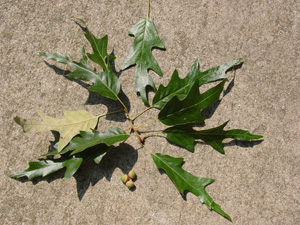 Photo: Gary Wade.
Photo: Gary Wade.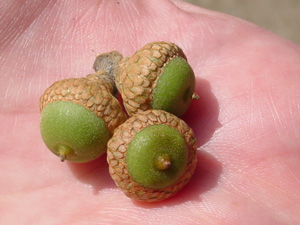 Photo: Gary Wade.
Photo: Gary Wade.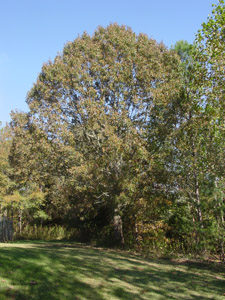 Photo: Gary Wade.
Photo: Gary Wade.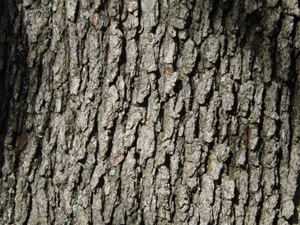 Photo: Gary Wade.
Photo: Gary Wade.Laurel Oak / Quercus hemisphaerica
Red Oak Subgenus: Erythrobalanus
Family: Beech / Fagaceae
Characteristics:
Laurel Oak is evergreen in zone 8b and semi-evergreen in zones 8a and 7b, where it holds its leaves the entire winter, then drops the oldest leaves at bud break. Growth form is spreading with medium-fine texture. Growth rate is moderately slow. It develops a broad crown at maturity, with horizontal branching.
Landscape Uses:
Use Laurel Oak as a shade or street tree. It prefers well-drained, sandy, loose soils and needs adequate moisture during dry weather. It is pest free.
Size:
60 to 80 feet tall with an equal spread
Zones:
7b, 8a, 8b (deciduous but hardy in 7a)
Habitat:
Upland sites on well-drained sandy soils, on stream banks and occasionally in mixed woods.
Native To:
The Coastal Plain and Piedmont from southern New Jersey to Florida, west to Texas and southeast Arkansas.
Comments:
Laurel Oak should be used more in landscapes. Several cultivars are available.
 Photo: Gary Wade.
Photo: Gary Wade.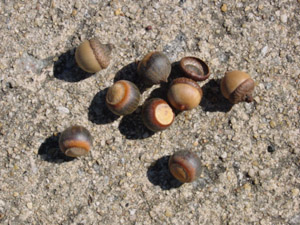 Photo: Gary Wade.
Photo: Gary Wade. CE.JPG) Photo: Chris Evans, Bugwood.org.
Photo: Chris Evans, Bugwood.org. Photo: Steve Sanchez.
Photo: Steve Sanchez.Swamp Chestnut Oak or Basket Oak / Quercus michauxii
White Oak Subgenus: Leucobalanus
Family: Beech / Fagaceae
Characteristics:
Swamp Chestnut Oak is a deciduous tree with a compact, rounded crown and a medium growth rate. It has chestnut-like foliage with rounded teeth along the margins. Leaves are dark green above and grayish-green with a dense, felt-like pubescence below. Its bark resembles that of White Oak, with light gray, rough, flaky ridges. It produces large acorns, one to 1.5 inches in diameter. Fall color is dull red to maroon.
Landscape Uses:
Swamp Chestnut Oak is used as a specimen or shade tree.
Size:
50 to 100 feet tall and about half as wide
Zones:
7a, 7b, 8a, 8b
Habitat:
Bottomlands and flood plains of streams in the Piedmont and Coastal Plain.
Native To:
New Jersey to Indiana, south to Florida and west to Texas.
Comments:
The abundant acorn production may be a problem in public areas.
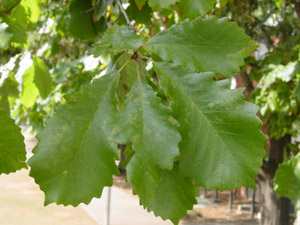 Photo: Gary Wade.
Photo: Gary Wade.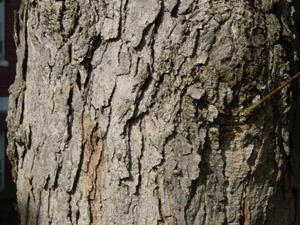 Photo: Gary Wade.
Photo: Gary Wade.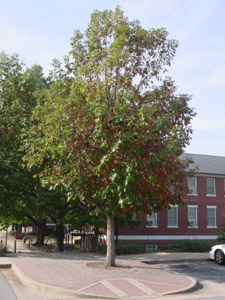 Photo: Gary Wade.
Photo: Gary Wade.Water Oak / Quercus nigra
Red Oak Subgenus: Erythrobalanus
Family: Beech / Fagaceae
Characteristics:
Water Oak is a fast-growing tree with a rounded crown. Leaves are alternate, obovate, often with a three-lobed apex. The leaves are variable in size and shape, especially when young. Foliage persists late into fall and winter, especially during mild winters, making the tree semi-evergreen. It is considered by many to be a short-lived "weed tree" on upland sites and is a vigorous early succession tree in Zones 7 to 9.
Landscape Uses:
Water Oak transplants easily and is tolerant of a wide variety of soils and site conditions. It does well in full sun. The wood is weaker than that of most oak trees and is subject to limb breakage during ice or wind storms. It also tends to retain numerous dead branches within its canopy.
Size:
50 to 80 feet tall and about half as wide
Zones:
7a, 7b, 8a, 8b
Habitat:
Along streams throughout the southeast from the Coastal Plain to the foothills of mountains.
Native To:
Southern New Jersey to Florida, west to eastern Texas and northward from the Mississippi valley to southeastern Missouri.
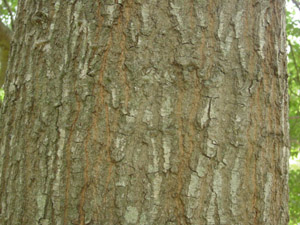 Photo: Gary Wade.
Photo: Gary Wade.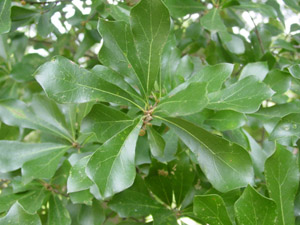 Photo: Gary Wade.
Photo: Gary Wade. Photo: Gary Wade.
Photo: Gary Wade.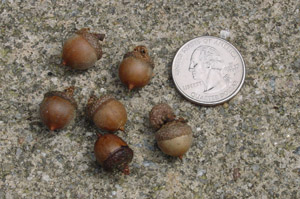 Photo: Gary Wade.
Photo: Gary Wade.Willow Oak / Quercus phellos
Red Oak Subgenus: Erythrobalanus
Family: Beech / Fagaceae
Characteristics:
Willow Oak is a deciduous tree with medium-fine texture and a medium growth rate. It has a handsome pyramidal form in youth, which becomes rounded to oval in maturity. The leaves are narrowly oblong or lanceolate, light green and shiny above and pale green below. Young bark is dark gray and smooth, while mature bark has deep furrows and rough ridges. Inner bark is pink.
Landscape Uses:
Willow Oak can be used as a shade or specimen tree. It prefers moist, fertile soils but tolerates adverse sites relatively well. It has a shallow root system that will heave concrete, so avoid using it as a street tree.
Size:
40 to 60 feet tall with a spread of 30 to 40 feet
Zones:
7a, 7b, 8a, 8b
Habitat:
Moist alluvial soils along rivers and streams, lowlands, flood plains and rich uplands.
Native To:
New York to Florida, west to Missouri, Oklahoma and Texas.
Comment:
Spider mites are a problem in south Georgia.
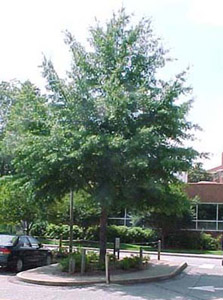 Photo: Gary Wade.
Photo: Gary Wade.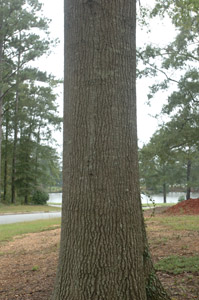 Photo: Ed McDowell.
Photo: Ed McDowell.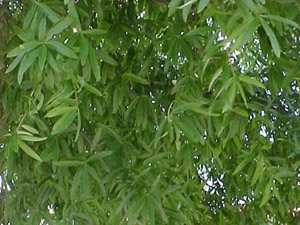 Photo: Gary Wade.
Photo: Gary Wade.Chestnut Oak / Quercus prinus
White Oak Subgenus: Leucobalanus
Family: Beech / Fagaceae
Characteristics:
Chestnut Oak, also called Rock Oak or Rock Chestnut Oak, is a deciduous tree with medium-coarse texture and a medium growth rate. Form is irregular and open. Foliage is lustrous dark green above and lighter green underneath. Fall color ranges from yellow to orange-yellow. Bark is gray and develops deep V-shaped ridges with age.
Landscape Uses:
Use Chestnut Oak as a shade or specimen tree. It prefers well-drained soils and full sun and has excellent drought tolerance once established. Pests are not a problem.
Size:
60 to 70 feet tall with a spread of 50 to 60 feet
Zones:
6b, 7a, 7b, 8a, 8b
Habitat:
Rocky, dry, upland soils. It also occurs occasionally on well-drained lowland sites.
Native To:
Maine to Michigan, south to Georgia and west to Louisiana.
Comments:
Deserving of greater landscape use.
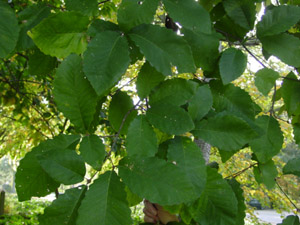 Photo: Gary Wade.
Photo: Gary Wade.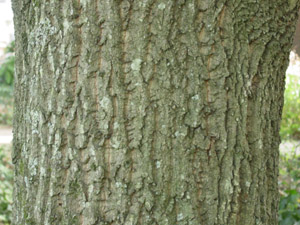 Photo: Gary Wade.
Photo: Gary Wade.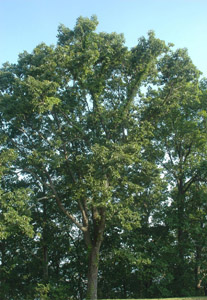 Photo: Chris Evans, Bugwood.org.
Photo: Chris Evans, Bugwood.org.Northern Red Oak / Quercus rubra
Red Oak Subgenus: Erythrobalanus
Family: Beech / Fagaceae
Characteristics:
Northern Red Oak is a deciduous tree with medium texture and a medium to fast growth rate. It develops a rounded crown with age. Leaves are alternate, oval or obovate, up to 8.5 inches long and 6 inches wide, with seven to 11 lobes. They are lustrous green above and yellow-green below. Fall color is usually yellow-brown but may be russet-red.
Landscape Uses:
Northern Red Oak is used as a large specimen shade tree. It transplants readily because of a negligible taproot. It needs acidic, sandy loam, well-drained soils and full sun for best development. Northern Red Oak tolerates dry conditions and urban sites.
Size:
60 to 75 feet tall with a spread of 40 to 50 feet
Zones:
6b, 7a, 7b, 8a
Habitat:
Widely adapted to a variety of sites, from rocky bluffs to water’s edge.
Native To:
Nova Scotia to Minnesota, south to north Georgia and west to Oklahoma.
Comments:
A source of wildlife food, it starts fruiting around 25 years of age.
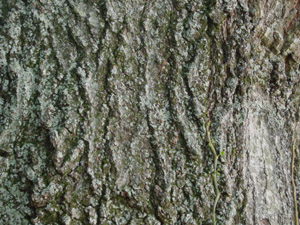 Photo: Gary Wade.
Photo: Gary Wade.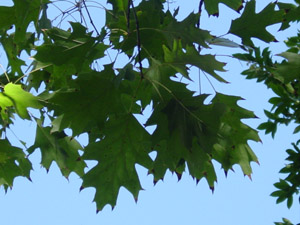 Photo: Gary Wade.
Photo: Gary Wade.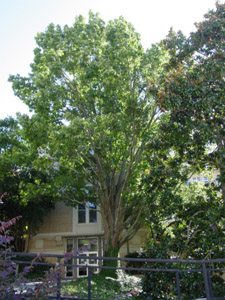 Photo: Gary Wade.
Photo: Gary Wade.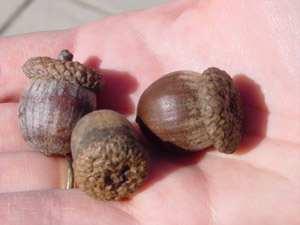 Photo: Gary Wade.
Photo: Gary Wade.Shumard Oak / Quercus shumardii
Red Oak Subgenus: Erythrobalanus
Family: Beech / Fagaceae
Characteristics:
Shumard Oak is one of the largest of the southern red oaks. It develops a round, open crown, a buttressed trunk and a shallow root system. It’s leaves are dark, shiny green above and dull green beneath, with pubescent woolly hairs at the leaf axils.
Landscapes Uses:
Shumard Oak is used as a fast-growing shade or specimen tree. It is easily transplanted as a container-grown tree or balled-in-burlap tree.
Size:
80 to 100 feet tall and 60 to 70 feet wide
Zones:
7a, 7b, 8a, 8b
Habitat:
Well-drained soils along rivers and streams.
Native To:
Southern Michigan to Kansas, south to North Carolina and Florida, and west to Texas.
Comments:
Its distribution seems to skip the northeastern section of Georgia (the Blue Ridge Province).
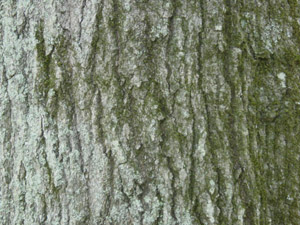 Photo: Gary Wade.
Photo: Gary Wade.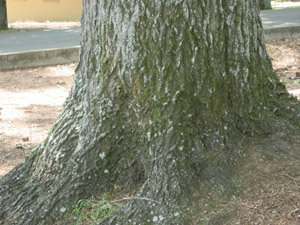 Photo: Gary Wade.
Photo: Gary Wade.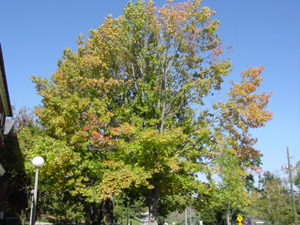 Photo: Gary Wade.
Photo: Gary Wade.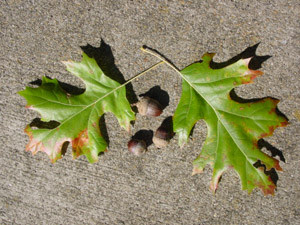 Photo: Gary Wade.
Photo: Gary Wade.
Post Oak / Quercus stellata
White Oak Subgenus: Leucobalanus
Family: Beech / Fagaceae
Characteristics:
Post Oak is a medium-size tree with stout, spreading branches and a dense, rounded crown. Leaves are lustrous, dark green, rough on the upper surface and grayish-brown underneath. Bark is gray with shallow fissures and scaly ridges. Foliage turns golden-brown in fall.
Landscape Uses:
Post Oak is not usually planted as a landscape tree, but it would be a good choice for dry reclamation sites.
Size:
40 to 50 feet tall by 40 feet wide
Zones:
6b, 7a, 7b, 8a, 8b
Habitat:
Poor, dry upland clay and sandy soils. In the natural landscape, it is a ridge tree.
Native To:
Southern Massachusetts to Florida, west to Iowa and Texas.
Comments:
As a member of the White Oak sub-genus, it produces acorns every year and is a good food source for wildlife.
 Photo: Paul Wray, Bugwood.org.
Photo: Paul Wray, Bugwood.org. Photo: Ed McDowell.
Photo: Ed McDowell.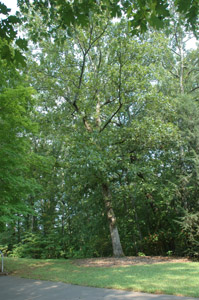 Photo: Ed McDowell.
Photo: Ed McDowell.Live Oak / Quercus virginiana
Red Oak Subgenus: Erythrobalanus
Family: Beech / Fagaceae
Characteristics:
Live Oak is an evergreen tree with medium-fine texture and a slow growth rate. It has a broad-spreading form with massive horizontal branches. It is a long-lived tree and a haven for resurrection fern and Spanish moss. The bark on older trees is almost black, develops a blocky appearance, and looks like alligator hide. Leaves are lustrous, dark green above and light green below. Old leaves drop in the spring as new leaves emerge.
Landscape Uses:
Use Live Oak as a specimen tree in large spaces. Its evergreen foliage does not allow much sunlight beneath the canopy. It prefers sandy, moist, limestone soils and full sun for best development. It tends to grow poorly in Piedmont clays.
Size:
40 to 80 feet tall and 60 to 100 feet wide
Zones:
7b, 8a, 8b
Habitat:
Sandy, alkaline soils, including coastal dunes and ridges, near marshes and inland hammocks in the lower Coastal Plain. Also commonly found up to 100 miles inland.
Native To:
Virginia to Florida, west to Oklahoma and Texas.
Comments:
Live Oak is the state tree of Georgia.
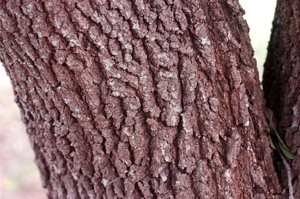 Photo: Ed McDowell.
Photo: Ed McDowell.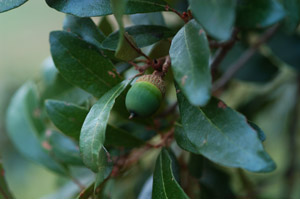 Photo: Ed McDowell.
Photo: Ed McDowell.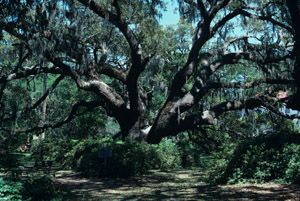 Photo: Gary Wade.
Photo: Gary Wade.Palmetto Palm or Cabbage Palm / Sabal palmetto
Family: Palm / Palmaceae
Characteristics:
The state tree of South Carolina, Palmetto Palm, is also called Cabbage Palm. It is a fixture along coastal areas as well as inland sites south of the fall line in Georgia and throughout Florida. In terms of toughness, it is often the tree still standing after hurricanes. Leaves are two to three feet across, blue-green, palmate in shape, with a large notch in the middle. Thread-like strands of fiber hang off each leaf. In the wild, old leaf-stems, called boots, remain on the trunk in a criss-cross pattern, but they are often removed from trees in cultivated landscapes to give the trunk a smooth appearance.
Landscape Uses:
Palmetto palm is sometimes used as a street tree, but it is used more often as a single specimen or in groupings in landscapes. A handsome and uniform grower, it lends a tropical look to the landscape. It is often planted at angles for added visual interest. Palmetto palm is very tolerant of salt spray, flooding and wind. Transplanting is most successful when done during the warm summer months.
Size:
30 to 70 feet tall with a canopy width of 10 to 15 feet.
Zones:
7b (coastal areas), 8a, 8b
Habitat:
Inland hammocks to coastal dunes.
Native To:
Southeastern coast from southern North Carolina to the northern panhandle of Florida. North of Florida, the native range of this palm is restricted to coastal areas that are subject to salt spray and storms. It is also native to inland areas of the Florida peninsula as well as to the Bahamas.
 Photo: Gary Wade.
Photo: Gary Wade.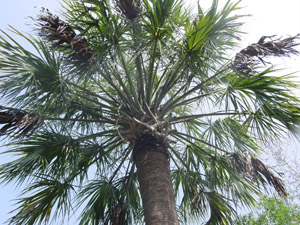 Photo: Gary Wade.
Photo: Gary Wade.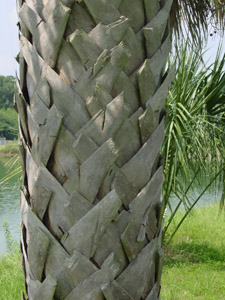 Photo: Gary Wade.
Photo: Gary Wade.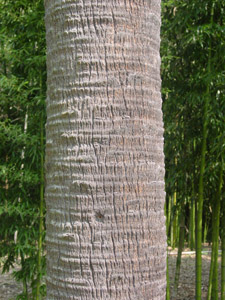 Photo: Gary Wade.
Photo: Gary Wade.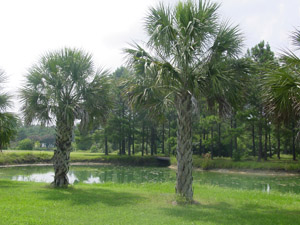 Photo: Gary Wade.
Photo: Gary Wade.Bald Cypress / Taxodium distichum
Family: Redwood / Taxodiaceae
Characteristics:
Bald Cypress is a deciduous tree with medium-fine texture and a medium to fast growth rate. Form is pyramidal when young (sometimes narrow) and becomes broader with age. In nature, older trees are flat-topped with few lower branches, which is probably due to competition for light. Its bark is reddish-brown, fibrous and attractive. Bald Cypress produces "knees" (vertical root extensions) in swamps but not when grown in upland sites.
Landscape Uses:
Plant Bald Cypress as a specimen tree. It does well in the average home landscape, displaying good drought tolerance and adaptability to sandy or clay soils as well as wet and dry sites. Uniform shape, lacy fern-like foliage, pest resistance and russet-red fall color are some of this tree’s landscaping merits. It needs full sun and plenty of room. Bald Cypress grows too large for the average residential landscape.
Size:
60 to 100 feet tall with a spread of 40 to 50 feet
Zones:
7a, 7b, 8a, 8b
Habitat:
Wet, swampy soils along riverbanks and flood plains, and in other areas where water collects.
Native To:
Delaware to Florida, west to southern Illinois, Arkansas, Louisiana and Texas.
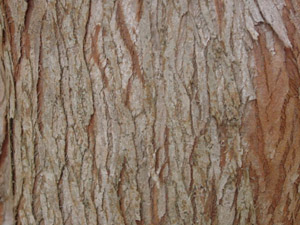 Photo: Gary Wade.
Photo: Gary Wade. Photo: Gary Wade.
Photo: Gary Wade.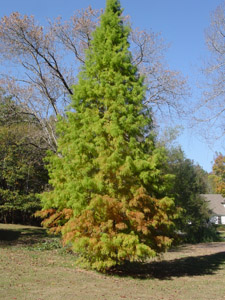 Photo: Gary Wade.
Photo: Gary Wade.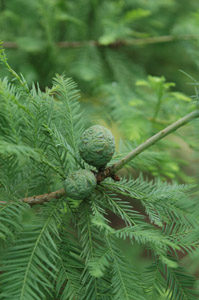 Photo: Chris Evans, Bugwood.org.
Photo: Chris Evans, Bugwood.org.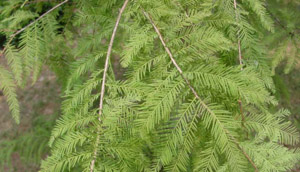 Photo: Gary Wade.
Photo: Gary Wade.Eastern Hemlock / Tsuga canadensis
Family: Pine / Pinaceae
Characteristics:
Eastern Hemlock is an evergreen tree, having a fine texture and a medium growth rate. It has a graceful pyramidal growth form. Leaves (needles) are short, one-half to two-thirds inches long, lustrous, dark green above with two white bands beneath. They are arranged along the stems in two planes. Bark is a cinnamon-red color and becomes furrowed with age.
Landscape Uses:
Eastern Hemlock is used as a specimen or screening tree and for a windbreak. It is fairly easy to transplant and prefers moist, well-drained, acid soils and partial shade. Afternoon shade and irrigation during periods of limited rainfall are required to grow the plant successfully in the lower Piedmont.
Size:
50 to 60 feet tall and with a spread of 30 to 40 feet
Zones:
6b, 7a, 7b
Habitat:
Moist coves, hardwood forests and rocky bluffs.
Native To:
Nova Scotia to Minnesota, south along the mountains to Alabama and Georgia.
Comments:
It is subject to several pests, including the woolly adelgid, which has recently invaded the north Georgia mountains.
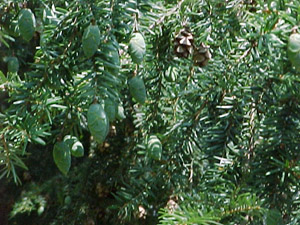 Photo: Gary Wade.
Photo: Gary Wade.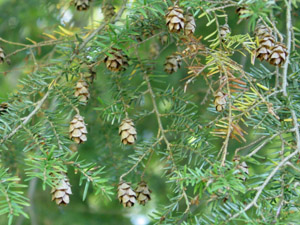 Photo: Gary Wade.
Photo: Gary Wade.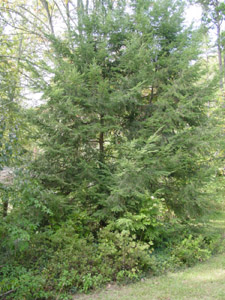 Photo: Gary Wade.
Photo: Gary Wade.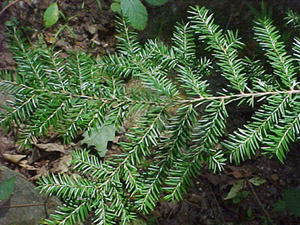 Photo: Gary Wade.
Photo: Gary Wade.
Small Trees
In this section:
- American Hornbeam / Carpinus caroliniana
- Big-Leaf Magnolia / Magnolia macrophylla
- Bigleaf Snowbell / Styrax grandifolius
- Buckthorn Bully / Sideroxylon lycioides (Syn. Bumelia lycioides)
- Carolina Buckthorn / Frangula caroliniana
- Carolina Silverbell / Halesia tetraptera
- Cherry Laurel / Prunus caroliniana
- Downy Serviceberry / Amelanchier arborea
- Eastern Hophornbeam / Ostrya virginiana
- Eastern Redbud / Cercis canadensis
- Florida or Southern Sugar Maple / Acer barbatum
- Flowering Dogwood / Cornus florida
- Fringetree or Grancy-Greybeard / Chionanthus virginicus
- Georgia Oak / Quercus georgiana
- Loblolly Bay / Gordonia lasianthus
- Mayhaw / Crataegus aestivalis
- Narrow-Leaf Crabapple / Malus angustifolia
- Ogeechee Lime, Ogeechee Tupelo / Nyssa ogeche
- Parsley Hawthorn / Crataegus marshallii
- Possumhaw / Ilex decidua
- Red Bay / Persea borbonia
- Sassafras / Sassafras albidum
- Sourwood / Oxydendrum arboreum
- Turkey Oak / Quercus laevis
- Two-Winged Silverbell / Halesia diptera
- Washington Hawthorn / Crataegus phaenopyrum
- Wild Olive, Devilwood / Osmanthus americanus
- Yaupon Holly / Ilex vomitoria
Florida or Southern Sugar Maple / Acer barbatum
Family: Maple / Aceraceae
Characteristics:
Florida or Southern Sugar Maple is a deciduous tree of medium texture and a slow to medium growth rate. It has a rounded to spreading canopy that is more pyramidal in youth. It has few pest problems. The underside of the leaf is lighter than the upper side. The bark is smooth and gray. Fall color is variable, ranging from yellow to orange or rusty-red. It is not as vibrant as Sugar Maple. Considered a close relative of Sugar Maple (Acer saccharum), Southern Sugar Maple is more tolerant of the high summer temperatures and humidity of Georgia than northern Sugar Maples.
Landscape Uses:
Southern Sugar Maple may be used as a shade, specimen or street tree. Plant it in acid soils with adequate moisture, because it is only moderately drought tolerant. It may require pruning in youth to obtain its best shape.
Size:
35 to 40 feet tall with a spread of 25 to 35 feet
Zones:
7b, 8a, 8b
Habitat:
Along stream banks and moist upland sites in the Piedmont and the Coastal Plain. It is commonly found along waterways.
Native To:
Southeastern Missouri, southern Illinois, Kentucky and Virginia, south to Florida and west to eastern Texas and Oklahoma.
Comments:
Southern Sugar Maple is becoming more popular in the nursery trade in the Deep South.
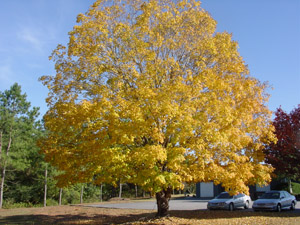 Photo: Gary Wade.
Photo: Gary Wade.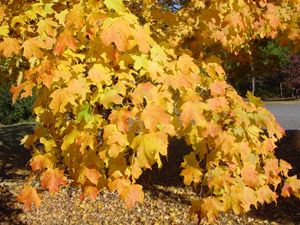 Photo: Gary Wade.
Photo: Gary Wade.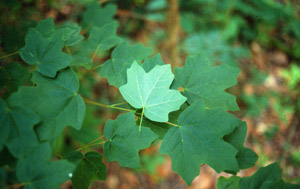 Photo: David J. Moorhead, Bugwood.org.
Photo: David J. Moorhead, Bugwood.org.Downy Serviceberry / Amelanchier arborea
Family: Rose / Rosaceae
Characteristics:
Downy Serviceberry is a deciduous, flowering tree with medium-fine texture, narrow-rounded crown and a medium growth rate. It blooms in early April with clusters of pendulous white flowers. Individual flowers are 1 inch in diameter with five narrow petals. Summer fruit are berry-like, purplish-blue and edible by humans and birds. Fall color can be good and ranges from yellow to orange or rusty-red. The bark is a pleasing gray color.
Landscape Uses:
Use Downy Serviceberry as a flowering or specimen tree. It prefers well-drained, acid soils with adequate moisture, although it appears tolerant of many different sites, except wet soils. Plant it in full sun to light shade.
Size:
15 to 25 feet tall and 15 to 20 feet wide
Zones:
7a, 7b, 8a, 8b
Habitat:
Moist soils in hardwood forests; often found near streams.
Native To:
Nebraska and Minnesota, east to Maine, south to Florida and west to Texas.
Comments:
The fruit ripens in June and is enjoyed by birds.
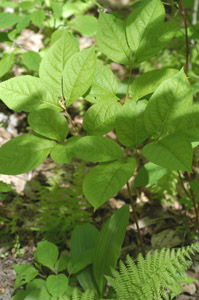 Photo: Ed McDowell.
Photo: Ed McDowell.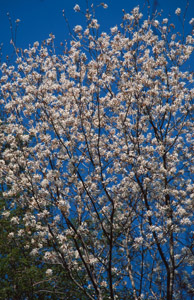 Photo: Carol Nourse.
Photo: Carol Nourse.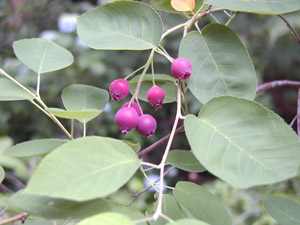 Photo: Theresa Schrum.
Photo: Theresa Schrum.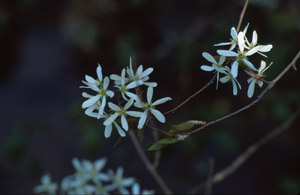 Photo: Carol Nourse.
Photo: Carol Nourse.American Hornbeam, Ironwood or Musclewood / Carpinus caroliniana
Family: Birch / Betulaceae
Characteristics:
American Hornbeam is a deciduous tree with medium texture and a slow to medium growth rate. It is usually single-stemmed with a spreading to rounded form. It may occur as a multistemmed, bushy tree. An unusual feature is the smooth, hard branches and trunk, which acquire a muscle-like rippled (Ironwood) appearance with age.
Landscape Uses:
Use American Hornbeam as a specimen or street tree. It should be used much more in home landscapes. An understory tree, often occurring in wet areas, it appears to tolerate both excess moisture and moderate drought. It develops a pleasing shape without much pruning. Fall color is variable, ranging from yellow to orange or red.
Size:
35 to 40 feet tall with a spread of 20 to 25 feet
Zones:
6b, 7a, 7b, 8a, 8b
Habitat:
American Hornbeam grows in flood plains and along waterways throughout the Southeast.
Native To:
Minnesota to Maine, south to Florida and west to Texas.
Comments:
Seeds are eaten by birds.
 Photo: Chris Evans, Bugwood.org.
Photo: Chris Evans, Bugwood.org.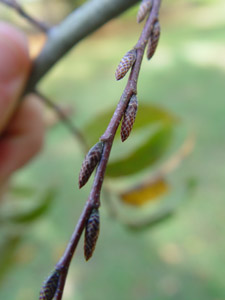 Photo: Chris Evans, Bugwood.org.
Photo: Chris Evans, Bugwood.org.
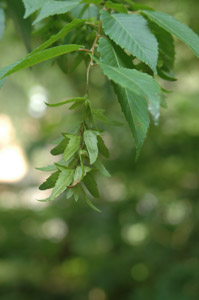 Photo: Chris Evans, Bugwood.org.
Photo: Chris Evans, Bugwood.org.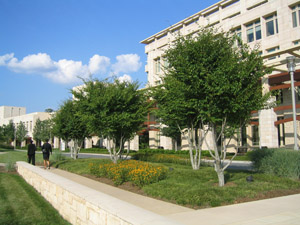 Photo: Steve Sanchez.
Photo: Steve Sanchez.Eastern Redbud / Cercis canadensis
Family: Legume / Fabaceae (syn. Leguminosae)
Characteristics:
Eastern Redbud is a deciduous, flowering tree with a medium growth rate and coarse texture. Form is oval to rounded. Grown primarily for the pink to rose-colored, pea-like blooms in March and April, Eastern Redbud is showy. The color conveys a warm feeling in the cool early spring.
Landscape Uses:
Use Eastern Redbud as a flowering or specimen tree. It occurs in moist soils as an understory tree, but it tolerates most landscape conditions and urban sites. Plant or transplant young trees or container-grown plants because larger trees are difficult to transplant. Moderately acid pH is preferred.
Size:
20 to 25 feet tall with a spread of 15 to 20 feet
Zones:
6b, 7a, 7b, 8a, 8b (shorter-lived in 8a, 8b)
Habitat:
Moist soils of valleys and slopes in hardwood forests.
Native To:
Massachusetts to northern Florida, west to Texas, north to Nebraska, Iowa, southern Wisconsin and Minnesota.
Comments:
Eastern Redbud is becoming more popular in the nursery trade in the Deep South. Many cultivars are available with variations in flower color from white to deep rose. It re-seeds readily in cultivated areas.
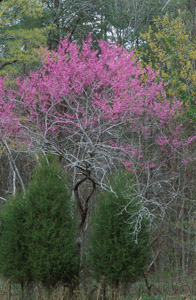 Photo: Hugh & Carol Nourse.
Photo: Hugh & Carol Nourse.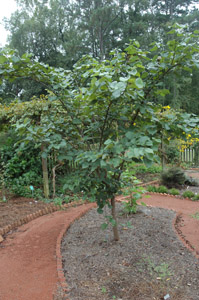 Photo: Ed McDowell.
Photo: Ed McDowell.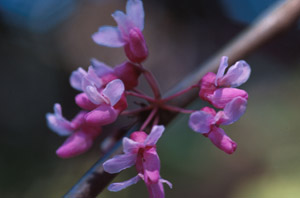 Photo: Fred Mileshko.
Photo: Fred Mileshko.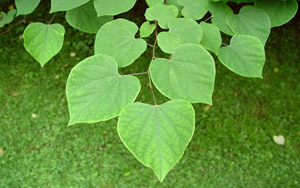 Photo: Chris Evans, Bugwood.org.
Photo: Chris Evans, Bugwood.org.
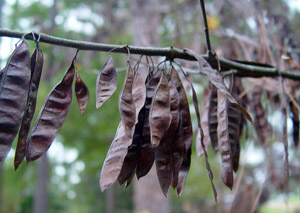 Photo: Chris Evans, Bugwood.org.
Photo: Chris Evans, Bugwood.org.Fringetree or Grancy-Greybeard / Chionanthus virginicus
Family: Olive / Oleaceae
Characteristics:
Fringetree is a deciduous, flowering tree with medium texture and a slow growth rate. Rounded in form, it is grown mostly for its showy flowers in May to June. They give the tree a fleecy appearance. Fruit are dark blue, 0.5 inches in diameter, and resemble small, black olives. Fruit appear on female trees only.
Landscape Uses:
Use Fringetree as a flowering specimen tree. It adapts to most sites, including moderately dry sites. It is vigorous when young, then grows slower with age. It does better with good cultural practices, including fertilization, watering and mulching.
Size:
15 to 25 feet tall and wide
Zones:
6b, 7a, 7b, 8a, 8b
Habitat:
Moist soils of valleys and bluffs, and in hardwood forests.
Native To:
New York and Massachusetts, south to Florida, west to Texas and Oklahoma.
Comments:
This tree is dioecious, having male (staminate) and female (pistillate) flowers on separate plants.
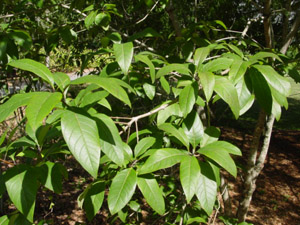 Photo: Gary Wade.
Photo: Gary Wade.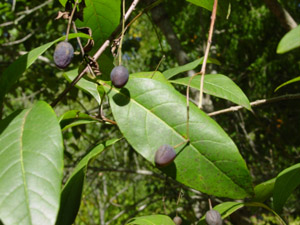 Photo: Gary Wade.
Photo: Gary Wade.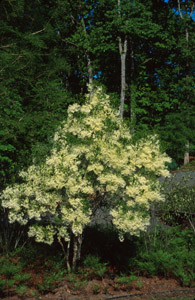 Photo: Hugh & Carol Nourse.
Photo: Hugh & Carol Nourse.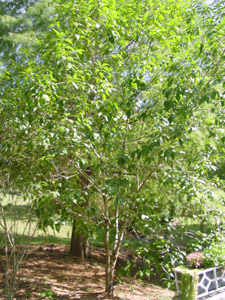 Photo: Gary Wade.
Photo: Gary Wade.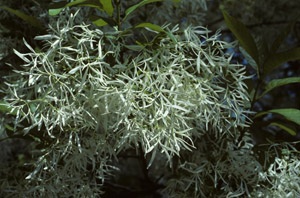 Photo: Gary Wade.
Photo: Gary Wade.Flowering Dogwood / Cornus florida
Family: Dogwood / Cornaceae
Characteristics:
Flowering Dogwood, the most popular flowering tree in the eastern United States, is deciduous with medium texture and a medium growth rate. It bears white, pink or rose-colored blooms from March to April. In fall, leaves turn scarlet red, and fruit are red and showy. Bark is dark and mottled. Seedling dogwoods are often planted in woodland landscapes.
Landscape Uses:
Use Dogwood as a flowering understory tree. It prefers light shade and adequate moisture during dry weather. Never plant it on wet sites. Mulch to keep roots cool in summer and warm in winter. Powdery mildew and leaf spot anthracnose can be problems.
Size:
15 to 20 feet tall and 15 to 30 feet wide; more spreading in shade
Zones:
6b, 7a, 7b, 8a, 8b
Habitat:
Moist soils of valleys and uplands in the understory layer of hardwood forests.
Native To:
Maine to Florida, west to Texas, north to Kansas, Missouri, Illinois, Michigan.
Comments:
Numerous cultivars exist, including some with variegated foliage. Dogwood fruit are a favorite of birds and other wildlife. Deer browse the leaves.
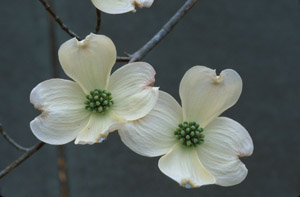 Photo: Hugh & Carol Nourse.
Photo: Hugh & Carol Nourse.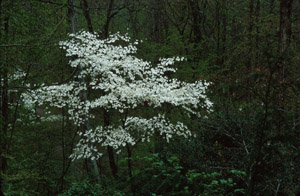 Photo: Hugh & Carol Nourse.
Photo: Hugh & Carol Nourse.
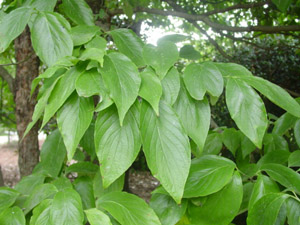 Photo: Gary Wade.
Photo: Gary Wade.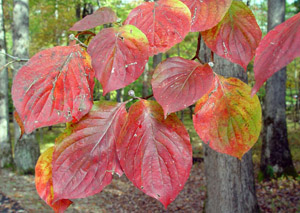 Photo: Chris Evans, Bugwood.org.
Photo: Chris Evans, Bugwood.org.
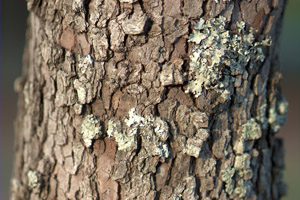 Photo: Ed McDowell.
Photo: Ed McDowell.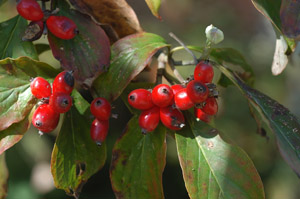 Photo: Ed McDowell.
Photo: Ed McDowell.
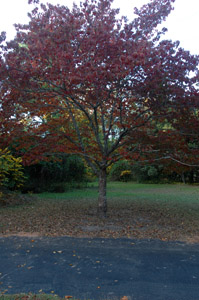 Photo: Ed McDowell.
Photo: Ed McDowell.Mayhaw / Crataegus aestivalis
Family: Rose / Rosaceae
Characteristics:
Mayhaw is a thorny, deciduous, small tree with white flowers borne in a flat cluster in March. The fruit are round, 0.5 to 1 inch in diameter, and ripen to shiny red in May and June. Bark is scaly and mottled.
Landscape Uses:
Use Mayhaw in shrub borders and woodland edges.
Size:
15 to 20 feet tall and wide
Zones:
7a, 7b, 8a, 8b
Habitat:
Thin, wet woods; shallow depressions; and other low, moist areas.
Native To:
Virginia to Florida, west to Alabama and Mississippi
Comments:
The fruit makes excellent jelly.
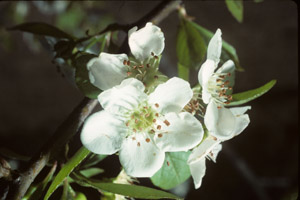 Photo: Gerard Krewer.
Photo: Gerard Krewer.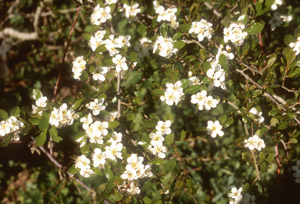 Photo: Ron Lance.
Photo: Ron Lance.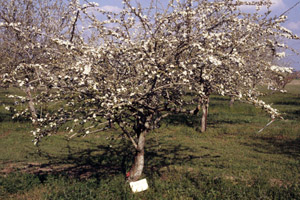 Photo: Gerard Krewer.
Photo: Gerard Krewer.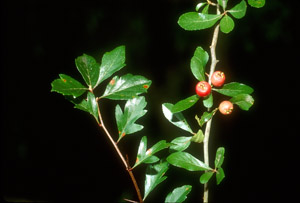 Photo: Ron Lance.
Photo: Ron Lance.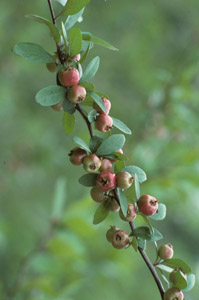 Photo: Gerard Krewer.
Photo: Gerard Krewer. Photo: Gerard Krewer.
Photo: Gerard Krewer.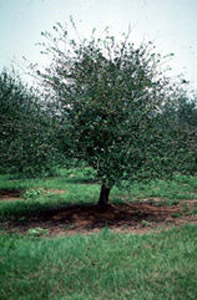 Photo: Gerard Krewer.
Photo: Gerard Krewer.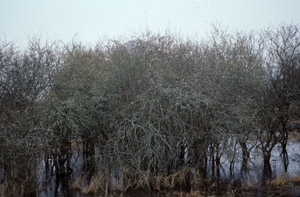 Photo: Gerard Krewer.
Photo: Gerard Krewer.Parsley Hawthorn / Crataegus marshallii
Family: Rose / Rosaceae
Characteristics:
Parsley Hawthorn is a deciduous, flowering tree with medium-fine texture, thorny branches and a slow growth rate. White flowers with showy purple anthers are borne in clusters in March and April. Fruit are 0.5 inches in diameter, red and oval. Leaves are unique in that they resemble the foliage of parsley. Bark is scaly and mottled.
Landscape Uses:
Parsley Hawthorn is an understory tree that prefers moist soils in light shade or full sun. Use it as a specimen tree.
Size:
15 to 20 feet tall and wide
Zones:
7a, 7b, 8a, 8b
Habitat:
Moist areas, valleys and swampy forests.
Native To:
Virginia to Florida, west to Texas.
Comments:
All hawthorns provide fruit for birds in the fall and are preferred nesting trees in spring. Lace bugs can be a problem.
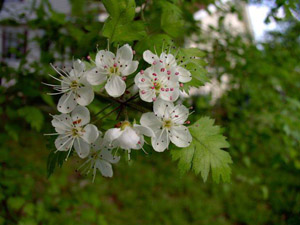 Photo: Ed McDowell.
Photo: Ed McDowell.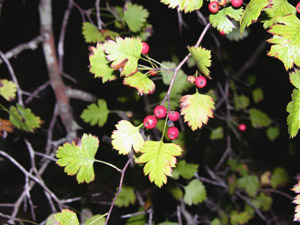 Photo: Ron Lance.
Photo: Ron Lance.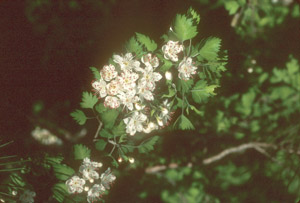 Photo: Ron Lance.
Photo: Ron Lance.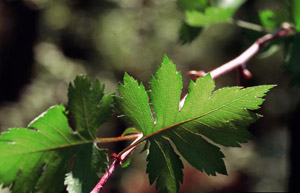 Photo: Ted Bodner, Bugwood.org.
Photo: Ted Bodner, Bugwood.org.
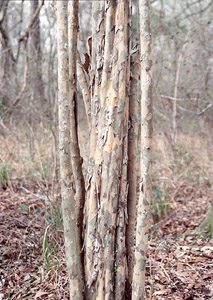 Photo: Guy Anglin.
Photo: Guy Anglin.Washington Hawthorn / Crataegus phaenopyrum
Family: Rose / Rosaceae
Characteristics:
Washington Hawthorn is a thorny, deciduous, small tree with a broadly oval to rounded dense shape. The foliage is reddish as it emerges, changing to a dark, lustrous green. The leaves are triangular-ovate, coarsely toothed and deeply lobed. The half-inch white flowers bloom in clusters after the leaves emerge, with pink anthers on numerous stamens.
Landscape Uses:
Washington Hawthorn makes an excellent small specimen tree, screen or hedge near buildings, provided it isn't used in high-traffic areas because of its thorns. The fall color varies from orange to scarlet to purple. The bright red fruit display is an outstanding feature.
Size:
25 to 30 feet tall to 20 to 25 feet wide
Zones:
7a, 7b, 8a
Habitat:
Riverbanks and low, moist woods from the mountains to the upper Coastal Plain; may not be as vigorous in the southern part of its range.
Native To:
Pennsylvania to Florida and westward to Louisiana, Arkansas and Missouri.
Comments:
There are cultivars available. All hawthorns are valuable to wildlife by providing fruit and nesting sites.
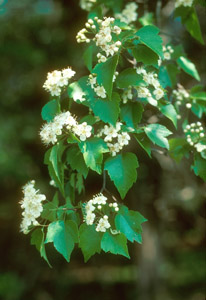 Photo: Ron Lance.
Photo: Ron Lance. Photo: Ron Lance.
Photo: Ron Lance.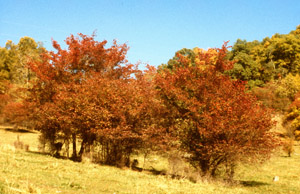 Photo: Ron Lance.
Photo: Ron Lance.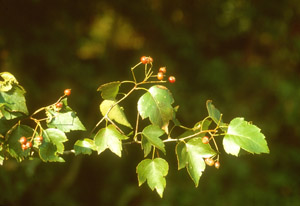 Photo: Ron Lance.
Photo: Ron Lance.Carolina Buckthorn / Frangula caroliniana
Family: Buckthorn / Rhamnaceae
Characteristics:
Carolina Buckthorn is a small, deciduous tree. Leaves are simple, alternate, elliptic to oblong, 4 to 6 inches long, with parallel veins extending from a prominent midrib. The small, white flowers appear after the leaves in clusters at the leaf axils. Fruit are berry-like drupes, changing from red to black.
Landscape Uses:
Carolina Buckthorn is an attractive tree with slender branches and an open crown. It is quite handsome in fruit and is an excellent specimen understory tree. However, it may have a tendency to reseed itself and become weedy. It prefers partial shade.
Size:
30 to 40 feet tall with a spread about half its height
Zones:
7a, 7b, 8a, 8b
Habitat:
Fertile soils of deciduous forests. It is frequently associated with limestone soils, such as shell middens and calcareous bluffs.
Native To:
Virginia to Florida, west to Texas, north to Oklahoma, Missouri and Illinois.
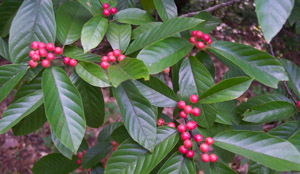 Photo: Michael Strickland.
Photo: Michael Strickland. Photo: Michael Strickland.
Photo: Michael Strickland.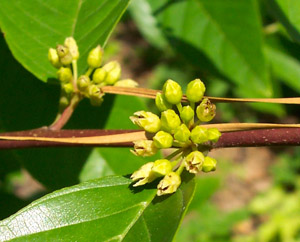 Photo: Michael Strickland.
Photo: Michael Strickland.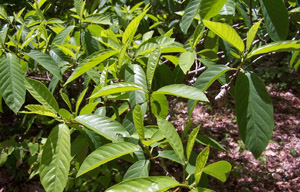 Photo: Michael Strickland.
Photo: Michael Strickland.
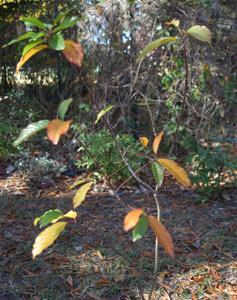 Photo: Ed McDowell.
Photo: Ed McDowell.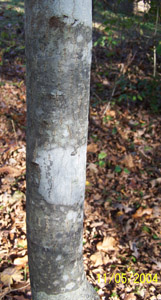 Photo: Michael Strickland.
Photo: Michael Strickland.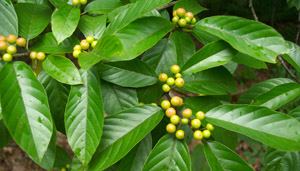 Photo: Michael Strickland.
Photo: Michael Strickland.Loblolly Bay / Gordonia lasianthus
Family: Tea / Theaceae
Characteristics:
Loblolly Bay is an evergreen tree with medium texture and a medium growth rate, having a narrow, pyramidal to oval shape. Leaves are smooth, dark green and have blunt appressed teeth. Summer flowers are white, 2.5 inches in diameter and fragrant. Fruit are woody capsules.
Landscape Uses:
Use Loblolly Bay as a screening or specimen flowering tree. It prefers moist, fertile, well-drained soil, and sun to light shade.
Size:
30 to 40 feet tall and 20 to 30 feet wide
Zones:
7b, 8a, 8b
Habitat:
Bays, low hammocks, acidic, peaty soils in and around pocosins. Also found on sand hills in association with various hardwoods and conifers.
Native To:
The Coastal Plain from North Carolina to Florida, west to Mississippi.
Comments:
Loblolly Bay is most often used in the landscape in groupings of three to five plants.
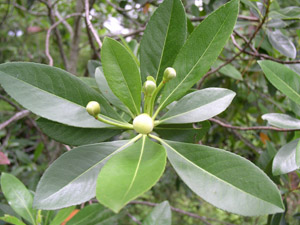 Photo: John Ruter.
Photo: John Ruter.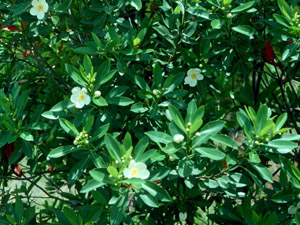 Photo: USF Herbarium Slide Collection.
Photo: USF Herbarium Slide Collection.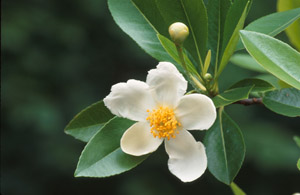 Photo: Carol Nourse.
Photo: Carol Nourse.Two-Winged Silverbell / Halesia diptera
Family: Storax / Styracaceae
Characteristics:
Two-Winged Silverbell is often confused with Carolina Silverbell (H. tetraptera). However, it is smaller and produces fewer flowers than Carolina Silverbell. Its white flower petals are united at the base. Carolina Silverbell, in contrast, has flower petals that are united for more than half their length. Bark is gray-brown and lacks white streaks common on Carolina Silverbell. Fruit are a greenish color. Fall color is pleasant yellow.
Landscape Uses:
Use Two-Winged Silverbell as a specimen understory trees in wet to moist locations.
Size:
25 feet tall and 15 feet wide
Zone:
7a, 7b, 8a, 8b
Habitat:
Swampy areas near waterways.
Native To:
The Coastal Plain, South Carolina to Florida, particularly the southwestern Coastal Plain of Georgia and along the Gulf Coast into Texas.
Comments:
A variety called magniflora has larger flowers than Two-Winged Silverbell.
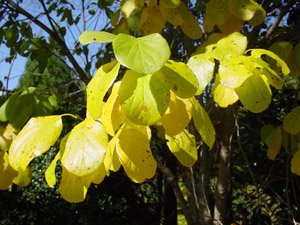 Photo: Gary Wade.
Photo: Gary Wade.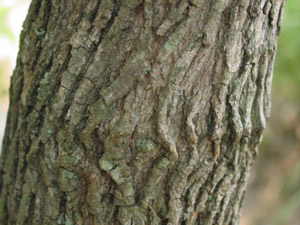 Photo: Gary Wade.
Photo: Gary Wade.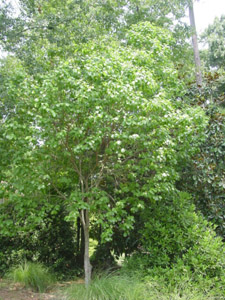 Photo: Gary Wade.
Photo: Gary Wade.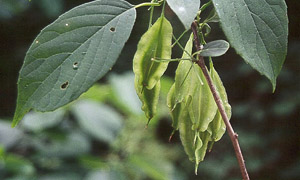 Photo: Fred Nation.
Photo: Fred Nation.Carolina Silverbell / Halesia tetraptera
Family: Storax / Styracaceae
Characteristics:
Carolina Silverbell is a deciduous tree with medium-coarse texture and a medium growth rate. It has an upright-oval to broad-rounded form. Subtly, but not explosively showy, its best ornamental features are the clusters of white, bell-shaped flowers borne from April to early May. Bark is shallowly ridged with white streaks. Fruit are four-winged capsules approximately 1.5 inches long. Fall color is yellow to yellow-green.
Landscape Uses:
Use Carolina Silverbell as a flowering or specimen tree. It prefers rich, moist, well-drained, acidic soil and sun to partial shade. Although it naturally occurs as an understory tree, it has shown good drought tolerance in full sun. It seems to transplant well.
Size:
30 to 40 feet tall with a spread of 20 to 35 feet
Zones:
6b, 7a, 7b, 8a
Habitat:
Wooded hillsides and along stream banks. It is occasionally found along waterways in the upper Coastal Plain.
Native To:
New York to Georgia and Alabama, north to Michigan, southwest from Illinois to Texas.
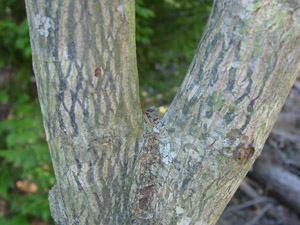 Photo: Gary Wade.
Photo: Gary Wade.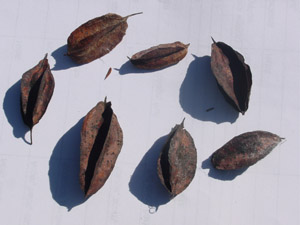 Photo: Gary Wade.
Photo: Gary Wade.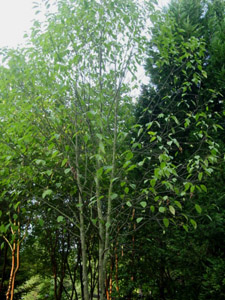 Photo: Gary Wade.
Photo: Gary Wade.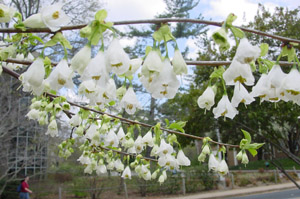 Photo: Gary Wade.
Photo: Gary Wade.Possumhaw / Ilex decidua
Family: Holly / Aquifoliaceae
Characteristics:
Possumhaw is a deciduous tree with medium-fine texture and a medium to slow growth rate. Form is round at maturity. Possumhaw is grown mostly for its shiny red fall berries, which are consumed by wildlife. The leaves turn a bright yellow in fall. It is similar in fruiting habit to Yaupon Holly (I. vomitoria), except it is deciduous, which makes the fruit more obvious.
Landscape Uses:
Use Possumhaw as a specimen tree in the shrub border or at the woodland edge. It prefers moist soils in full sun to partial shade. It transplants readily and has fair drought tolerance. It tends to be multi-stemmed but can be easily pruned into a tree shape.
Size:
12 to 15 feet tall and 8 to 10 feet wide
Zones:
7a, 7b, 8a, 8b
Habitat:
Moist soils in low woods and lower slopes in woods and thickets from the lower Piedmont to the southern Coastal Plain.
Native To:
Maryland and Virginia, south to Florida, west to Texas, Oklahoma, Kansas.
Comments:
All hollies are dioecious, having male and female flowers on separate plants. Possumhaw is a good wildlife plant. There are several cultivars in the nursery trade.
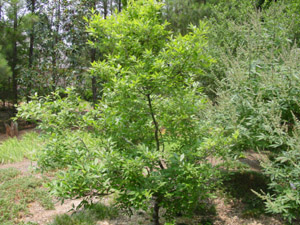 Photo: Gary Wade.
Photo: Gary Wade.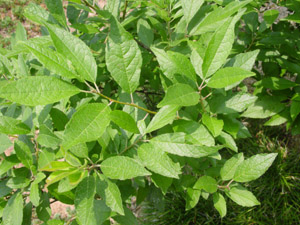 Photo: Gary Wade.
Photo: Gary Wade.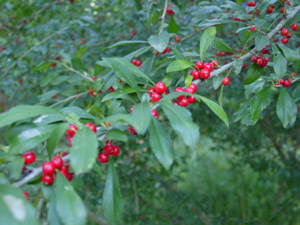 Photo: Gary Wade.
Photo: Gary Wade.Yaupon Holly / Ilex vomitoria
Family: Holly / Aquifoliaceae
Characteristics:
Yaupon Holly is a broadleaf evergreen tree with medium-fine texture and a fast growth rate. It has a graceful, attractive, irregular form; sometimes rounded, other times pyramidal. It tends to be multi-stemmed, but it can be easily pruned into a tree form. The bark is smooth gray. Shiny red fruit provide a brilliant display in fall until they are consumed by birds. Fruit only occurs on female plants.
Landscape Uses:
Use Yaupon Holly as a specimen tree or hedge for screening. It is commonly used in landscapes because of its adaptability to a wide variety of sites, including sun or shade, wet and dry sites, and both acidic and alkaline soils. It is prone to ice and storm damage.
Size:
12 to 20 feet tall and 8 to 12 feet wide
Zones:
7a, 7b, 8a, 8b
Habitat:
Moist soils, especially beaches, maritime forests and sandhills of the Coastal Plain.
Native To:
Virginia to central Florida, west to Texas and Oklahoma.
Comments:
Cultivars are available, including weeping and dwarf forms.
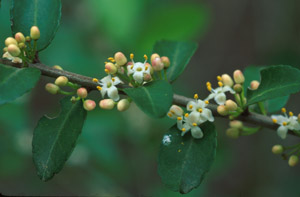 Photo: Hugh & Carol Nourse.
Photo: Hugh & Carol Nourse.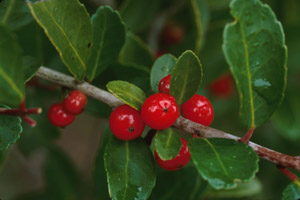 Photo: Hugh Nourse.
Photo: Hugh Nourse.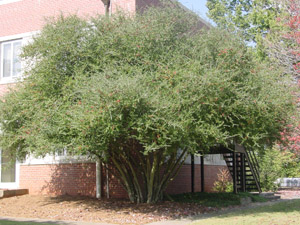 Photo: Gary Wade.
Photo: Gary Wade.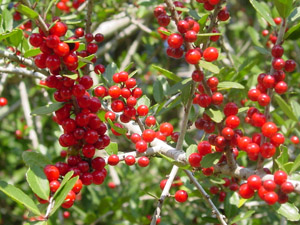 Photo: Gary Wade.
Photo: Gary Wade.Big-Leaf Magnolia / Magnolia macrophylla
Family: Magnolia / Magnoliaceae
Characteristics:
Big-Leaf Magnolia is a deciduous, flowering tree having coarse texture, a round-headed form, and a medium growth rate. Unusually large leaves are 20 to 30 inches long and 8 to 12 inches wide. Large, white, fragrant flowers are borne from May to June and have six petals 8 to 12 inches across. Its egg-shaped, cone-like fruit and red seeds are typical of Magnolias.
Landscape Uses:
Use Big-Leaf Magnolia as a specimen tree. Because of its extremely large leaves, it becomes a focal point wherever it is grown. It is a temperamental tree, often difficult to establish, requiring rich, moist soils and partial shade. Avoid planting it in exposed locations because the large leaves are easily torn by wind. Leaf litter may be a problem.
Size:
35 to 40 feet tall and 25 to 30 feet wide
Zones:
7a, 7b, 8a
Habitat:
Moist soils of valleys and ravines. It is sporadically found in the Piedmont, especially in the Chattahoochee drainage area and in hilly sections of the western Coastal Plain. Often found as an understory tree.
Native To:
Ohio to Florida, west to Arkansas and Louisiana.
Comments:
This is a tree for a plant collector.
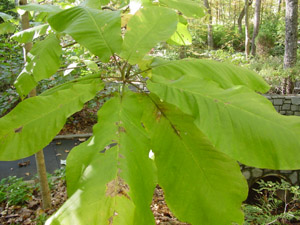 Photo: Gary Wade.
Photo: Gary Wade.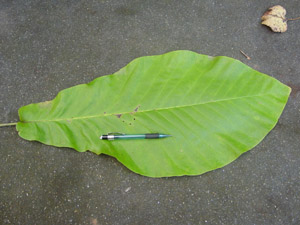 Photo: Gary Wade.
Photo: Gary Wade.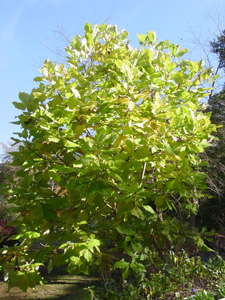 Photo: Gary Wade.
Photo: Gary Wade.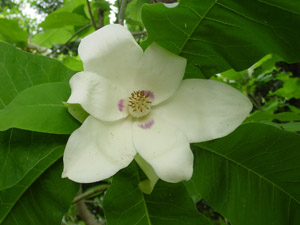 Photo: Gary Wade.
Photo: Gary Wade.
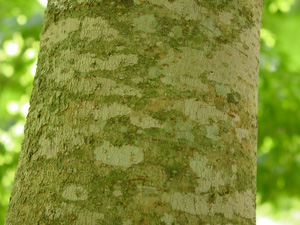 Photo: Gary Wade.
Photo: Gary Wade.Narrow-Leaf Crabapple / Malus angustifolia
Family: Rose / Rosaceae
Characteristics:
Narrow-Leaf Crabapple is a deciduous, flowering tree with medium texture and a medium growth rate. The crown is broad, rounded and spreading. While not as showy as named cultivars, it is an attractive flowering tree when in bloom. Flowers are pink, 1.5 inches across, and borne in clusters. Flowering time varies from late February in south Georgia to mid April in north Georgia. Fruit are yellow-green, approximately 1.5 inches in diameter, edible and very tart.
Landscape Uses:
Use Narrow-Leaf Crabapple as a specimen flowering tree in full sun. It prefers moist soils but has moderate drought tolerance. This tree has not been used in landscapes, so its full site tolerance is not known. Avoid wet sites. It shows better disease tolerance than most cultivated varieties under Georgia conditions.
Size:
25 to 30 feet tall and 20 to 25 feet wide
Zones:
7a, 7b, 8a, 8b
Habitat:
Moist soils of valleys and lower slopes; also found in fence rows and old fields.
Native To:
Maryland to West Virginia, south to Florida and west to Missouri.
Comments:
Excellent wildlife food.
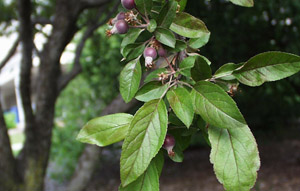 Photo: Paul Wray, Bugwood.org.
Photo: Paul Wray, Bugwood.org.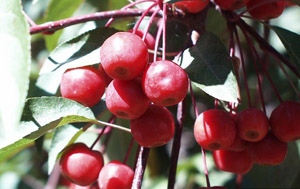 Photo: Paul Wray, Bugwood.org.
Photo: Paul Wray, Bugwood.org.
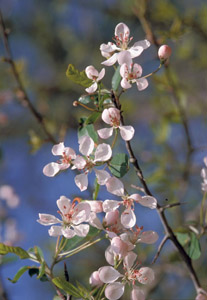 Photo: James H. Miller, Bugwood.org.
Photo: James H. Miller, Bugwood.org.Ogeechee Lime, Ogeechee Tupelo / Nyssa ogeche
Family: Nyssa / Nyssaceae
Characteristics:
Ogeechee Lime is a deciduous tree with medium texture and a medium growth rate. Oval, red fruit mature in fall. They are very sour and have been used as a substitute for limes or in making tart preserves and jellies. Form is variable. Fall color also is variable, ranging from yellow to red. This plant is named for the Ogeechee River, where it is commonly found.
Landscape Uses:
Use Ogeechee Lime as a specimen or small-scale street tree. It occurs naturally in wet areas but shows good drought tolerance. It prefers acid soils and full sun to partial shade. Provide irrigation on sunny sites.
Size:
20 to 30 feet tall by 15 to 25 feet wide
Zones:
7b, 8a, 8b
Habitat:
Wet, swampy areas and along small black-water drainage areas of the Coastal Plain.
Native To:
Southeastern South Carolina to Georgia and Florida.
Comments:
Fruit can be eaten by humans and wildlife. The tree is a honey source for bees. Reported to be rare, but it is fairly common in south central Georgia.
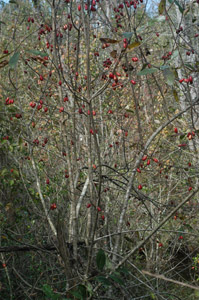 Photo: Ed McDowell.
Photo: Ed McDowell.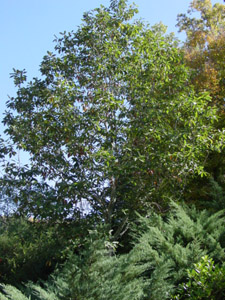 Photo: Gary Wade.
Photo: Gary Wade.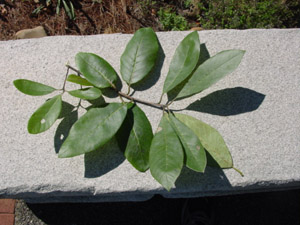 Photo: Gary Wade.
Photo: Gary Wade.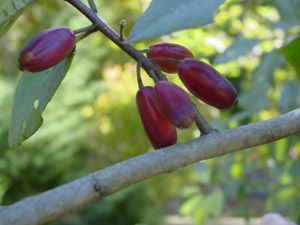 Photo: Gary Wade.
Photo: Gary Wade.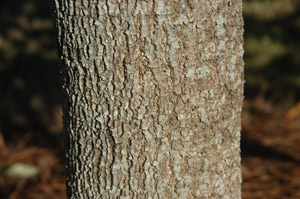 Photo: Ed McDowell.
Photo: Ed McDowell.Wild Olive or Devilwood / Osmanthus americanus
Family: Olive / Oleaceae
Characteristics:
Wild Olive is a small evergreen tree with medium texture and a medium to slow growth rate. Form is oval to round. White flowers, borne in spring, are small, fragrant and bell-shaped. The fruit are purple and olive-like.
Landscape Uses:
Wild Olive is useful in a naturalized landscape or as a foundation specimen. It displays good drought tolerance if planted in moist, well-drained soils. It establishes moderately well after planting.
Size:
20 to 30 feet tall and 15 to 20 feet wide
Zones:
7b, 8a, 8b
Habitat:
Moist soils of river valleys to shady uplands and dunes in the understory of Coastal Plain forests.
Native To:
North Carolina to Florida, and west to Mississippi.
Comments:
A good wildlife plant.
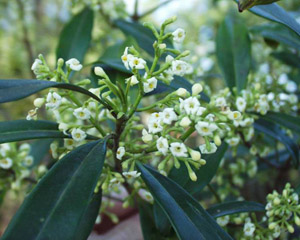 Photo: John Ruter.
Photo: John Ruter.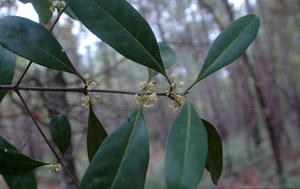 Photo: Chris Evans, Bugwood.org.
Photo: Chris Evans, Bugwood.org.
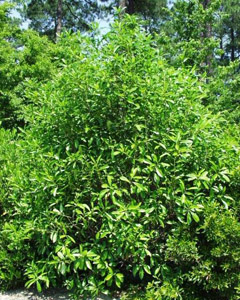 Photo: John Ruter.
Photo: John Ruter.Eastern Hophornbeam / Ostrya virginiana
Family: Birch / Betulaceae
Characteristics:
Eastern Hophornbeam is a deciduous tree with medium texture and a slow growth rate. It is rounded in outline with horizontal or drooping branches. It occurs as an understory tree on uphill sites having moist, well-drained, acid soils. Fall leaf color is yellow. Leaves remain on the tree throughout the winter. This is a handsome tree with few pest problems. The fruit are reminiscent of hops, hence the common name. The gray-brown bark is somewhat shaggy, looking like a cat scratching post.
Landscape Uses:
Eastern Hophornbeam is best planted as an understory tree in partial to full shade and moist soils. It has moderate drought tolerance but is slow to establish on dry sites. It is not tolerant of wet sites.
Size:
25 to 40 feet tall and 20 to 30 feet wide
Zones:
6b, 7a, 7b, 8a, 8b
Habitat:
An understory tree found on dry slopes in upland hardwood forests..
Native To:
Ontario to Minnesota, south to Florida and west to Texas.
Comments:
The "hops," or inflated bracts that enclose the seed, are irritating to the skin if handled. It is a useful wildlife tree. It is sometimes infected by a fungus that causes witches broom.
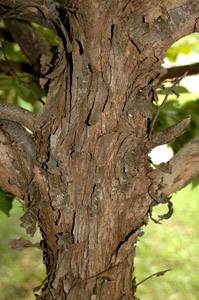 Photo: Steve Sanchez.
Photo: Steve Sanchez.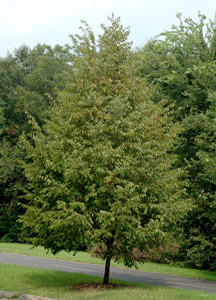 Photo: Steve Sanchez.
Photo: Steve Sanchez.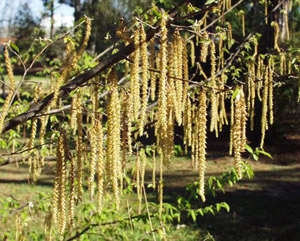 Photo: John Ruter.
Photo: John Ruter.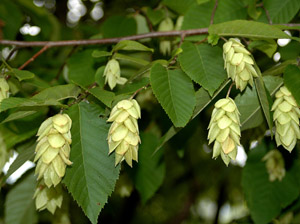 Photo: Steve Sanchez.
Photo: Steve Sanchez.Sourwood / Oxydendrum arboreum
Family: Heath / Ericaceae
Characteristics:
Sourwood is a deciduous, flowering tree with an oval form, medium texture and a medium to slow growth rate. Flowers are white, urn-shaped, 0.25 inch long and borne on 4- to 10-inch drooping spikes in June and July. The flowers make a showy display when nothing else is blooming. Fall color is pink to red or red-purple. Bark is grayish-brown-black, blocky and attractive as the tree ages.
Landscape Uses:
Sourwood is an all-season ornamental that grows more beautiful with age. It is best planted as a young tree or from a container plant because it is difficult to transplant as a large tree. Sourwood needs moist soils with good drainage and sun to partial shade. It has moderate drought tolerance. As Sourwood ages in the understory, it can develop picturesque shapes in its quest for light.
Size:
25 to 30 feet tall and 15 to 20 feet wide
Zones:
6b, 7a, 7b, 8a, 8b (8b with good culture)
Habitat:
Well-drained, gravelly soils on ridges and on upland slopes. It is found mostly in the mountains and Piedmont and occasionally in the Coastal Plain of the Southeast.
Native To:
New York to Florida, west to Louisiana, Arkansas and Illinois.
Comments:
The flowers are the source of sourwood honey.
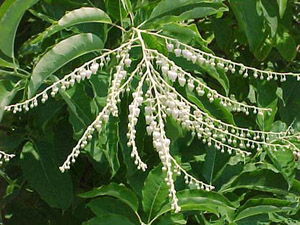 Photo: Gary Wade.
Photo: Gary Wade.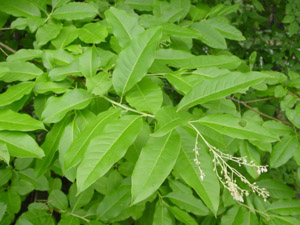 Photo: Gary Wade.
Photo: Gary Wade.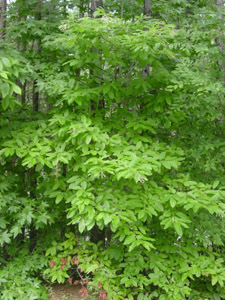 Photo: Gary Wade.
Photo: Gary Wade.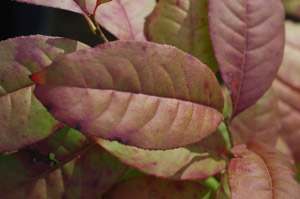 Photo: Ed McDowell.
Photo: Ed McDowell.Red Bay / Persea borbonia
Family: Laurel / Lauraceae
Characteristics:
Red Bay is a small evergreen tree with medium-coarse texture, medium growth rate and an upright-oval form. The foliage is aromatic when crushed and can be used as a substitute for bay leaves in cooking. Flowers are about 0.25 inches in size, yellow and not showy, but the dark blue fruit are moderately showy in the fall.
Size:
20 to 40 feet tall and 15 to 20 feet wide
Zones:
7b, 8a, 8b
Habitat:
Moist, acid, wet, sandy soils.
Native To:
Delaware to Florida and west to Texas.
Comments:
In shaded areas in its natural habitat, the leaves tend to be infected with a gall, which makes them look swollen and watery. Plants not growing in a swamp do not have this problem. A beautiful specimen can be seen next to the famous arch on the University of Georgia's Athens campus. Ambrosia beetle and an associated fungus are killing native populations in coastal Georgia.
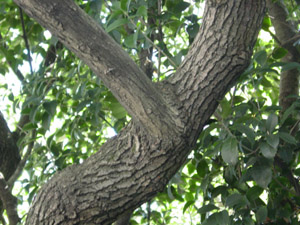 Photo: Gary Wade.
Photo: Gary Wade.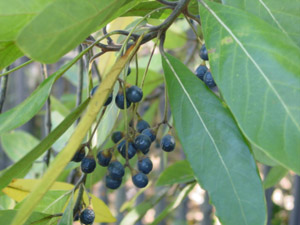 Photo: Gary Wade.
Photo: Gary Wade.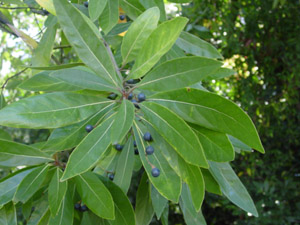 Photo: Gary Wade.
Photo: Gary Wade.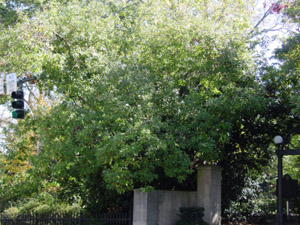 Photo: Gary Wade.
Photo: Gary Wade.Cherry Laurel / Prunus caroliniana
Family: Rose / Rosaceae
Characteristics:
Cherry Laurel is an evergreen tree with medium texture and a medium to fast growth rate. Form is oval to round. Fruit are berry-like, borne in clusters, green when young and turning black in fall. Foliage has a cherry-like odor when crushed.
Landscape Uses:
Cherry Laurel can be used as a specimen tree or screen plant. It prefers moist, well-drained soils and full sun to partial shade. However, it adapts to a wide variety of landscape sites.
Size:
15 to 30 feet tall and 10 to 20 feet wide
Zones:
7a, 7b, 8a, 8b
Habitat:
Moist, sandy stream banks.
Native To:
Coastal Virginia to northern Florida, and west to Louisiana.
Comments:
Re-seeding can be a problem in flower beds. The species is not landscape quality, but there are a number of improved cultivars that are landscape quality in the trade.
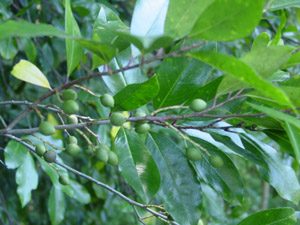 Photo: Gary Wade.
Photo: Gary Wade.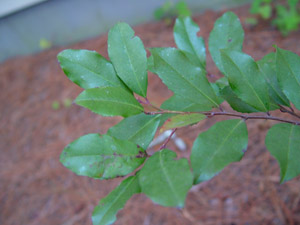 Photo: Chris Evans, Bugwood.org.
Photo: Chris Evans, Bugwood.org.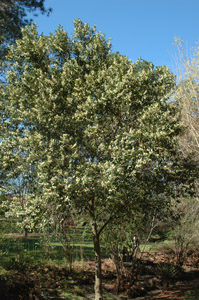 Photo: Chris Evans, Bugwood.org.
Photo: Chris Evans, Bugwood.org. CE.JPG) Photo: Chris Evans, Bugwood.org.
Photo: Chris Evans, Bugwood.org.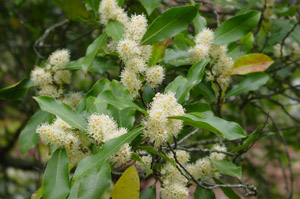 Photo: Gary Wade.
Photo: Gary Wade.Georgia Oak / Quercus georgiana
Red Oak Sub Genus: Erythrobalanus
Family: Beech / Fagaceae
Characteristics:
A small, deciduous oak associated with rocky soil, granite outcrops and dry slopes in the Piedmont. It has a compact crown and a slow growth rate. Some trees have a single trunk while others are multi-stemmed. Leaves have three to six lobes and are shiny on the upper surface, pale on the lower surface and resemble miniature Red Oak leaves. Leaf size is smaller than the large oaks, befitting its small tree status. Leaves turn bright red in fall.
Landscape Uses:
Georgia Oak is being used as a street tree or specimen tree and under power lines in the Georgia Piedmont.
Size:
20 to 40 feet tall and 15 feet wide
Zones:
7a, 7b, 8a
Habitat:
Rocky, dry areas with Chestnut Oak, Blackjack Oak and Post Oak in oak-pine forests. Found on granite outcrops.
Native To:
South Carolina, Georgia, Alabama.
Comments:
Acorns are an important food for wildlife.
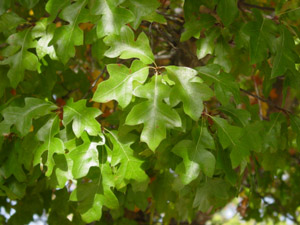 Photo: Gary Wade.
Photo: Gary Wade.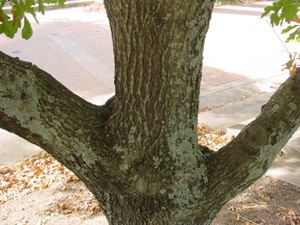 Photo: Gary Wade.
Photo: Gary Wade.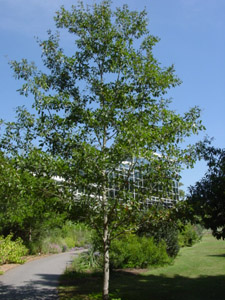 Photo: Gary Wade.
Photo: Gary Wade.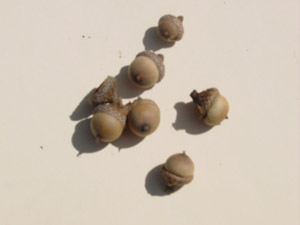 Photo: Gary Wade.
Photo: Gary Wade.Turkey Oak / Quercus laevis
Red Oak Sub Genus: Erythrobalanus
Family: Beech / Fagaceae
Characteristics:
Turkey Oak is a distinctive, small, deciduous tree with crooked branches. Some trees grow as multi-stemmed shrubs. Its three-lobed leaves are thought to resemble a turkey foot, hence the common name. Turkey Oak's red fall color brightens the landscape of the sandhills.
Landscape Uses:
Use Turkey Oak as a specimen understory tree. Its picturesque branching, glossy foliage, attractive fall color and dark, blocky-patterned bark add interest to landscapes.
Size:
30 to 40 feet tall and variable width
Zones:
8a, 8b
Habitat:
Sandhills of the upper Coastal Plain, associated with Longleaf Pine, Bluejack Oak and Sand Post Oak. These species are well adapted to drought stress and fire.
Native To:
South Carolina to Florida, and west to eastern Mississippi.
Comments:
The acorns are an important food source for turkey, deer and small rodents.
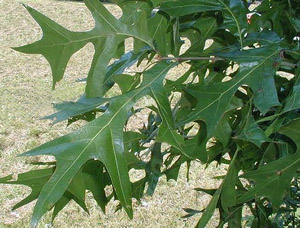 Photo: Shirley Denton.
Photo: Shirley Denton.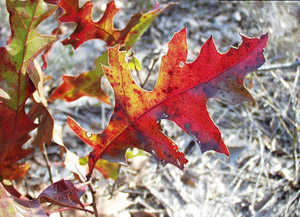 Photo: Shirley Denton.
Photo: Shirley Denton.
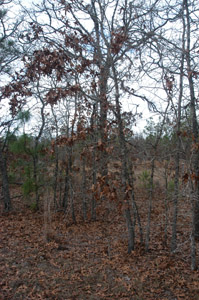 Photo: Ed McDowell.
Photo: Ed McDowell.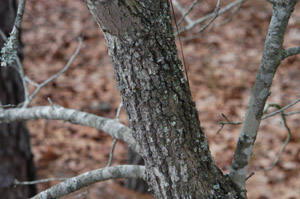 Photo: Ed McDowell.
Photo: Ed McDowell.Sassafras / Sassafras albidum
Family: Laurel / Lauraceae
Characteristics:
Sassafras is a deciduous tree with medium texture and a medium growth rate. Leaves are 3 to 7 inches long and 2 to 4 inches wide. Leaves vary in shape from unlobed (oval) to two-lobed (mitten-shaped) or three-lobed. Fall color ranges from bright yellow to fiery orange or vibrant red. Its ridged, reddish-brown bark and picturesque branching make an interesting winter silhouette. Yellow flowers appear in terminal racemes in late March, before the leaves emerge. It commonly occurs along fence rows in poor, dry soils.
Landscape Uses:
Use Sassafras as a specimen tree. Older trees are difficult to transplant because they have a tap root and sparse lateral roots. It is a tough plant, preferring moist, acid soils and full sun to partial shade.
Size:
25 to 30 feet tall with a spread of 15 to 20 feet
Zones:
6b, 7a, 7b, 8a, 8b
Habitat:
Disturbed sites, particularly acid, rocky soils of uplands. It is often found in old fields where it is a pioneer species throughout the South. Occurs in forest openings and along fence rows.
Native To:
Maine to Ontario and Michigan, south to Florida and west to Texas.
Comments:
Plants tend to spread from suckers. During fall migration, birds eat the seeds quickly. Crushed dry leaves are used for flavoring gumbos. It is prone to dieback in south Georgia.
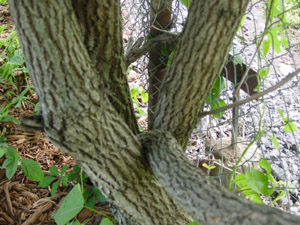 Photo: Gary Wade.
Photo: Gary Wade.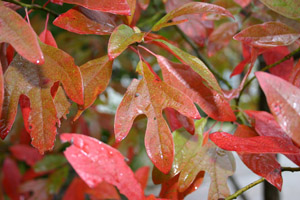 Photo: Theresa Schrum.
Photo: Theresa Schrum.
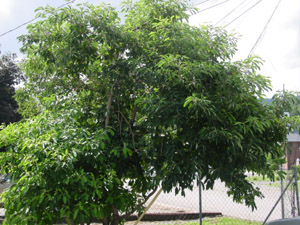 Photo: Gary Wade.
Photo: Gary Wade.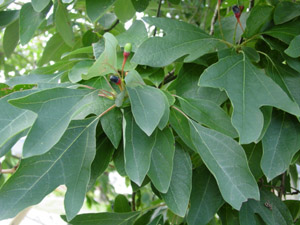 Photo: Gary Wade.
Photo: Gary Wade.
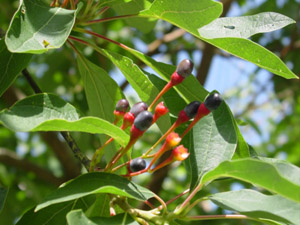 Photo: Gary Wade.
Photo: Gary Wade.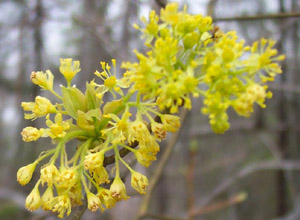 Photo: Michael Strickland.
Photo: Michael Strickland.Buckthorn Bully / Sideroxylon lycioides (Syn. Bumelia lycioides)
Family: Sapodilla / Sapotaceae
Characteristics:
This small deciduous tree or shrub seldom grows over 20 feet tall and often has short, twisted stems. Leaves are alternate, elliptical to lance-shaped, with an acute tip. They are conspicuously veined on both surfaces. When bruised, the leaves emit a fetid odor. Twigs are reddish-brown to gray, with 0.75-inch-long thorns. The twigs are pubescent in youth and become smooth with age. Sap is milky. Clusters of white flowers arise from the leaf axils in early summer. The drupe-like berry is purple-black, appearing in fall.
Landscape Uses:
Buckthorn Bully is an attractive small tree that should be used for naturalizing in wildlife habitats. It is especially attractive when flowers are present.
Size:
Up to 20 feet tall and wide
Zones:
7a, 7b, 8a, 8b
Habitat:
A variety of sites along the borders of streams and sandy soils of the Coastal Plain. It is also a hardwood understory tree on slopes and upland sites in the Piedmont.
Native To:
Virginia and Kentucky, south to northern Florida, west to Mississippi.
Comments:
The fruit are consumed by many species of birds. This plant is endangered in Florida.
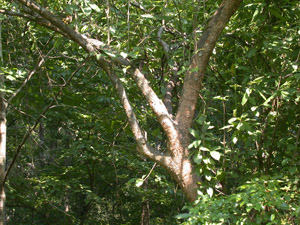 Photo: Ed Lambert.
Photo: Ed Lambert.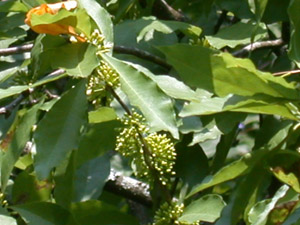 Photo: Ed Lambert.
Photo: Ed Lambert.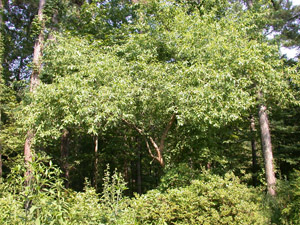 Photo: Ed Lambert.
Photo: Ed Lambert.Bigleaf Snowbell / Styrax grandifolius
Family: Storax / Styracaceae
Characteristics:
Bigleaf Snowbell is a small deciduous tree, normally single-stemmed, with fragrant, white flowers, 0.75 to 1 inch in size. The flowers occur in racemes, 4 to 8 inches long, in May and June. The leaves are dark green above with pubescence beneath and have no noticeable color change in the fall. Bigleaf Snowbell is not used very much because it is rare in the nursery trade.
Landscape Uses:
Bigleaf Snowbell is a fine, fragrant understory tree for moist woodlands.
Size:
Up to 20 feet tall by 10 feet wide
Zones:
7a, 7b, 8a, 8b
Habitat:
Deciduous mixed woods, usually in well-drained areas.
Native To:
Virginia to Florida, west to Louisiana, Arkansas and eastern Texas.
Comments:
It can be confused with American Snowbell (Styrax americanus), a multi-stemmed and smaller shrub that bears flowers from leaf axils, not in racemes and grows mainly along sandy stream banks in the Coastal Plain and Piedmont.
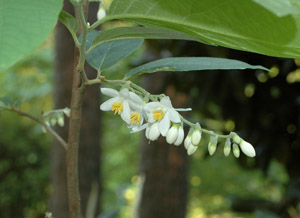 Photo: Steve Sanchez.
Photo: Steve Sanchez.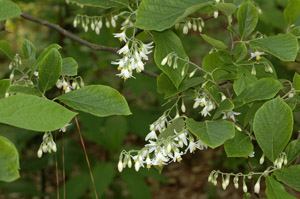 Photo: Steve Sanchez.
Photo: Steve Sanchez.
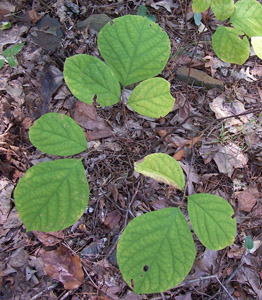 Photo: Michael Strickland.
Photo: Michael Strickland.
Shrubs
In this section:
- Adam's Needle, Beargrass, Spanish Bayonet, Threadleaf Yucca / Yucca filamentosa
- American Beautyberry / Callicarpa americana
- American Bladdernut / Staphylea trifolia
- American Snowbell / Styrax americanus
- Arrowwood Viburnum / Viburnum dentatum
- Black Titi, Buckwheat Tree / Cliftonia monophylla
- Blackhaw Viburnum / Viburnum prunifolium
- Bottlebrush Buckeye / Aesculus parviflora
- Button Bush / Cephalanthus occidentalis
- Common Witchhazel / Hamamelis virginiana
- Darrow's Blueberry, Glaucous Blueberry / Vaccinium darrowii
- Deerberry / Vaccinium stamineum
- Devil's Walkingstick / Aralia spinosa
- Drooping Leucothoe / Leucothoe fontanesiana
- Dwarf Fothergilla / Fothergilla gardenii
- Dwarf Palmetto / Sabal minor
- Fetterbush, Pipestem / Agarista populifolia
- Fetterbush / Lyonia lucida
- Sparkleberry / Vaccinium arboreum
- Florida Anise-Tree / Illicium floridanum
- Gallberry, Inkberry / Ilex glabra
- Georgia Basil / Clinopodium georgianum
- Groundsel Bush / Baccharis halimifolia
- Hillside Blueberry, Blue Ridge Blueberry / Vaccinium pallidum
- Honeycup / Zenobia pulverulenta
- Hoptree, Wafer-Ash / Ptelea trifoliata
- Horse-Sugar, Sweetleaf / Symplocos tinctoria
- Littlehip Hawthorn / Crataegus spathulata
- Mapleleaf Viburnum / Viburnum acerifolium
- Mayberry / Vaccinium elliottii
- Mountain Laurel / Kalmia latifolia
- Mountain Stewartia / Stewartia ovata
- Needle Palm / Rhapidophyllum hystrix
- Oakleaf Hydrangea / Hydrangea quercifolia
- Painted Buckeye / Aesculus sylvatica
- Pinckneya, Feverbark / Pinckneya bracteata
- Rabbiteye Blueberry Cultivars / Vaccinium virgatum
- Red Basil, Scarlet Calamint / Clinopodium coccinea
- Red Buckeye / Aesculus pavia
- Red Titi, Swamp Cyrilla / Cyrilla racemiflora
- Rhododendron & Deciduous Azalea Species
- Rhododendron, Evergreen Species
- Rusty Blackhaw / Viburnum rufidulum
- Saw Palmetto / Serenoa repens
- Small Anise-Tree, Yellow Anise-Tree / Illicium parviflorum
- Southern Highbush Blueberry / Vaccinium corymbosum
- Southern Wax Myrtle / Morella cerifera
- Spice-Bush / Lindera benzoin
- Strawberry-Bush / Euonymus americanus
- Summersweet Clethra / Clethra alnifolia
- Swamp-Haw / Viburnum nudum
- Sweetshrub / Calycanthus floridus
- Virginia Sweetspire / Itea virginica
- Winged Sumac / Rhus copallina
- Winterberry / Ilex verticillata
- Yellow-Root / Xanthorhiza simplicissima
Bottlebrush Buckeye / Aesculus parviflora
Family: Buckeye / Hippocastanaceae
Characteristics:
Bottlebrush Buckeye is a graceful, deciduous shrub. Leaves are palmate with five to seven leaflets. Many small, white flowers are borne in May and June on upright, cylindrical inflorescences, 8 to 12 inches long. They give the appearance of white "bottlebrushes" hovering above the plant. Fall color typically is yellow under the right environmental conditions. Fruit are capsules approximately 1.5 inches long. As plants age, new plants arise from the roots and the plants spread outward.
Landscape Uses:
Bottlebrush Buckeye is a flowering shrub useful as a single specimen or in shrub borders. It is a broad, spreading, multi-stemmed plant with many upright shoots, so it requires plenty of room in the landscape. It prefers fertile, acid, moist soils and partial shade, and it does not like hot, dry locations. Rejuvenate with heavy pruning in late winter.
Size:
8 to 12 feet tall with a spread of 8 to 15 feet
Zones:
7b, 8a, 8b (with partial shade in 8b)
Habitat:
An understory plant in moist locations in hardwood forests, often in association with streams.
Native To:
South Carolina, Georgia, Alabama and Florida.
Comments:
Seeds are valued by wildlife, particularly squirrels, chipmunks, deer and turkeys.
 Photo: Gary Wade.
Photo: Gary Wade.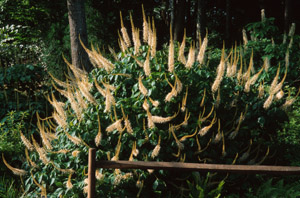 Photo: Hugh & Carol Nourse.
Photo: Hugh & Carol Nourse.
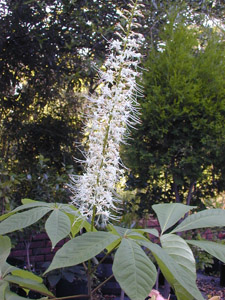 Photo: Ed McDowell.
Photo: Ed McDowell.Red Buckeye / Aesculus pavia
Family: Buckeye / Hippocastanaceae
Characteristics:
Red Buckeye is a clump-forming, round-topped, deciduous flowering shrub or small tree. The lustrous, dark green, palmate leaves have five leaflets. Scarlet flowers are borne in panicles 4 to 8 inches long and 2 to 3 inches wide in March and April. Fruit are capsules approximately 2 inches long, bearing one or two lustrous brown seeds.
Landscape Uses:
Red Buckeye is an attractive spring-flowering shrub useful in woodland settings where it gets filtered shade and moist conditions. It flowers well in dense shade. It loses its leaves early, often by late September. Scarlet, tubular flowers with protruding stamens are pollinated by ruby-throated hummingbirds.
Size:
12 to 15 feet tall and 8 to 10 feet wide
Zones:
7b, 8a, 8b
Habitat:
Swampy, marshy areas to fertile, moist, well-drained lower forest slopes.
Native To:
Virginia to Florida, west to Texas.
Comments:
Supports hummingbird spring migration. There are selections of this plant, but they are not readily available.
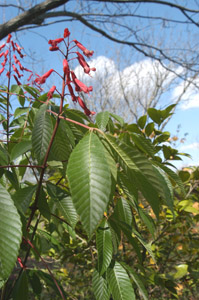 Photo: Ed McDowell.
Photo: Ed McDowell.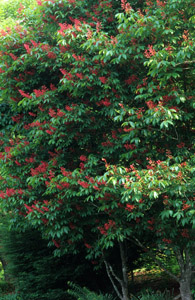 Photo: Hugh & Carol Nourse.
Photo: Hugh & Carol Nourse.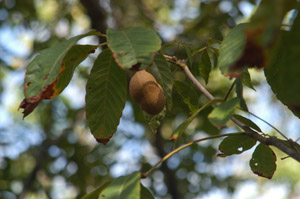 Photo: Ed McDowell.
Photo: Ed McDowell.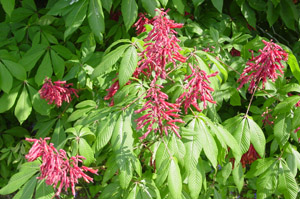 Photo: Gary Wade.
Photo: Gary Wade. Photo: Gary Wade.
Photo: Gary Wade.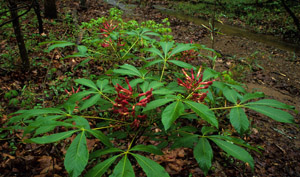 Photo: Hugh & Carol Nourse.
Photo: Hugh & Carol Nourse.Painted Buckeye / Aesculus sylvatica
Family: Buckeye / Hippocastanaceae
Characteristics:
Painted Buckeye is a large shrub or small tree. The leaves emerge early, in March, and vary from green to reddish-purple. Leaves are palmate, with five leaflets, each 4 to 6 inches long. The flowers (male and bisexual) occur together in 4- to 8-inch panicles in March and May. Flower color is extremely variable and ranges from yellow-green to creamy yellow or varying shades of pink. The smooth, leathery capsule contains one to three shiny, dark-brown seeds. Fruit set is normally minimal.
Landscape Uses:
Painted Buckeye prefers rich, moist soil in partial shade. It can be used as a specimen or in a grouping for naturalizing in moist woods.
Size:
6 to 20 feet tall
Zones:
7b, 8a
Habitat:
Rich woods and bottomlands of the Piedmont. Found on gentle slopes under oak, hickory and maple trees.
Native To:
Virginia to Georgia, west to Tennessee and Alabama.
Comments:
Hummingbirds use Painted Buckeye heavily as they move north during spring migration.
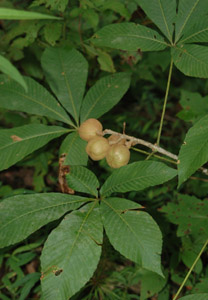 Photo: Wendy VanDyk Evans, Bugwood.org.
Photo: Wendy VanDyk Evans, Bugwood.org.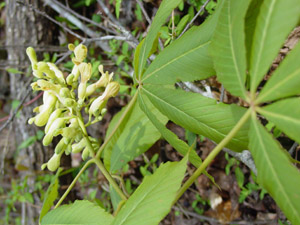 Photo: Cynthia Taylor.
Photo: Cynthia Taylor.Fetterbush or Pipestem / Agarista populifolia
Family: Heath / Ericaceae
Characteristics:
Fetterbush is a tall, multi-stemmed evergreen shrub with arching branches and bright green leaves. Flowers are small, fragrant, cream-colored, and urn-shaped, appearing in May and June. They are clustered in loose racemes arising from the leaf axils of the previous season’s growth. Fruit is a dry brown capsule.
Landscape Uses:
Fetterbush can be used as a specimen plant, to screen patios or yards, or to soften the corners of structures. Its arching habit and evergreen foliage add a wonderful year-round texture to the landscape. It can be pruned into a tree form or shaped as a hedge. It grows best in moist, well-drained soil in dappled shade or morning sun, but it tolerates full shade. For best appearance, remove old stems with regular pruning.
Size:
6 to 15 feet tall and 5 to 8 feet wide
Zones:
7a, 7b, 8a, 8b
Habitat:
Along Coastal Plain stream banks and at the edges of swamps and hammocks.
Native To:
South Carolina southward into peninsular Florida.
Comments:
This plant was once known as Florida Leucothoe (Leucothoe populifolia).
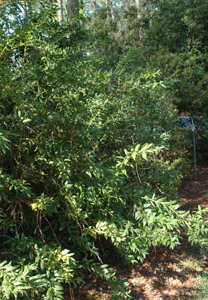 Photo: Chris Evans, Bugwood.org.
Photo: Chris Evans, Bugwood.org.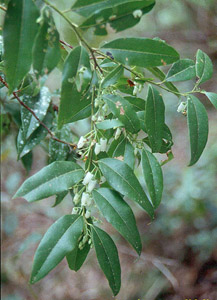 Photo: Guy Anglin.
Photo: Guy Anglin.
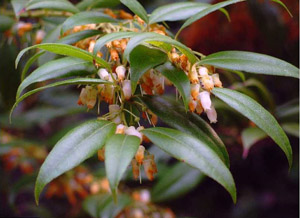 Photo: J.S. Peterson, USDA-NRCS PLANTS Database.
Photo: J.S. Peterson, USDA-NRCS PLANTS Database.Devil’s Walkingstick / Aralia spinosa
Family: Ginseng / Araliaceae
Characteristics:
Devil’s Walkingstick is a deciduous, tall, erect, single-stemmed shrub. Leaves are alternate, bipinnately compound, and 3 to 4 feet long. Stems are thorny. White flowers in July and August are arranged in terminal panicles and give the plant a lacy appearance. It seldom branches but forms colonies from root suckers. Fruits turn pinkish-purple and are showy for several months in late summer and fall. Fall leaf color is variable, from yellow to maroon or purple.
Landscape Uses:
Devil’s Walkingstick is a large, bold plant best used as a specimen or accent plant in the landscape. It grows best in moist, high organic soils in full sun to light shade. It is easy to transplant when young.
Size:
10 to 15 feet tall with a spread of 6 to 10 feet
Zones:
6b, 7a, 7b, 8a, 8b
Habitat:
Fertile woodland soils with high organic matter.
Native To:
Southern Pennsylvania, southern Indiana and eastern Iowa, south to Florida and west to eastern Texas.
Comments:
Suckers arising from the roots can be a maintenance problem if roots are disturbed. Fruit are a favorite food for migrating birds in fall.
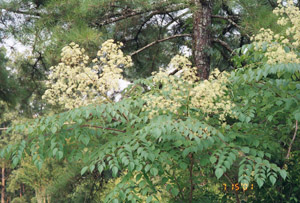 Photo: Theresa Schrum.
Photo: Theresa Schrum.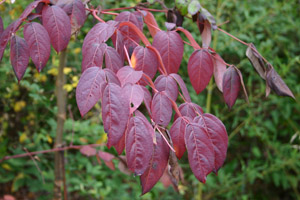 Photo: Theresa Schrum.
Photo: Theresa Schrum.
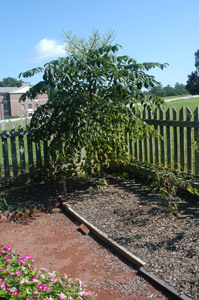 Photo: Ed McDowell.
Photo: Ed McDowell.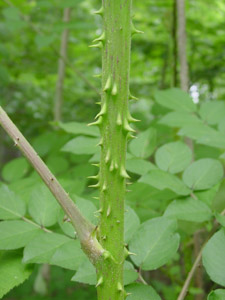 Photo: Gary Wade.
Photo: Gary Wade.
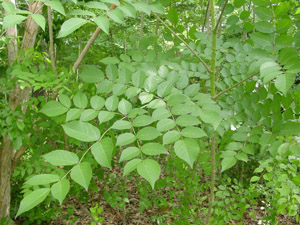 Photo: Gary Wade.
Photo: Gary Wade.Groundsel Bush / Baccharis halimifolia
Family: Daisy / Compositae
Characteristics:
Groundsel Bush is an evergreen to semi-evergreen flowering shrub. It spreads via suckers arising from the roots. It has an irregular oval form with upright branching. Flowers are indistinct, but seeds look like tiny white paint brushes and are quite showy in late summer.
Landscape Uses:
Use Groundsel Bush as a specimen plant or in a shrub border. It is tolerant of a wide variety of sites and is salt tolerant.
Size:
8 to 12 feet tall with a spread of 6 to 10 feet
Zones:
7b, 8a, 8b
Habitat:
Waste areas and beaches in the lower Coastal Plain; also found on drier upland sites.
Native To:
Coastal areas from Massachusetts to Florida and west to Texas.
Comments:
Seeds have traveled north on car tires. It can be invasive.
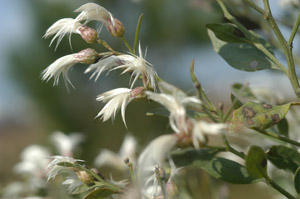 Photo: Ed McDowell.
Photo: Ed McDowell. 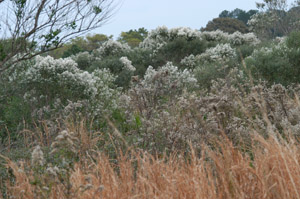 Photo: Ed McDowell.
Photo: Ed McDowell. 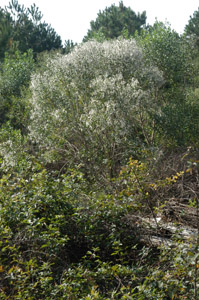 Photo: Ed McDowell.
Photo: Ed McDowell. 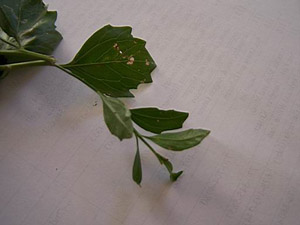 Photo: Todd Hurt.
Photo: Todd Hurt.
American Beautyberry / Callicarpa americana
Family: Verbena / Verbenaceae
Characteristics:
American Beautyberry is a deciduous shrub with coarse texture and medium to fast growth rate. It has an irregular, spreading, loosely branched, upright growth habit. Light pink to lavender flowers borne from June to August are not showy, but the intense color of the purple fruit clustered around the stems in fall makes a dramatic display.
Landscape Uses:
American Beautyberry is a great accent in the shrub border. It will grow in most soils and prefers full sun for best fruit production. It is adaptable to a wide variety of sites. The coarse-textured leaves and showy fruit make this species desirable for naturalistic settings or mixed shrub borders. Plant in groups of three, five or seven for a dramatic statement.
Size:
4 to 8 feet tall with a spread of 4 to 6 feet
Zones:
6b, 7a, 7b, 8a, 8b
Habitat:
A variety of sites from wet to dry, sun to shade.
Native To:
Maryland, south to Florida, west to Texas and Oklahoma.
Comments:
A white-berried form is available.
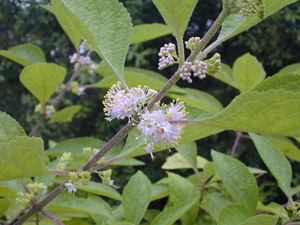 Photo: Ed McDowell.
Photo: Ed McDowell.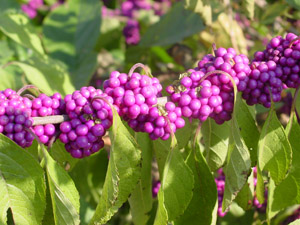 Photo: Gary Wade.
Photo: Gary Wade.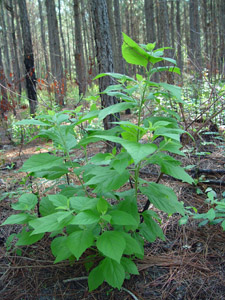 Photo: Chris Evans, Bugwood.org.
Photo: Chris Evans, Bugwood.org.Sweetshrub / Calycanthus floridus
Family: Calycanthus / Calycanthaceae
Characteristics:
Sweetshrub is a deciduous, flowering shrub with medium texture, medium growth rate and an upright oval to mounding form. It tends to form colonies by spreading outward from the mother plant. Foliage is aromatic when crushed. Flowers, borne in April and May, are highly fragrant, with a clove-like aroma. Fall color is yellow.
Landscape Uses:
Use Sweetshrub as a specimen plant or in groups within a shrub border or woodland setting. It is a nice choice for a fragrance garden. It prefers moist, fertile soils in full sun to partial shade, but it is moderately tolerant of adverse conditions.
Size:
8 to 10 feet tall with a spread of 4 to 6 feet
Zones:
6b, 7a, 7b, 8a, 8b
Habitat:
Found in fertile woodlands along sandy streams and hillsides. Grows in acid soils in the Southeast, predominantly in the Piedmont and mountains.
Native To:
Virginia to Florida.
Comments:
A yellow-flowered cultivar is available in the nursery trade.
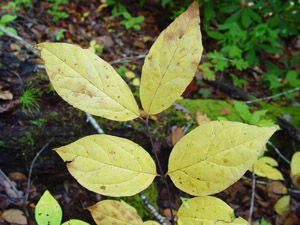 Photo: Gary Wade.
Photo: Gary Wade.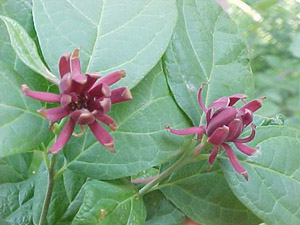 Photo: Gary Wade.
Photo: Gary Wade.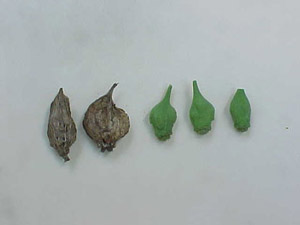 Photo: Gary Wade.
Photo: Gary Wade. Photo: Gary Wade.
Photo: Gary Wade.Button Bush / Cephalanthus occidentalis
Family: Madder / Rubiaceae
Characteristics:
Button Bush is a deciduous, flowering shrub with medium texture and a medium growth rate. It has an open, rounded form with spreading branches. The flowers are round, 1 to 2 inches in diameter, and are fragrant. The flowers look like creamy-white balls covered with fiber optic tubes. They appear from June to August. Fruit are hard, round, reddish-brown capsules containing two to four nutlets. This is an unusual-looking plant in flower and fruit.
Landscape Uses:
Use Buttonbush as a specimen plant or in group plantings adjacent to ponds and streams, or in other moist areas. It prefers full sun and moist to wet soils. Cut the plant back heavily every few years to rejuvenate because young stems are the most attractive.
Size:
15 to 20 feet tall with a spread of 10 to 15 feet
Zones:
6b, 7a, 7b, 8a, 8b
Habitat:
Sunny, wet, marshy areas; shrubby swamps and pond edges.
Native To:
New Brunswick to Florida, west to Southern Minnesota, Nebraska, Oklahoma and Arizona. Also found in southern New Mexico and southern California.
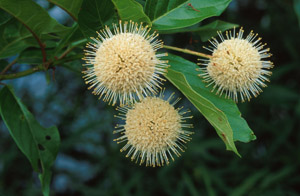 Photo: Hugh & Carol Nourse.
Photo: Hugh & Carol Nourse. Photo: Ed McDowell.
Photo: Ed McDowell.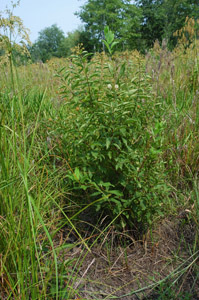 Photo: Ed McDowell.
Photo: Ed McDowell.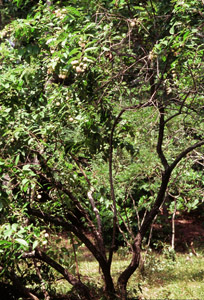 Photo: Ted Bodner, Bugwood.org.
Photo: Ted Bodner, Bugwood.org.Summersweet Clethra, Sweet Pepperbush / Clethra alnifolia
Family: Clethraceae
Characteristics:
Summersweet Clethra is a deciduous, colony-forming shrub. Leaves are alternate, oblong, 2 to 4 inches long and 1 to 2 inches wide, and sharply serrated along the margins. Flowers are fragrant, white to whitish-pink, and are borne in erect terminal clusters from late June through August. Fruit are small, brown capsules.
Landscape Uses:
Summersweet Clethra is an excellent plant for moist areas and almost any soil type. It will grow in full sun to partial shade. Avoid planting it in drought-prone sites.
Size:
6 to 10 feet tall with a spread of 3 to 5 feet
Zones:
7a, 7b, 8a, 8b
Habitat:
Thickets in low, wet areas; bays, bogs, streams and wet pine savannahs in the Coastal Plain.
Native To:
Maine to Florida, west to coastal Texas.
Comments:
Attracts butterflies. Several cultivars are available.
 Photo: Theresa Schrum.
Photo: Theresa Schrum.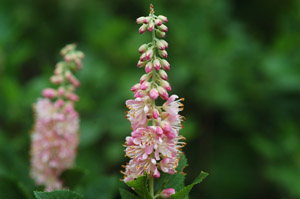 Photo: Ed McDowell.
Photo: Ed McDowell.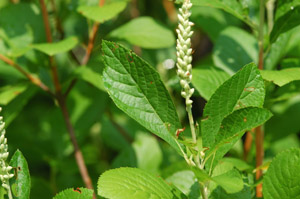 Photo: Ed McDowell.
Photo: Ed McDowell.Black Titi, Buckwheat Tree / Cliftonia monophylla
Family: Cyrilla / Cyrillaceae
Characteristics:
Black Titi, or Buckwheat Tree, is an evergreen, multi-stemmed, flowering shrub or small tree with medium-fine texture and a medium-slow growth rate. Its form is oval to round. Leaves are leathery, thick and glossy, dark green above and a pale, chalky green below. The bark is dark and scaly. Fragrant white to whitish-pink flowers are borne in early March in terminal clusters 3 inches long. Fruit is a winged, corky drupe, closely resembling buckwheat. The foliage turns reddish-scarlet in winter.
Landscape Uses:
Use Black Titi for screening or as a specimen flowering plant. Because it is attractive to bees when flowering, it may be best to plant it away from the public. It prefers moist, acid soils high in organic matter and full sun to light shade.
Size:
15 to 20 feet tall with a spread of 8 to 12 feet
Zones:
7b, 8a, 8b
Habitat:
Occurs in areas that are wet during winter months. It is usually found growing with members of the heath family (ericaceous plants).
Native To:
Georgia to Florida, west to Louisiana.
Comments:
Flowers are an important nectar source for honey bees.
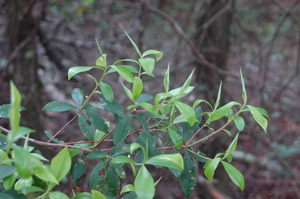 Photo: Chris Evans, Bugwood.org.
Photo: Chris Evans, Bugwood.org.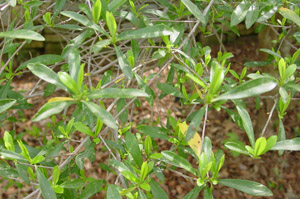 Photo: Gary Wade.
Photo: Gary Wade. CE.JPG) Photo: Chris Evans, Bugwood.org.
Photo: Chris Evans, Bugwood.org.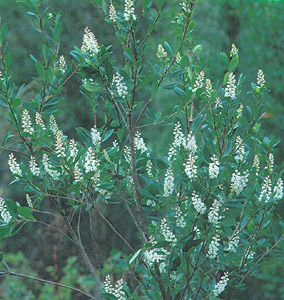 Photo: Walter Hodge.
Photo: Walter Hodge.
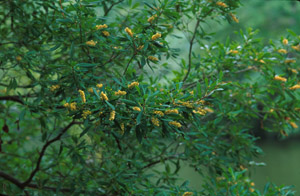 Photo: Hugh & Carol Nourse.
Photo: Hugh & Carol Nourse.Red Basil, Scarlet Calamint / Clinopodium coccinea (Syn. Satureja coccinea)
Family: Mint / Lamiaceae
Characteristics:
Red Basil is a small, semi-evergreen shrub with aromatic leaves. Flowers are tubular, brilliant scarlet, and are borne from late summer into fall. It is a striking plant in bloom. Habit is loose, open and erect.
Landscape Uses:
Red Basil should be planted on sandhills or sand ridges of the Coastal Plain. It prefers dry sites.
Size:
Up to 2½ feet high with a spread of 2 feet
Zones:
8a, 8b
Habitat:
Thrives in dry pine barrens, and on sandhills and ridges of the Coastal Plain.
Native To:
Georgia to Mississippi.
Comments:
Deer shun Red Basil’s aromatic foliage. Hummingbirds love its flowers.
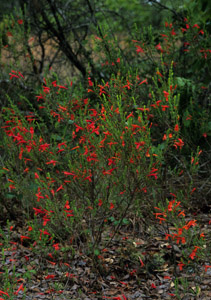 Photo: Hugh & Carol Nourse.
Photo: Hugh & Carol Nourse.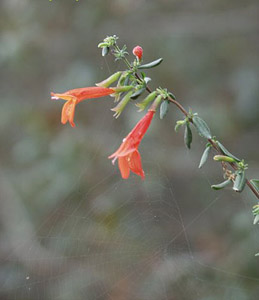 Photo: Shirley Denton.
Photo: Shirley Denton.Georgia Basil / Clinopodium georgianum (Syn. Satureja georgiana)
Family: Mint / Lamiaceae
Characteristics:
Georgia Basil is a low, loosely sprawling, freely branched, semi-evergreen shrub. The leaves are opposite and aromatic. Tubular pink to lavender flowers are borne from August to October.
Landscape Uses:
Georgia Basil is a good landscape plant for dry soils in full sun. It also naturalizes in deciduous woods as a ground cover in rocky, shaded areas. It often is found growing naturally where little else can survive. Shows potential for naturalizing on harsh, dry sites.
Size:
Up to 2 feet tall and the same width
Zones:
7b, 8a, 8b
Habitat:
Dry, rocky woods and bluffs, and land adjacent to rock outcrops.
Native To:
North Carolina to Florida and west to Mississippi.
Comments:
It tends to naturalize in situations that suit it, and it reseeds prolifically. It can easily be pruned back to about half its size. Deer shun its aromatic foliage.
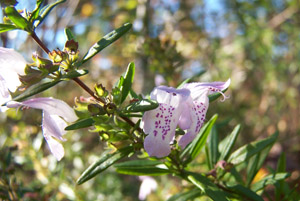 Photo: Michael Strickland.
Photo: Michael Strickland.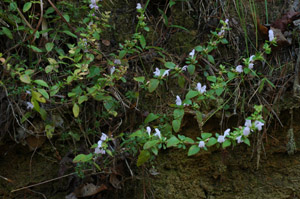 Photo: Hugh & Carol Nourse.
Photo: Hugh & Carol Nourse.
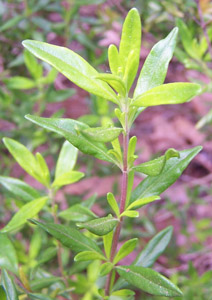 Photo: Michael Strickland.
Photo: Michael Strickland.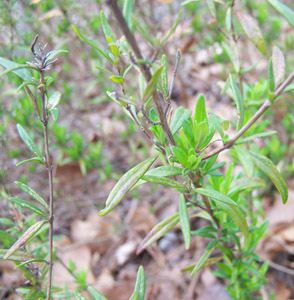 Photo: Michael Strickland.
Photo: Michael Strickland.
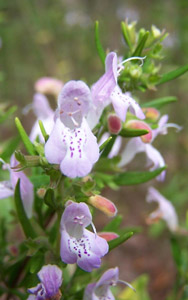 Photo: Michael Strickland.
Photo: Michael Strickland.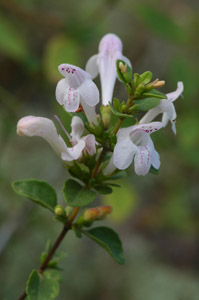 Photo: Hugh & Carol Nourse.
Photo: Hugh & Carol Nourse.
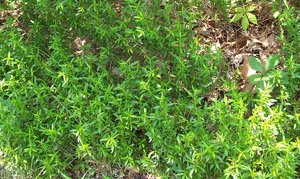 Photo: Michael Strickland.
Photo: Michael Strickland.Littlehip Hawthorn / Crataegus spathulata
Family: Rose / Rosaceae
Characteristics:
Littlehip Hawthorn is a large shrub or small, deciduous tree. White flowers in a flat cluster emerge from the leaf axils in spring. Individual fruit are 0.5 inches in size, dull red, and borne in showy clusters. Bark exfoliates with age, exposing an orange-gray-brown inner bark.
Landscape Uses:
Use it in a shrub border or for wildlife food along the woodland edge.
Size:
15 to 20 feet tall by 10 to 12 feet wide
Zones:
7a, 7b, 8a, 8b
Habitat:
Wet or moist soils, stream banks, swamps and borders of woods.
Native To:
Virginia, south to Florida, west to Texas and Missouri.
Comments:
A good wildlife plant, especially for birds.
 Photo: Steve Sanchez.
Photo: Steve Sanchez.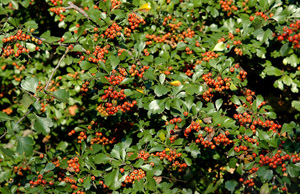 Photo: Steve Sanchez.
Photo: Steve Sanchez.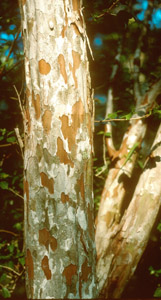 Photo: Ron Lance.
Photo: Ron Lance.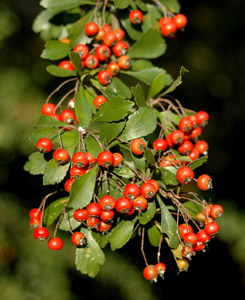 Photo: Steve Sanchez.
Photo: Steve Sanchez.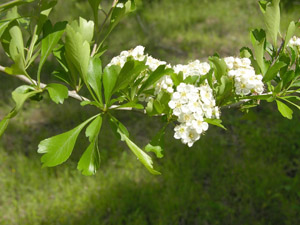 Photo: Ron Lance.
Photo: Ron Lance.Red Titi, Swamp Cyrilla / Cyrilla racemiflora
Family: Cyrilla / Cyrillaceae
Characteristics:
Red Titi is a large shrub or small tree with medium texture and medium growth rate. Form is rounded and low-branching. Foliage is medium-green. It is evergreen in south Georgia and deciduous in northern Georgia. Fall color ranges from orange to scarlet. Fragrant white flowers are borne in summer on slender 3- to 6-inch long spikes. They are arranged in a drooping whorl at the base of the current season's growth. Twigs and young stems are angled and slightly winged.
Landscape Uses:
Use Red Titi as a flowering specimen plant. It is attractive to bees, so use it away from public areas. It prefers moist soils with good organic content and full sun to light shade. It is not drought tolerant.
Size:
10 to 25 feet tall with a spread of 10 to 20 feet
Zones:
7b, 8a, 8b
Habitat:
Wet, swampy areas of the Coastal Plain.
Native To:
Virginia to Florida, west to Texas.
Comments:
Attractive to bees.
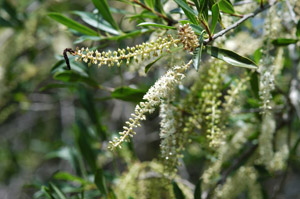 Photo: Ed McDowell.
Photo: Ed McDowell.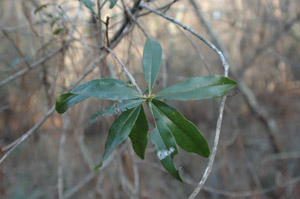 Photo: Chris Evans, Bugwood.org.
Photo: Chris Evans, Bugwood.org.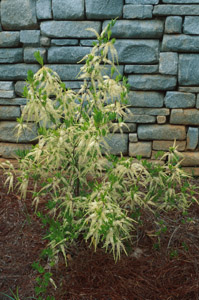 Photo: Hugh Nourse.
Photo: Hugh Nourse.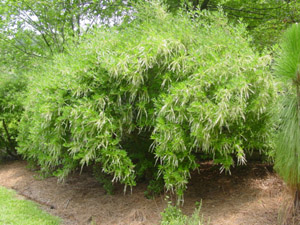 Photo: Gary Wade.
Photo: Gary Wade.Strawberry-Bush / Euonymus americanus
Family: Euonymus / Celastraceae
Characteristics:
Strawberry-Bush is a deciduous shrub having medium texture and medium growth rate. Form is upright with irregular branching. Stems are green. Flowers, borne in May and June, are green and indistinct. Fruit is a warty, dark pink capsule about one inch wide, splitting to reveal scarlet-colored seeds in September and October. It is also commonly called “Hearts-a-Bustin” to describe the colorful, heart-shaped fruit that appears to be exploding from the capsule.
Landscape Uses:
Use in group plantings in forested settings or adjacent to water. Moist, well-drained soils and partial shade are preferred. Not for full sun or stressful environments.
Size:
3 to 5 feet tall with a spread of 2 to 3 feet
Zones:
6b, 7a, 7b, 8a, 8b
Habitat:
Moist, fertile soils in woodlands, along streams and on bluffs.
Native To:
New York south to Florida, west to Texas.
Comments:
Provides food for variety of wildlife.
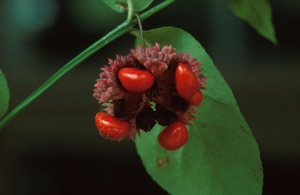 Photo: Hugh & Carol Nourse.
Photo: Hugh & Carol Nourse.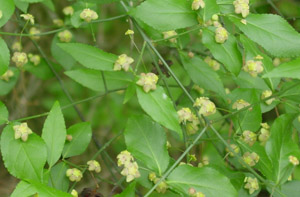 Photo: Gary Wade.
Photo: Gary Wade.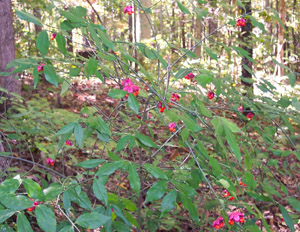 Photo: Michael Strickland.
Photo: Michael Strickland.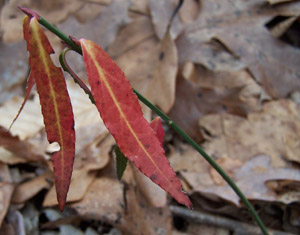 Photo: Michael Strickland.
Photo: Michael Strickland.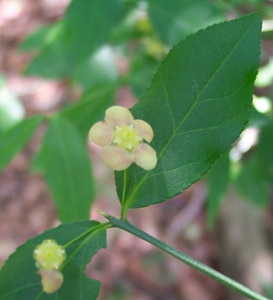 Photo: Michael Strickland.
Photo: Michael Strickland.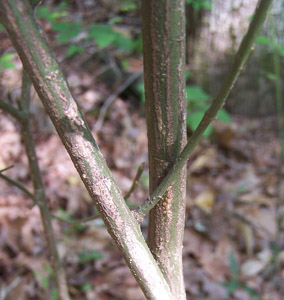 Photo: Michael Strickland.
Photo: Michael Strickland.Dwarf Fothergilla / Fothergilla gardenii
Family: Witchhazel / Hamamelidaceae
Characteristics:
Dwarf Fothergilla is a deciduous flowering shrub with medium-coarse texture, slow growth rate and rounded to spreading habit. White, honey-scented flowers appear in April before the foliage. Blue-green, pest-free foliage turns brilliant orange-scarlet in fall.
Landscape Uses:
Dwarf Fothergilla is a good plant for foundation planting or a perennial border. It looks particularly nice in mass plantings or in conjunction with rhododendrons and azaleas. It requires acid soils high in organic matter, good drainage and adequate moisture. It does well in full sun to partial shade. Foliage remains relatively pest free in north Georgia, but in south Georgia a fungal disease may defoliate the plant.
Size:
2 to 3 feet tall with a spread of 2 to 3 feet
Zones:
7a, 7b, 8a, 8b
Habitat:
The Coastal Plain on the banks of low, water-filled depressions (pocosins); pine savannahs and around ponds.
Native To:
North Carolina to the Florida panhandle; southern Alabama.
Comments:
Several cultivars are available.
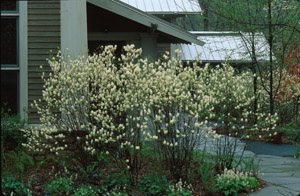 Photo: Hugh & Carol Nourse.
Photo: Hugh & Carol Nourse.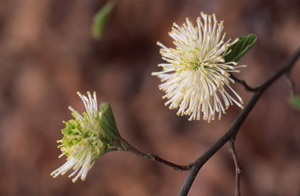 Photo: Carol Nourse.
Photo: Carol Nourse.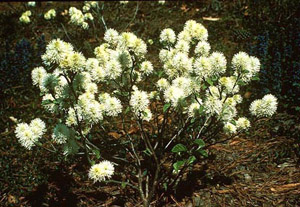 Photo: Gary Wade.
Photo: Gary Wade.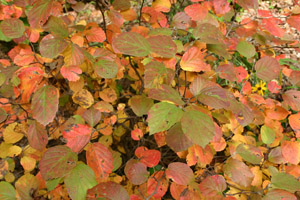 Photo: Theresa Schrum.
Photo: Theresa Schrum.
 Photo: J.S. Peterson, USDA-NRCS PLANTS Database.
Photo: J.S. Peterson, USDA-NRCS PLANTS Database.Common Witchhazel / Hamamelis virginiana
Family: Witchhazel / Hamamelidaceae
Characteristics:
Common Witchhazel is a deciduous shrub or small tree with medium texture and a medium growth rate. Yellow, fragrant flowers are borne in November and have four strap-shaped petals. Fruit are capsules having four sharp-curved points on their ends. Seeds are not released until 12 months after flowering. Fall color is usually bright yellow. Stems are smooth gray to grayish-brown.
Landscape Uses:
Use Common Witchhazel as a specimen plant in the shrub border. Establish as small plants or as container-grown specimens because of the sparse root system. It prefers moist soils in sun to shade and is not drought tolerant.
Size:
20 to 30 feet tall and 20 to 25 feet wide
Zones:
6b, 7a, 7b, 8a
Habitat:
Moist soils in the understory of hardwood forests and sandhills.
Native To:
Nova Scotia to Ontario, south to Florida, west to Texas.
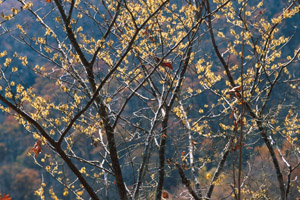 Photo: Hugh & Carol Nourse.
Photo: Hugh & Carol Nourse. CE.JPG) Photo: Chris Evans, Bugwood.org.
Photo: Chris Evans, Bugwood.org.
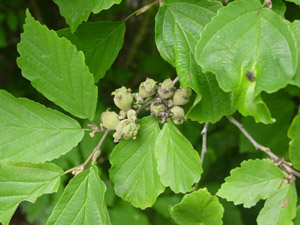 Photo: Gary Wade.
Photo: Gary Wade.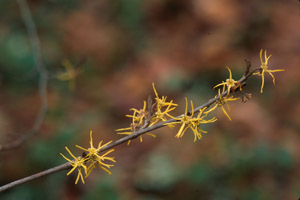 Photo: Hugh & Carol Nourse.
Photo: Hugh & Carol Nourse.
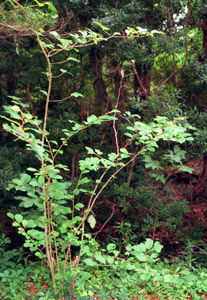 Photo: Ted Bodner, Bugwood.org.
Photo: Ted Bodner, Bugwood.org.Oakleaf Hydrangea / Hydrangea quercifolia
Family: Hydrangea / Hydrangeaceae
Characteristics:
Oakleaf Hydrangea is a deciduous flowering shrub with coarse texture and a medium to fast growth rate. Its form is round with many upright branches. Large, fragrant, white, terminal flower clusters (panicles) up to 12 inches in length are borne in May and June on the previous season’s growth. Flowers fade to pinkish-white, then light brown. Fall color is excellent and varies from red to purple. Bark on older plants exfoliates. The plant is stoloniferous and spreads outward over time.
Landscape Uses:
Use Oakleaf Hydrangea as a specimen plant or in groupings. Plant in moist, well-drained soils and partial shade. Avoid planting in hot, dry sites. Prune after flowering.
Size:
6 to 8 feet tall with a spread of 6 to 8 feet
Zones:
6b, 7a, 7b, 8a, 8b
Habitat:
Moist, well-drained, acid soils; usually along streams. Found predominantly in the Piedmont.
Native To:
Tennessee, the Carolinas, Georgia, Florida, Alabama, Mississippi and Louisiana.
Comments:
Several cultivars are available.
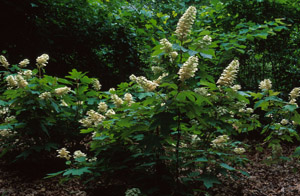 Photo: Hugh & Carol Nourse.
Photo: Hugh & Carol Nourse.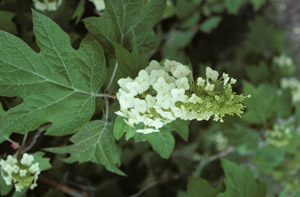 Photo: Gary Wade.
Photo: Gary Wade.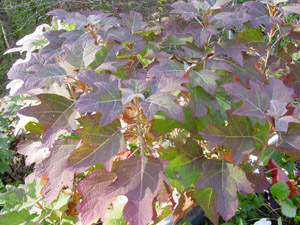 Photo: Gary Wade.
Photo: Gary Wade.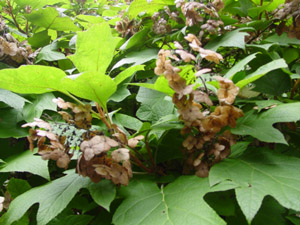 Photo: Gary Wade.
Photo: Gary Wade.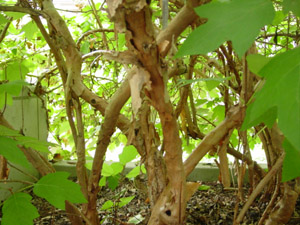 Photo: Gary Wade.
Photo: Gary Wade.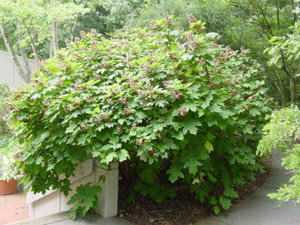 Photo: Gary Wade.
Photo: Gary Wade.Gallberry or Inkberry / Ilex glabra
Family: Holly / Aquifoliaceae
Characteristics:
Gallberry, or Inkberry, is a broadleaf evergreen shrub with medium-fine texture, medium growth rate and an upright-oval form. It spreads by stolons that root at their nodes and form new shoots. Flowers are small and indistinct. Fruit are dark berries, appearing in fall.
Landscape Uses:
Use Gallberry in mass plantings or as a single specimen. It is often used as a wildlife plant. Plant in sun to shade and moist soils. It will not tolerate drought.
Size:
6 to 8 feet tall with a spread of 4 to 6 feet
Zones:
7a, 7b, 8a, 8b
Habitat:
Pine flatwoods, bogs, bays and pocosins.
Native To:
Nova Scotia to Florida; west to Missouri, Mississippi and Texas.
Comments:
Gallberry is an excellent source of nectar for both native and honey bees. Its abundant fruit is an important food for wildlife. Many cultivars are available.
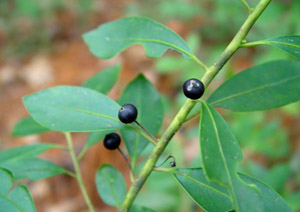 Photo: Chris Evans, Bugwood.org.
Photo: Chris Evans, Bugwood.org.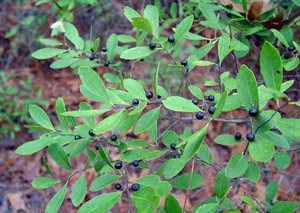 Photo: Chris Evans, Bugwood.org.
Photo: Chris Evans, Bugwood.org.
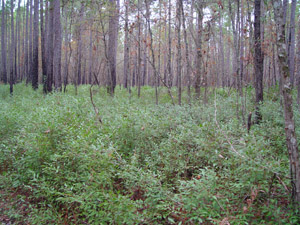 Photo: Chris Evans, Bugwood.org.
Photo: Chris Evans, Bugwood.org.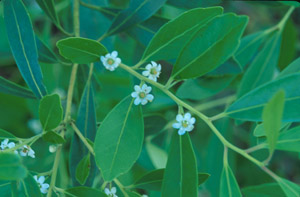 Photo: Hugh & Carol Nourse.
Photo: Hugh & Carol Nourse.Winterberry / Ilex verticillata
Family: Holly / Aquifoliaceae
Characteristics:
Winterberry is a deciduous shrub prized for its colorful red berries. Flowers are borne on short stalks arising at the leaf axils in April and May. Female and male flowers are borne on separate plants, so both sexes are required to form berries on female plants. Bark is gray and attractive.
Landscape Uses:
Use Winterberry as a specimen plant, for screening, hedges or in mixed borders. The showy fruit are striking in the winter landscape and are attractive to birds.
Size:
8 to 10 feet tall with a spread of 4 to 5 feet
Zones:
6b, 7a, 7b, 8a
Habitat:
Wet woods, bogs, stream banks and springheads of the Coastal Plain and lower Piedmont.
Native To:
Nova Scotia south to Florida, west to eastern Texas, north to Minnesota and Western Ontario.
Comments:
There are many cultivars in the trade. It provides an excellent food source for wildlife.
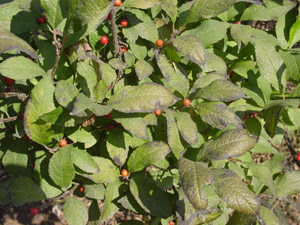 Photo: Gary Wade.
Photo: Gary Wade.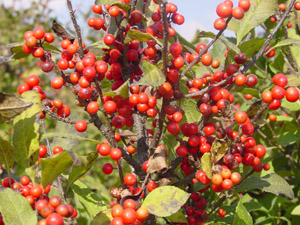 Photo: Gary Wade.
Photo: Gary Wade.
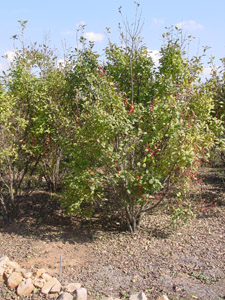 Photo: Gary Wade.
Photo: Gary Wade. Photo: Theresa Schrum.
Photo: Theresa Schrum.Florida Anise-Tree / Illicium floridanum
Family: Illicium / Illiciaceae
Characteristics:
Florida Anise-Tree is a broadleaf, evergreen shrub. It has a variable habit, generally upright and compact, with many branches. Leaves are elliptical, 4 to 6 inches long and 1 to 2 inches wide. Flowers appear in April and May and are dark red with 20 to 30 petals. Foliage is aromatic when crushed. Fruit are one to 1.5 inches wide and star-like in appearance. Young fruit are green, fade to yellow, then to brown. They contain shiny, BB-like brown seeds.
Landscape Uses:
Use Florida Anise-Tree as a specimen shrub in shaded, moist areas. It will require pruning to maintain its shape.
Size:
9 to 12 feet tall with a spread of 3 to 5 feet
Zones:
7a, 7b, 8a, 8b
Habitat:
Swamps and low hammocks in the Coastal Plain.
Native To:
Florida to Louisiana.
Comments:
Several cultivars are available.
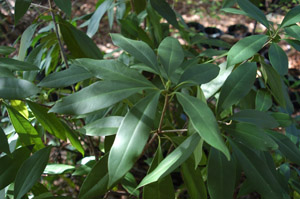 Photo: Ed McDowell.
Photo: Ed McDowell.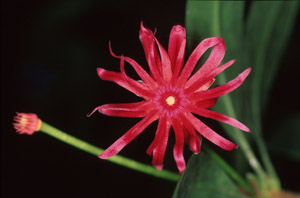 Photo: Fred Mileshko.
Photo: Fred Mileshko.
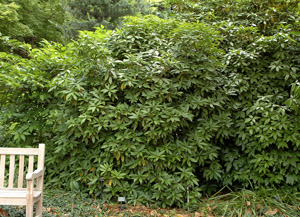 Photo: Steve Sanchez.
Photo: Steve Sanchez.Small Anise-Tree or Yellow Anise-Tree / Illicium parviflorum
Family: Illicium / Illiciaceae
Characteristics:
Small Anise-Tree is a large evergreen shrub or small tree with medium texture and a medium-fast growth rate. Form is upright and pyramidal. The rich, light green aromatic foliage has a pungent scent when crushed. Yellow-green flowers, 0.5-inches wide, are borne in June and are often hidden among the foliage. Fruit are star-shaped with many points.
Landscape Uses:
Use Small Anise-Tree as a specimen plant and for screening or hedges. Some pruning will be necessary. It establishes easily in moist soils in full sun to light shade. Growth is more dense in the sun, and loose and open in the shade.
Size:
8 to 15 feet tall with a spread of 6 to 10 feet
Zones:
7a, 7b, 8a, 8b
Habitat:
Sandy, wet areas along streams, bays and hammocks.
Native To:
Southern Georgia and Florida.
Comments:
This is one of the most rugged of all the Illicium species, according to Michael Dirr.
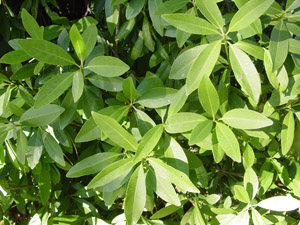 Photo: Gary Wade.
Photo: Gary Wade.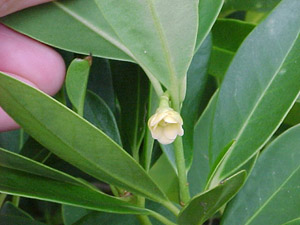 Photo: Gary Wade.
Photo: Gary Wade.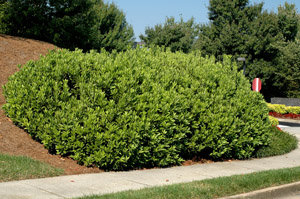 Photo: Steve Sanchez.
Photo: Steve Sanchez.Virginia Sweetspire / Itea virginica
Family: Currant / Grossulariaceae
Characteristics:
Virginia Sweetspire, a deciduous, flowering shrub with medium texture and medium growth rate, has a spreading habit with erect, clustered branches. White, fragrant, spike-like flowers are borne in April and May on the previous year’s growth. Fall color is spectacular crimson-red.
Landscape Uses:
Virginia Sweetspire is attractive when used in mass plantings or as a specimen plant. It prefers moist, fertile soils and full sun to light shade. Areas adjacent to streams or ponds are ideal. It is a vigorous grower when provided good conditions, but its performance will be disappointing on poor sites. It spreads outward by root suckers to form colonies.
Size:
4 to 6 feet tall with a spread of 4 to 8 feet
Zones:
7a, 7b, 8a, 8b
Habitat:
Wet, boggy areas and along wooded streams.
Native To:
New Jersey to Florida; west to Missouri, Louisiana and east Texas.
Comments:
Many cultivars are available.
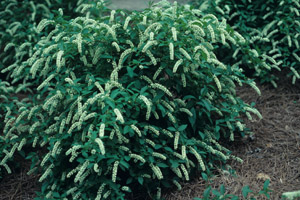 Photo: Gary Wade.
Photo: Gary Wade.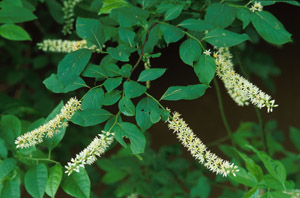 Photo: Hugh & Carol Nourse.
Photo: Hugh & Carol Nourse.Mountain Laurel / Kalmia latifolia
Family: Heath / Ericaceae
Characteristics:
Mountain Laurel is an evergreen flowering shrub having a medium texture and a slow growth rate. More upright when young, mature specimens have a picturesque, broad-spreading form with irregular branches. Delicate white- to rose-colored, cup-shaped blooms with purple markings on the petals appear in April. The flowers are one inch across and borne in terminal clusters. Bark on old plants is smooth and red-brown.
Landscape Uses:
Mountain Laurel can be used as a specimen plant, in mass plantings, or in shrub borders. Young plants transplant best. Plant in moist, well-drained soils with morning sun and afternoon shade. North- or east-facing slopes are preferred. Keep the roots cool by mulching, and protect the plants from afternoon sun.
Size:
15 to 20 feet tall with a spread of 8 to 10 feet
Zones:
6b, 7a, 7b, 8a, 8b
Habitat:
Moist, cool, well-drained stream banks. In mountain valley environments, it can form impenetrable thickets.
Native To:
Quebec and New Brunswick, south to Florida, west to Indiana, south to Louisiana.
Comments:
Numerous cultivars are available in the nursery trade. Foliage is poisonous.
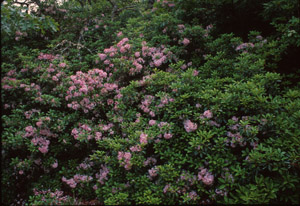 Photo: Carol Nourse.
Photo: Carol Nourse.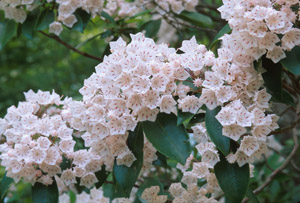 Photo: Hugh Nourse.
Photo: Hugh Nourse.
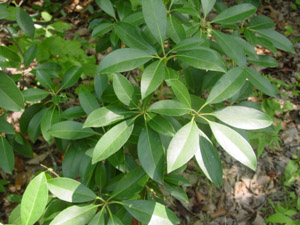 Photo: Gary Wade.
Photo: Gary Wade.Drooping Leucothoe / Leucothoe fontanesiana
Family: Heath / Ericaceae
Characteristics:
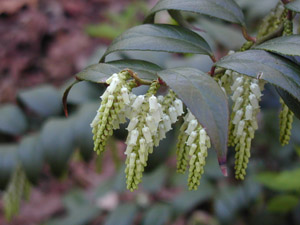 Photo: Theresa Schrum.
Photo: Theresa Schrum.Drooping Leucothoe is an evergreen flowering shrub with medium texture and a medium to slow growth rate. It has arching branches and a vase-shaped habit. Fragrant, urn-shaped, creamy-white flowers are borne on spikes in April and May. The foliage is leathery and glossy green.
Landscape Uses:
Nice for mass plantings. It produces a good evergreen backdrop for low-growing plants. To perform well, this plant must have moist soils high in organic matter and light to dense shade. It does not like hot, dry sites. It performs poorly in zone 8.
Size:
3 to 6 feet tall with a spread of 3 to 6 feet
Zones:
6b, 7a, 7b, 8a, 8b
Habitat:
Moist woodlands and stream banks.
Native To:
Virginia to Georgia, Kentucky to Alabama.
Comments:
Leafspot, mildew and root-rot can be serious problems. A similar species, Coast Leucothoe (Leucothoe axillaris), is found in south Georgia. Several cultivars of both Drooping Leucothoe and Coast Leucothoe are available.
Spice-Bush / Lindera benzoin
Family: Laurel / Lauraceae
Characteristics:
Spice-Bush is a deciduous shrub having medium texture and slow to medium growth rate. Honey-scented, yellow flowers appear before the leaves in March. Fruit are shiny, crimson-colored drupes in September. Male and female flowers are borne on different plants (dioecious). The plant is stoloniferous and spreads via suckers arising from the roots. Fall color is golden yellow.
Landscape Uses:
Ideal for stream bank plantings in shaded areas. The flowers and fruit are somewhat showy.
Size:
3 to 9 feet tall with an equal spread
Zones:
6b, 7a, 7b, 8a, 8b
Habitat:
Moist woods, stream banks and near springs. Likes basic (alkaline) soils.
Native To:
Maine to Ontario and Kansas, south to Florida and Texas.
Comments:
Host plant for the spicebush swallowtail butterfly.
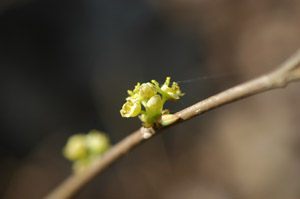 Photo: Ed McDowell.
Photo: Ed McDowell. Photo: Ed McDowell.
Photo: Ed McDowell.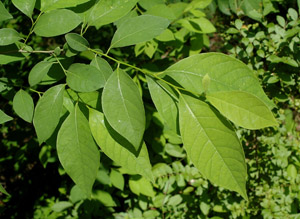 Photo: Steve Sanchez.
Photo: Steve Sanchez.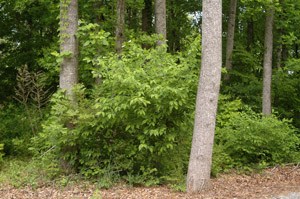 Photo: Steve Sanchez.
Photo: Steve Sanchez.Fetterbush / Lyonia lucida
Family: Heath / Ericaceae
Characteristics:
Fetterbush is an evergreen flowering shrub with medium texture and slow growth rate. Habit is upright and spreading. Fragrant, pinkish-white, bell-shaped flowers are borne from April to May. Flower form is similar to Leucothoe and Vaccinium.
Landscape Uses:
Fetterbush is best used in mass plantings and naturalized settings. It needs moist, well-drained soils and partial shade.
Size:
3 to 5 feet tall with a spread of 3 to 5 feet
Zones:
7a, 7b, 8a
Habitat:
Typically found in wet, acidic soils of pine flatwoods, savannahs, bays and swampy streams. It also occasionally occurs in dry uplands.
Native To:
Virginia to Florida and Louisiana.
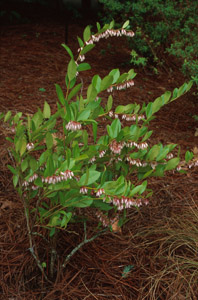 Photo: Carol & Hugh Nourse.
Photo: Carol & Hugh Nourse.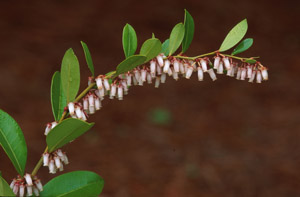 Photo: Carol & Hugh Nourse.
Photo: Carol & Hugh Nourse.Southern Wax Myrtle / Morella cerifera (Syn: Myrica cerifera)
Family: Myrtle / Myricaceae
Characteristics:
Southern Wax Myrtle is an upright, broadleaf evergreen shrub/small tree. It has a medium texture and medium growth rate. Form is variable but usually is broad-rounded at maturity. It also can be outstanding as a small, multi-stemmed tree. Bark is smooth and light gray. Male and female flowers are borne on separate plants. The foliage and fruit are aromatic. It becomes stoloniferous and can form thickets.
Landscape Uses:
Use Southern Wax Myrtle for screening or as a specimen tree or hedge. It is adaptable but prefers adequate moisture and full sun to light shade. It has few pests due to the pungent foliage. Ice storms can be a problem because the plant has weak wood that breaks easily.
Size:
15 to 20 feet tall with a spread of 15 to 20 feet
Zones:
7a, 7b, 8a, 8b
Habitat:
Brackish coastal soils; wet depressions and bogs to fairly dry upland sands in pine or pine-oak forests.
Native To:
Coastal Plain from southern New Jersey to the Florida Keys, west to east Texas, southeast Oklahoma into Central America.
Comments:
Blue-gray berries on female plants were used by early settlers to make scented candles. Many cultivars are available. It attracts birds and bees.
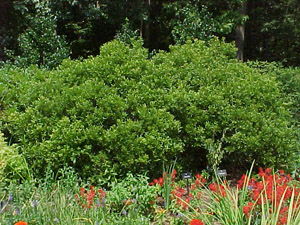 Photo: Gary Wade.
Photo: Gary Wade.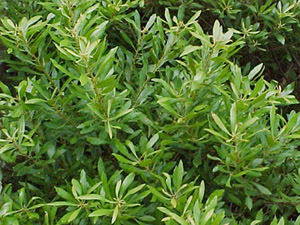 Photo: Gary Wade.
Photo: Gary Wade.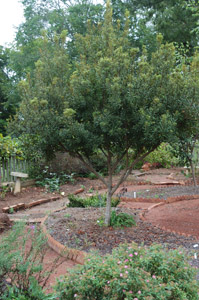 Photo: Ed McDowell.
Photo: Ed McDowell.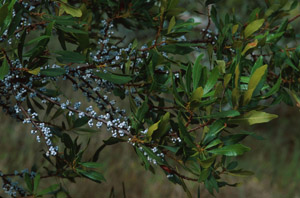 Photo: Hugh & Carol Nourse.
Photo: Hugh & Carol Nourse.Pinckneya, Feverbark / Pinckneya bracteata
Family: Madder / Rubiaceae
Characteristics:
Pinckneya — also called Fever Tree or Feverbark — is a deciduous, flowering small tree or large shrub with medium texture and medium to fast growth rate. Form is oval to round and commonly multi-stemmed. Large pink blooms (actually bracts) are borne in early June. Bloom color ranges from nearly pure white to pink, rose pink or red.
Landscape Uses:
Plant Pinckneya as a flowering specimen plant. It prefers filtered shade and acidic, wet, sandy loam soils. Avoid planting in drought-prone sites. Pinckneya is not the easiest plant to grow, but it is well worth the effort.
Size:
12 to 15 feet tall with a spread of 8 to 12 feet
Zones:
7b, 8a, 8b
Habitat:
Found mostly in low woods. It also grows in wet, acidic, sandy soils such as bogs and bays; blackwater seepage wetlands; and swampy thickets in the lower Piedmont and Coastal Plain.
Native To:
South Carolina to Florida.
Comments:
Seeds require no pretreatment, and cuttings root readily. It should be used more.
 Photo: Guy Anglin.
Photo: Guy Anglin.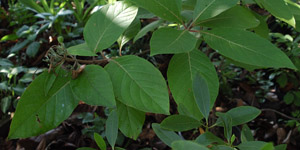 Photo: Ed McDowell.
Photo: Ed McDowell.
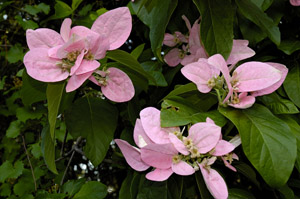 Photo: Tim Grissom.
Photo: Tim Grissom.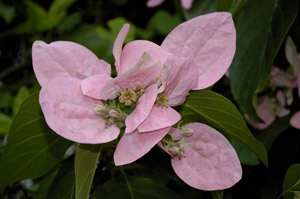 Photo: Tim Grissom.
Photo: Tim Grissom.Hoptree, Wafer-Ash / Ptelea trifoliata
Family: Rue / Rutaceae
Characteristics:
Hoptree is a deciduous shrub or small tree with medium-coarse texture and slow to medium growth rate. Habit is low-branched and rounded, and the tree has a suckering tendency. The foliage is mostly trifoliate. This plant’s claim to fame is the fruit, which superficially resembles hops. Flowers are fragrant but not conspicuous.
Landscape Uses:
Use Hoptree as a specimen plant. It adapts to sun or dense shade and prefers moist, well-drained soils.
Size:
15 to 20 feet tall with a spread of 5 to 15 feet
Zones:
6b, 7a, 7b, 8a, 8b
Habitat:
Found along stream banks in low areas and as an understory plant in hardwood forests. Typically found near granite outcrops in thin woods.
Native To:
Ontario and New York to Florida; west to Minnesota.
Comments:
A host plant for butterflies.
 CE.JPG) Photo: Chris Evans, Bugwood.org.
Photo: Chris Evans, Bugwood.org.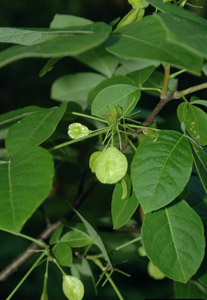 Photo: Chris Evans, Bugwood.org.
Photo: Chris Evans, Bugwood.org.Needle Palm / Rhapidophyllum hystrix
Family: Palm / Palmaceae
Characteristics:
Needle Palm is said to be the world’s most cold-hardy palm. It is an easy-to-grow, clump-forming palm adaptable to all areas of Georgia. Growth rate is slow, particularly when young. Attractive and hardy, it has been known to survive temperatures well below zero.
Landscape Uses:
Use Needle Palm as a single specimen or in groups. It looks best when planted in light shade and in soils with adequate moisture. In zone 7 and north, it must have some sun every day to do well. It is a slow grower. Beware of its long, sharp spines along the inner trunk and foul-smelling fruit when deciding where to locate this palm in the landscape.
Size:
10 feet tall and wide
Zones:
6b, 7a, 7b, 8a, 8b
Habitat:
River flood plains and moist slopes; often grows under hardwood trees where the water does not flood too deeply in winter. Often grows over limestone. Prefers neutral pH soils.
Native To:
South Georgia, Florida, Alabama, Mississippi and South Carolina.
Comment:
Rare in some parts of its range.
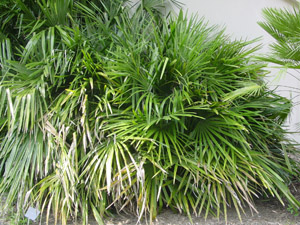 Photo: Gary Wade.
Photo: Gary Wade.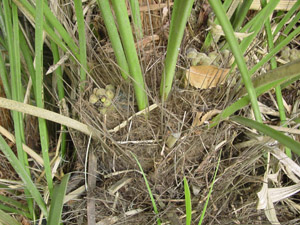 Photo: Gary Wade.
Photo: Gary Wade.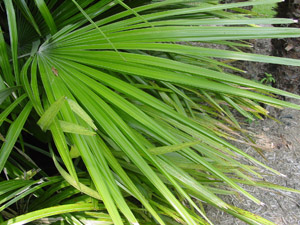 Photo: Gary Wade.
Photo: Gary Wade.Rhododendron and Deciduous Azalea Species
Family: Heath / Ericaceae
Characteristics:
Deciduous azaleas are flowering shrubs with medium-fine texture and a slow rate of growth. Flowers are tubular, arranged in clusters, and are sometimes fragrant, depending on species. There are a wide range of bloom times and colors from which to choose. They begin flowering in March, with some species flowering as late as August.
Landscape Uses:
Some deciduous azaleas grow in moist, acid soils high in organic matter, while others grow on upland sites. They bloom best if provided morning sun and afternoon shade. Use them as specimen plants or in flowering borders. They combine well with evergreens, dogwoods and other understory plants.
Size:
Up to 15 feet tall with a spread of 4 to 8 feet
Zones:
6b, 7a, 7b, 8a, 8b
Habitat:
Moist wooded areas and along streams
 Photo: Ernest Koone.
Photo: Ernest Koone. 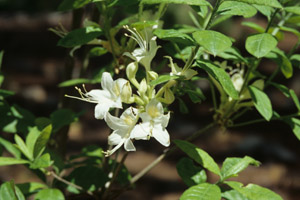 Alabama azalea flowers and foliage. Photo: Ernest Koone.
Alabama azalea flowers and foliage. Photo: Ernest Koone. 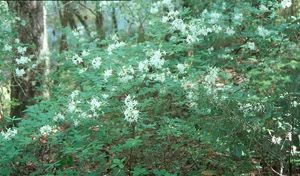 Alabama azalea in the landscape. Photo: Guy Anglin.
Alabama azalea in the landscape. Photo: Guy Anglin.Rhododendron alabamense (Alabama Azalea)
Alabama Azalea grows along dry ridges, steep bluffs, and in flat, moist, sandy areas. Form varies from low-growing and stoloniferous to upright as high as 12 feet. The white flowers have a sweet or musky-sweet fragrance, sometimes with a distinct lemon overtone. Bloom time is from late April to early June.
Rhododendron arborescens (Sweet Azalea)
Sweet Azalea is found along streams in moist mountain coves and is stoloniferous, forming dense colonies of plants growing up to 15 feet tall. The fragrant white flowers sometimes have yellow blotches. Flowers are large, frequently exceeding 2 inches across, and typically have red pistils and filaments (a distinct characteristic of this species). Bloom time is from May to August.
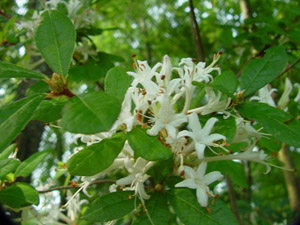 Sweet azalea flowers and foliage. Photo: Matthew Chappell.
Sweet azalea flowers and foliage. Photo: Matthew Chappell.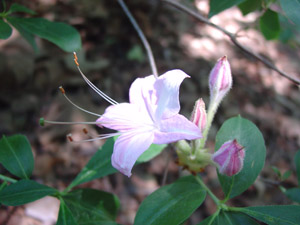 Rhododendron arborescens 'smoky pink'. Photo: Matthew Chappell.
Rhododendron arborescens 'smoky pink'. Photo: Matthew Chappell.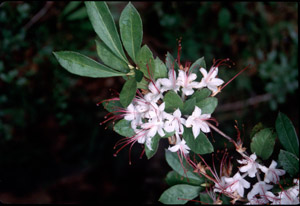 Sweet azalea flowers and foliage. Photo: Ernest Koone.
Sweet azalea flowers and foliage. Photo: Ernest Koone.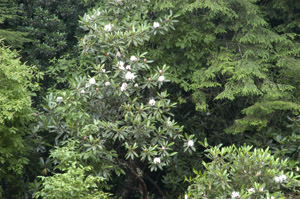 Sweet azalea in the landscape. Photo: Ed McDowell.
Sweet azalea in the landscape. Photo: Ed McDowell.
Rhododendron atlanticum (Coastal Azalea)
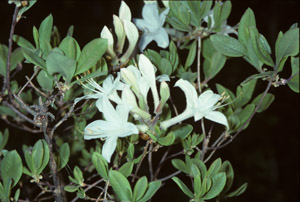 Coastal azalea flowers and foliage. Photo: Ernest Koone.
Coastal azalea flowers and foliage. Photo: Ernest Koone.Coastal Azalea grows in a wide range of latitudes and soil conditions, and up to 200 miles inland in sandy coastal plains, damp ditches, sandy swamp margins and dry pasture sites. In friable soil, the plant is stoloniferous and will form large colonies. Fragrant white flowers, often blushed pink, open in April and May.
Rhododendron austrinum (Florida Azalea)
Florida Azalea is early flowering and easy to grow, making it one of the most popular species. The fragrant yellow, gold or light orange flowers normally have pink to bright red center tubes and bloom in March and April.
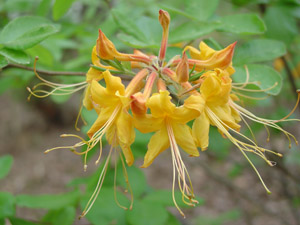 Florida azalea flowers. Photo: Matthew Chappell.
Florida azalea flowers. Photo: Matthew Chappell.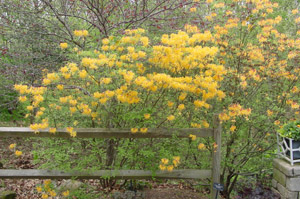 Florida azalea in the landscape. Photo: Gary Wade.
Florida azalea in the landscape. Photo: Gary Wade.
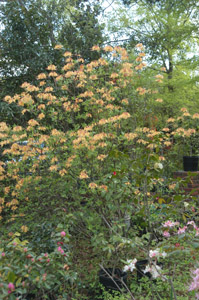 Florida azalea in the landscape. Photo: Ed McDowell.
Florida azalea in the landscape. Photo: Ed McDowell.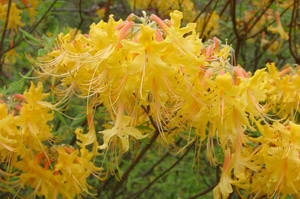 Florida azalea flowers. Photo: Gary Wade.
Florida azalea flowers. Photo: Gary Wade.
Rhododendron calendulaceum (Flame Azalea)
Flame Azalea is a tall shrub, growing to 12 feet tall, and found from the woody hillsides of the Appalachians to the Piedmont region above the fall line. It is a tetraploid with larger flowers than other species. Flower color ranges from clear yellow to yellowish-orange, orange, reddish-orange or red. The flowers open with or after the leaves and are not fragrant. Plants are non-stoloniferous. Stems have short hairs, and buds are smooth.
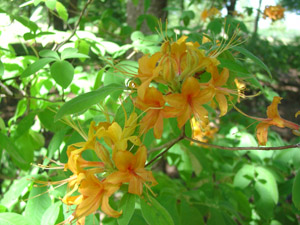 Photo: Matthew Chappell.
Photo: Matthew Chappell.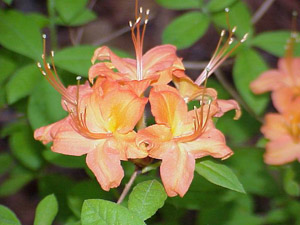 Photo: Matthew Chappell.
Photo: Matthew Chappell.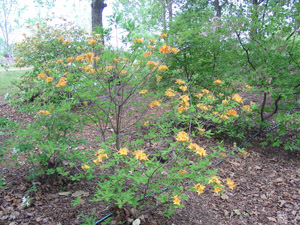 Photo: Matthew Chappell.
Photo: Matthew Chappell.
Rhododendron canescens (Piedmont Azalea)
Piedmont Azalea, the most common species of native azalea, is found growing in a wide variety of habitats, from damp swamp margins to dry upland ridges. It grows to a height of 15 feet. Flowers are pink, occasionally white, with pink center tubes and a sweet to musky-sweet fragrance. Bloom period is from March to early May.
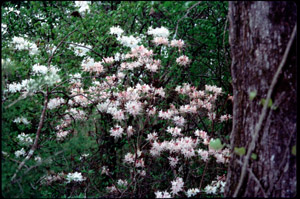 Photo: Ernest Koone.
Photo: Ernest Koone.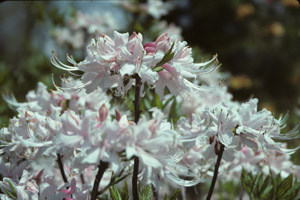 Photo: Ernest Koone.
Photo: Ernest Koone.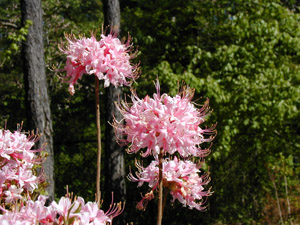 Photo: Theresa Schrum.
Photo: Theresa Schrum.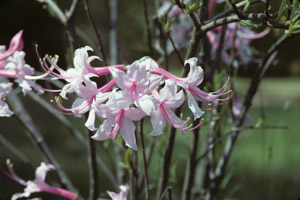 Photo: Ernest Koone.
Photo: Ernest Koone.
Rhododendron flammeum, syn. R. speciosum (Oconee Azalea)
Oconee Azalea is a low to tall shrub found in open woods and slopes from the lower Piedmont region across central Georgia. Flowers, appearing from mid-April to early May, vary in color from yellow-orange to orange or red. They open with the leaves and are not fragrant. Winter buds are smooth and stems are covered with short hairs. The Oconee Azalea is a low elevation plant and is heat tolerant.
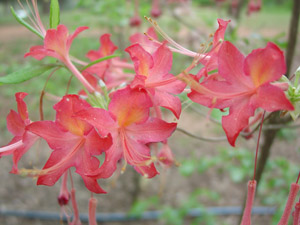 Photo: Matthew Chappell.
Photo: Matthew Chappell.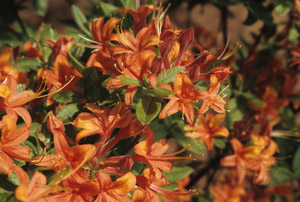 Photo: Ernest Koone.
Photo: Ernest Koone.
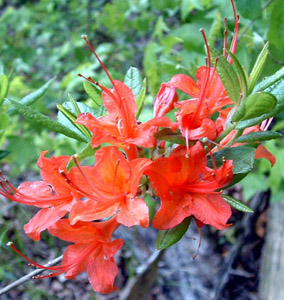 Photo: Matthew Chappell.
Photo: Matthew Chappell.
Rhododendron prunifolium (Plumleaf Azalea)
Plumleaf Azalea is a medium to large shrub growing to 15 feet. It is found along shady ravines and stream banks in southwestern Georgia. Reddish-orange to red flowers open after the leaves are fully developed and are not fragrant. This species must be used in partial shade as the flowering period is from July to September. Winter flower buds are smooth and greenish to light brown in color.
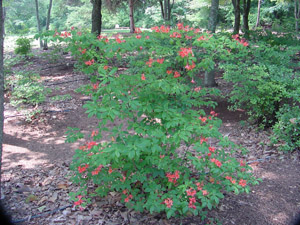 Photo: Matthew Chappell.
Photo: Matthew Chappell.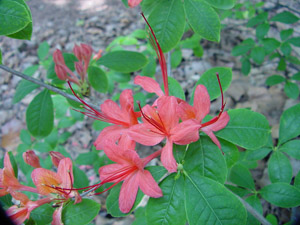 Photo: Matthew Chappell.
Photo: Matthew Chappell.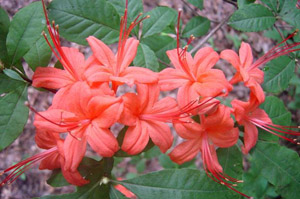 Photo: Matthew Chappell.
Photo: Matthew Chappell.
Rhododendron serralatum (Hammock Sweet Azalea)
Hammock Sweet Azalea is a large shrub growing to 15 feet or more and found in wooded swamps and hammocks of Georgia’s Coastal Plain. It is not stoloniferous. White, occasionally pale pink flowers open in July and August after the leaves are fully developed and have a clove-like fragrance.
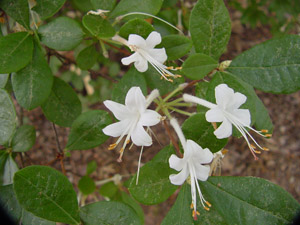 Photo: Matthew Chappell.
Photo: Matthew Chappell.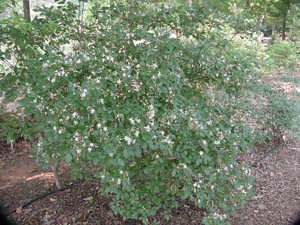 Photo: Matthew Chappell.
Photo: Matthew Chappell.
Rhododendron viscosum (Swamp Azalea)
Swamp Azalea is a variable small to medium size shrub found from low, marshy areas and along stream banks to high, mixed-forest mountains. Flowers are white, sometimes with a pinkish tinge, appearing in May and June after the leaves have fully developed; they have a spicy fragrance. The Swamp Azalea is generally stoloniferous.
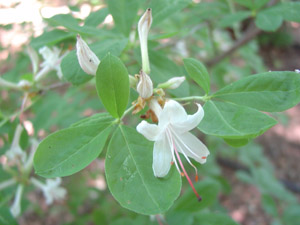 Photo: Matthew Chappell.
Photo: Matthew Chappell.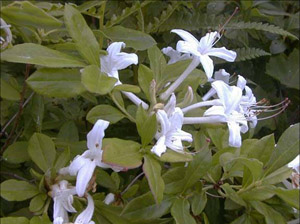 Photo: Matthew Chappell.
Photo: Matthew Chappell.
Rhododendron (Evergreen) Species
Family: Heath / Ericaceae
Characteristics:
Evergreen Rhododendrons are flowering shrubs/small trees with dark green, leathery foliage. Three species are endemic to Georgia. Large, funnel-shaped flower clusters are borne at the branch tips from April through August, depending on the species and habitat. These species are a major component of the forest understory, especially in mountainous regions.
Landscape Uses:
All evergreen Rhododendron species require moist, well-drained, acidic soil, high in organic matter. All flower best if provided with filtered morning sun and afternoon shade. Foliage will scorch if exposed to summer afternoon sun. Use them as specimen plants in shady flowering borders. Rhododendrons mix well with other evergreens, deciduous azaleas and dogwoods.
Size:
5 to 20 feet tall with a spread of 6 to 10 feet, depending on species
Zones:
6b, 7a, 7b
Habitat:
Moist wooded areas and along streams.
Rhododendron catawbiense(Catawba Rosebay)
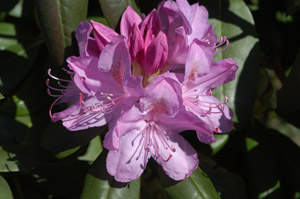 Photo: Ed McDowell.
Photo: Ed McDowell.A shrub found at higher elevations on mountain ridges, heath balds and upland woods, it typically grows about 6 feet in height. Catawba Rosebay flowers from May to June, and the rose, lilac-purple, pink or white flowers are borne in terminal clusters having eight to 20 individual flowers. The leaves are 3 to 6 inches long, shiny, and olive-green above and lighter green below.
Rhododendron maximum (Great Laurel)
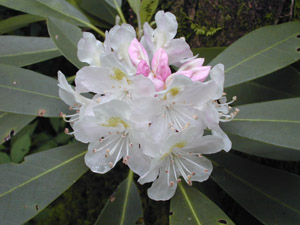 Photo: Ed McDowell.
Photo: Ed McDowell.This shrub is mostly found in mountain valleys in wet, wooded areas and along shaded streams. It typically grows in dense thickets and can reach eight to 10 feet in height. Great Laurel flowers from May to August, and coloration ranges from white to pink, light rose or purple. Flowers are borne in terminal clusters consisting of 12 to 30 individual flowers. The top sides of the 4- to 8-inch leaves are shiny and dark or olive-green; the undersides have a thin layer of hairs. Leaves are slightly curled. During drought or extreme cold, they will roll into tight cylinders.
Rhododendron minus (Piedmont Rhododendron)
Piedmont Rhododendron is found along stream banks and wooded slopes in the lower mountains and Piedmont and the upper Coastal Plain. It is a compact plant, typically about 6 feet in height. Flowers occur from May to June, and range from pink to white. They are borne in terminal clusters of four to 12 individual flowers. The top sides of the 2- to 4-inch-long leaves are dark or pale green, and the undersides are brown and scaly.
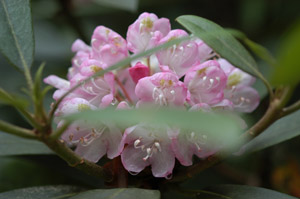 Photo: Ed McDowell.
Photo: Ed McDowell.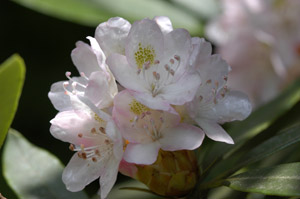 Photo: Ed McDowell.
Photo: Ed McDowell.Winged Sumac / Rhus copallina (syn. Rhus copallinum)
Family: Sumac / Anacardiaceae
Characteristics:
Winged Sumac is a large, deciduous, flowering shrub with coarse texture and a fast growth rate. Form is upright with a flat crown. Suckers arising from the roots form dense thickets. Foliage is glossy green above and whitish below. The leaves are pinnately compound. Greenish-yellow flowers are borne in dense pyramidal clusters in June and July. Flowers are followed by showy red fruit. The plant’s best feature is its brilliant crimson red fall color.
Landscape Uses:
Winged Sumac is best used in mass plantings or roadside plantings. With training, it can be grown as a specimen tree. It is useful for stabilizing erodible soils. Full sun and well-drained soils are preferred. It is drought-tolerant and easy to transplant. Winged Sumac is a good shrub for highway medians.
Size:
8 to 20 feet tall with a spread of 5 to 15 feet
Zones:
6b, 7a, 7b, 8a, 8b
Habitat:
A pioneer species in open fields and meadows; also grows well on dry, infertile soils.
Native To:
Maine to Ontario and Minnesota; south to Florida and west to Texas.
Comments:
Many birds eat the seeds. There are several other native sumacs.
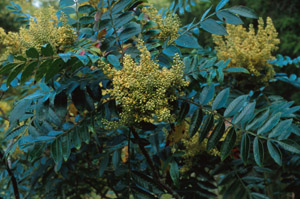 Photo: Hugh & Carol Nourse.
Photo: Hugh & Carol Nourse.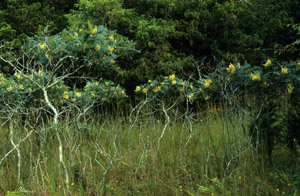 Photo: Hugh & Carol Nourse.
Photo: Hugh & Carol Nourse.
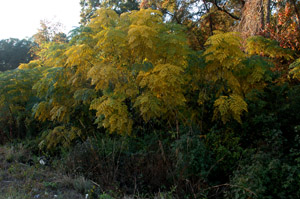 Photo: Ed McDowell.
Photo: Ed McDowell.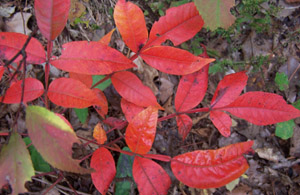 Photo: Michael Strickland.
Photo: Michael Strickland.
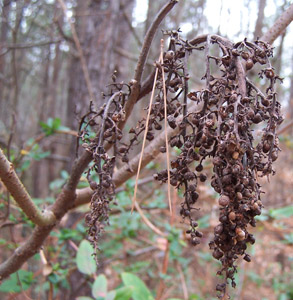 Photo: Michael Strickland.
Photo: Michael Strickland.Dwarf Palmetto (Bluestem Palmetto) / Sabal minor
Family: Palm / Palmaceae
Characteristics:
Dwarf Palmetto is an evergreen palm with large leaves and coarse texture. This palm is often confused with Saw Palmetto (Serenoa repens). Unlike Saw Palmetto, the Dwarf Palmetto does not have spiny leaf-stems and does not spread over a large area. Leaves also differ from other native dwarf palms by having a split “V” in the middle. Sometimes described as a clumping palm, it is actually a single-trunk palm, but its trunk is either very short or below ground and it will seldom appear tree-like.
Landscape Uses:
Dwarf Palmetto looks best in groups, but it also can be effective as a single specimen. It is a tough plant that lends a bold, tropical look to the landscape. It tolerates salt spray, so it would be a good choice for coastal areas. Moist, sunny locations along a creek or lake would be ideal planting sites. Growth and blue color are best in full sun. Dwarf Palmetto will grow in any soil, provided it is given adequate moisture.
Size:
4 to 5 feet tall with an equal spread
Zones:
7a, 7b, 8a, 8b
Habitat:
Coastal Plain lowlands such as swamps, bottomlands, maritime forests, marsh borders, and moist or mesic hammocks.
Native To:
North and South Carolina, Georgia, Florida, Alabama, Mississippi, Arkansas, Louisiana, Texas and Oklahoma.
Comment:
Much more numerous and widespread than needle palm.
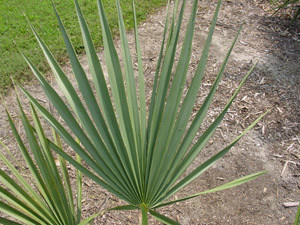 Photo: Gary Wade.
Photo: Gary Wade.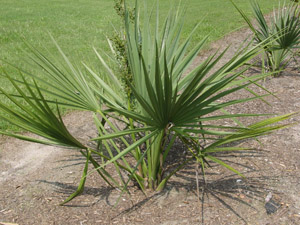 Photo: Gary Wade.
Photo: Gary Wade.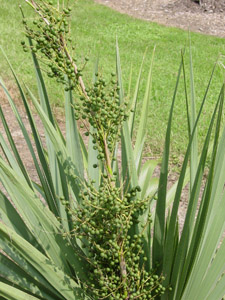 Photo: Gary Wade.
Photo: Gary Wade.Saw Palmetto / Serenoa repens
Family: Palm / Palmaceae
Characteristics:
Saw Palmetto is a common understory plant, often found growing thicket-like in southern Georgia and the Florida peninsula. It is a low, spreading palm with stiff leaves and spiny leaf stems. A single plant may have several trunks that creep along the ground, rooting and branching as they grow. With age, it will sometimes form an upright trunk. In coastal regions, it is an aggressive spreader. It is the only native palm with spiny leaf stems.
Landscape Uses:
Although it is often thought of as a spiny nuisance, scrub palm, and a habitat for rodents and snakes, Saw Palmetto can be an attractive groundcover and an effective hedge or barrier plant in the landscape. It is tolerant of salt spray and drought, and is an excellent choice for coastal landscapes. Full sun and well-drained soils are preferred.
Size:
5 feet tall and sprawling as it roots along its horizontal stems
Zones:
8a and 8b
Habitat:
Dry upland sites to moist sites, including pine flatwoods, hammocks and coastal dunes. It usually grows on higher and drier sites than the Needle Palm and Dwarf Palmetto. Saw Palmetto thrives in areas subject to disturbances, such as areas that have been clear cut, burned by fire or subjected to salt spray.
Native To:
Coastal areas of the Southeast and most of Florida.
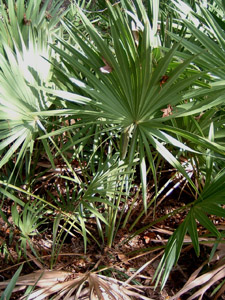 Photo: Tom McClendon.
Photo: Tom McClendon. Photo: Gary Wade.
Photo: Gary Wade.American Bladdernut / Staphylea trifolia
Family: Bladdernut / Staphyleaceae
Characteristics:
Bladdernut is a small deciduous tree or large shrub. Leaves have long petioles, are opposite and consist of three leaflets. Each compound leaf is 6 to 9 inches long and pubescent underneath. The leaflets' edges are finely serrated. The bark is smooth, gray and often white-striped when young. Flowers are white, bell-shaped, and held in drooping clusters. Bark and flowers are attractive, but it is the fruit capsule that makes this tree distinctive. The fruit capsules look like Japanese lanterns and are conspicuous all summer and into late fall.
Landscape Uses:
For best effect, use Bladdernut at the edge of natural, moist woodland settings. It is easy to transplant.
Size:
20 to 25 feet tall and 10 to 15 feet wide
Zones:
7b, 8a, 8b
Habitat:
Rich, moist, deciduous bottomlands and mesic forests, shaded slopes and ravines, and over calcareous rocks.
Native To:
Minnesota to Georgia and Alabama; does not extend into the Coastal Plain.
Comments:
The hard seeds are a favorite food of woodland mice. It can be mistaken for Wafer Ash or Boxelder when young.
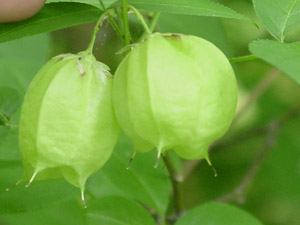 Photo: Gary Wade.
Photo: Gary Wade.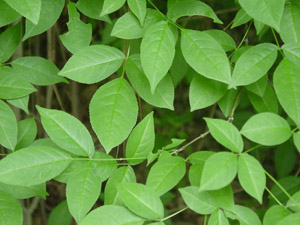 Photo: Gary Wade.
Photo: Gary Wade.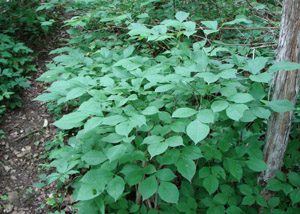 Photo: Troy Evans, Bugwood.org.
Photo: Troy Evans, Bugwood.org.Mountain Stewartia / Stewartia ovata
Family: Tea / Theaceae
Characteristics:
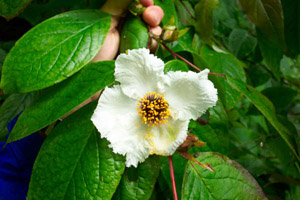 Photo: Jack Johnston.
Photo: Jack Johnston.Mountain Stewartia is a large, deciduous, flowering shrub or small tree with medium texture and a slow growth rate. Habit is round and spreading, somewhat bushy in appearance. Glossy, dark green summer foliage turns orange to scarlet in fall. Attractive white flowers, 3 inches across, are borne in June and July. Bark is mottled and exfoliating.
Landscape Uses:
Use Mountain Stewartia as a flowering or specimen plant. Plant it in moist, acid, high-organic soils, and full sun to partial shade. It should have protection and irrigation during hot, dry weather. It is a temperamental plant, somewhat difficult to grow.
Size:
10 to 15 feet tall and wide
Zones:
6b, 7a, 7b
Habitat:
Rich, moist ravines and slopes, mesic forests, and acidic forest understories in the Blue Ridge.
Native To:
North Carolina to Tennessee and Florida.
Comments:
There is a Coastal Plain Stewartia (Stewartia malacodendron), also called Silky Stewartia and Silky Camellia, that is equally beautiful.
American Snowbell / Styrax americanus
Family: Storax / Styracaceae
Characteristics:
American Snowbell is a deciduous flowering shrub or small tree with medium texture and a medium to fast growth rate. It has an upright form with loose, ascending branches. White, fragrant flowers are borne in April. The bark is dark and handsome.
Landscape Uses:
Use American Snowbell as a specimen or patio tree. It is also nice when used as an understory plant. It prefers moist, acid, sandy soils and full sun to light shade. Adequate moisture is required during dry weather.
Zones:
7a, 7b, 8a, 8b
Size:
6 to 10 feet tall and 5 to 8 feet wide
Habitat:
Moist to wet acidic, sandy soils of floodplains.
Native To:
Missouri to Ohio, Virginia to Florida, west to eastern Texas and Oklahoma.
Comments:
American Snowbell is easy to root from cuttings taken in June and July. Another species, Bigleaf Snowbell (S. grandiflora), is a small tree commonly found growing as an understory plant in wooded upland sites.
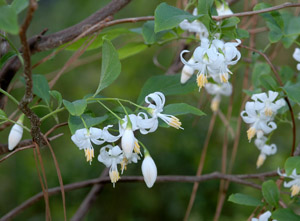 Photo: Steve Sanchez.
Photo: Steve Sanchez.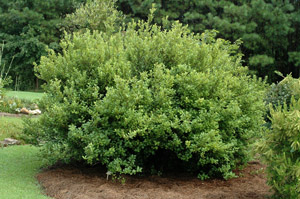 Photo: Steve Sanchez.
Photo: Steve Sanchez.
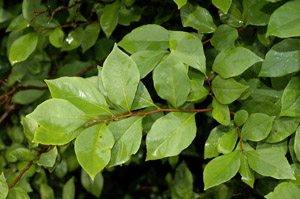 Photo: Steve Sanchez.
Photo: Steve Sanchez.Horse-Sugar, Sweetleaf / Symplocos tinctoria
Family: Sweetleaf / Symplocaceae
Characteristics:
Horse-Sugar, or Sweetleaf, is a small, semi-evergreen shrub with medium texture and medium growth rate. It has glossy, evergreen foliage in the Deep South and is deciduous farther north. On open sites, it has a rounded, spreading form. In early spring, fragrant yellow blooms are borne in dense clusters along the stems. Fruit mature in early fall and are an orange-brown color.
Landscape Uses:
Horse-Sugar can be used as a flowering or specimen shrub, for naturalizing on thin wooded bluffs, or in a mixed-shrub border. It prefers loose soils and sun to partial shade.
Size:
20 to 30 feet tall by 15 to 20 feet wide
Zones:
7a, 7b, 8a, 8b
Habitat:
Found mostly in moist to wet soils. It also grows on dry uplands in the Appalachians.
Native To:
Delaware to Florida and Louisiana.
Comments:
Leaves are sweet to the taste and are eaten by wildlife. The bark and leaves yield a yellow dye. It is a butterfly larva host plant.
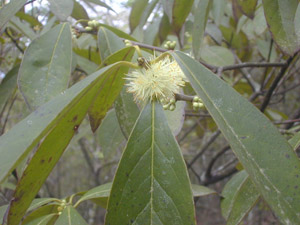 Photo: Ed McDowell.
Photo: Ed McDowell.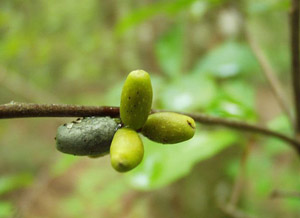 Photo: Shirley Denton.
Photo: Shirley Denton.
 CE.JPG) Photo: Chris Evans, Bugwood.org.
Photo: Chris Evans, Bugwood.org.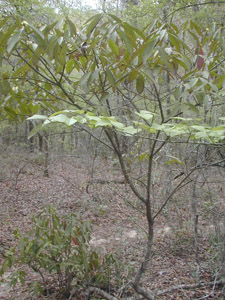 Photo: Ed McDowell.
Photo: Ed McDowell.Vaccinium Species
Family: Heath / Ericaceae
Vacciniums, or blueberries, are dominant shrubs statewide on the acidic soils of Georgia. The Carolinas, Virginia and Georgia are home to 20 species of Vaccinium and have a greater diversity of Vaccinium than any other comparably-sized area in North America, according to Alan Weakley, author of The Flora of the Carolinas, Virginia and Georgia. Blueberries are an important food source for wildlife. Within these species, five are evergreen across their range; at least two more are partially evergreen in the southern part of their range. All are shrubs. The species with mature heights of about three feet or less are generally known as “lowbush blueberries.” Most of the taller ones are called “highbush blueberries.”
Sparkleberry / Vaccinium arboreum
Family: Heath / Ericaceae
Characteristics:
Sparkleberry, also called Farkleberry, is a semi-deciduous shrub with glossy green foliage, medium-fine texture, a slow growth rate and an oval-rounded form. Clusters of delicate, white bell-shaped flowers (0.25-inches long) bloom in May. The black fruit are visible for an extended period in the fall and winter. Fall leaf color is deep red to maroon. Older plants have exfoliating bark that reveals an orange-brown inner bark. With age, the plant has a very picturesque branching habit.
Landscape Uses:
Use Sparkleberry as a flowering or specimen shrub in full sun to partial shade. It adapts to both moist and dry soils. Drought tolerance is good once the plant is established. Small plants transplant best.
Size:
15 to 20 feet tall with a canopy spread of 12 to 15 feet
Zones:
7a, 7b, 8a, 8
Habitat:
Sandy and rocky dry uplands, in pine and hardwood forest understories, and in clearings.
Native To:
Kansas to Virginia, south to Florida, west to Texas.
Comments:
Vacciniums are one of the most common native shrubs.
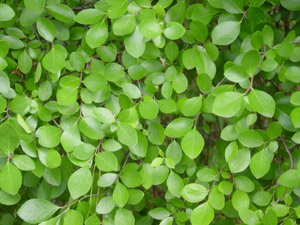 Photo: Gary Wade.
Photo: Gary Wade.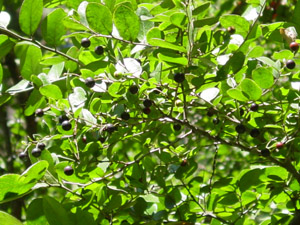 Photo: Gary Wade.
Photo: Gary Wade.
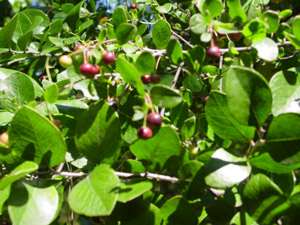 Photo: Gary Wade.
Photo: Gary Wade.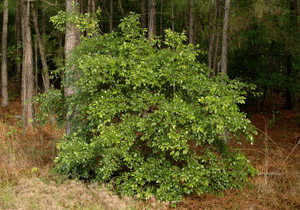 Photo: Steve Sanchez.
Photo: Steve Sanchez.
 CE.JPG) Photo: Chris Evans, Bugwood.org.
Photo: Chris Evans, Bugwood.org.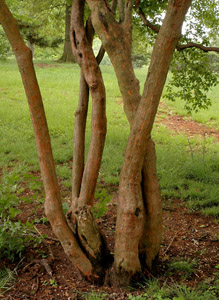 Photo: Steve Sanchez.
Photo: Steve Sanchez.Rabbiteye Blueberry Cultivars / Vaccinium virgatum (Syn. Vaccinium ashei) cultivars
Family: Heath / Ericaceae
Characteristics:
Rabbiteye Blueberry cultivars are similar in many ways to Highbush blueberries but are more adapted to cultivation in the southern states. They were developed from native southern Vaccinium species, mainly of the Coastal Plain. Many selections with superior fruiting characteristics have been made. The foliage is blue-green and attractive. They begin blooming in late March in the Piedmont but earlier in the Coastal Plain. They make outstanding landscape shrubs that produce delicious fruit. Their growth habit is similar to that of the Southern Highbush Blueberry (V. corymbosum), one of the species that went into their development.
Landscape Uses:
Use Rabbiteye Blueberries as fruiting plants or in sunny shrub borders. Blueberries thrive in acidic, well-drained soils that have been enriched with organic matter. They prefer full sun to light shade.
Size:
6 to 8 feet tall and 4 to 5 wide, depending on whether or not root suckers are pruned
Zones:
7a, 7b, 8a, 8b
Habitat:
Acid, well-drained soils.
Native To:
Georgia and the Southeast.
Comments:
Many cultivars are available. For good cross pollination, plant two or more cultivars. Check with UGA Extension for a list of the best plants for your area. The main pollinator for many native species is the Southeastern Blueberry Bee, which starts flying when the earliest native blueberries begin blooming.
 Photo: Gary Wade.
Photo: Gary Wade.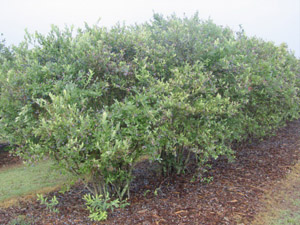 Photo: Gary Wade.
Photo: Gary Wade.Southern Highbush Blueberry / Vaccinium corymbosum
Family: Heath / Ericaceae
Characteristics:
Southern Highbush Blueberry is an upright, multi-stemmed shrub having a rounded, dense, compact form and a medium texture. Flowers are small, bell-shaped, white tinged with pink, and appear in March. Fruit are sweet tasting and dark blue with a white bloom. They ripen in June and July, and humans and wildlife relish them. The leaves are frequently blue-green, turning a brilliant fall color of yellow, bronze, orange, scarlet and crimson combinations.
Landscape Uses:
Southern Highbush Blueberry is a good hedge plant for screening or for a mixed shrub border.
Size:
6 to 12 feet tall with a 6-foot canopy
Zones:
7a, 7b, 8a, 8b
Habitat:
Open swamps, sandy lakeshores, upland woods and ravines.
Native To:
Maine to Minnesota, south to Florida and Louisiana.
Comments:
Southern Highbush Blueberry (V. corymbosum) was used in developing cultivars for berry production.
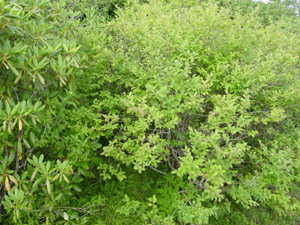 Photo: Gary Wade.
Photo: Gary Wade.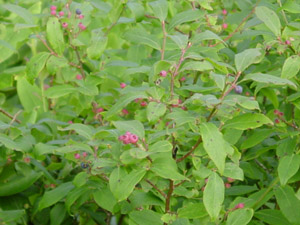 Photo: Gary Wade.
Photo: Gary Wade.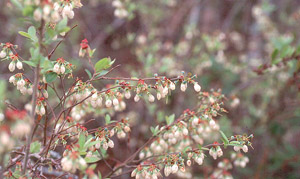 Photo: Betty Wargo.
Photo: Betty Wargo.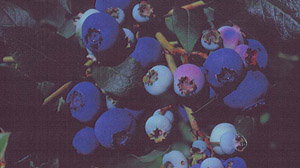 Photo: Walter Hodge.
Photo: Walter Hodge.
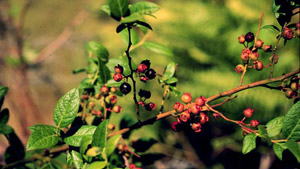 Photo: Betty Wargo.
Photo: Betty Wargo.Darrow’s Blueberry or Glaucous Blueberry / Vaccinium darrowii
Family: Heath / Ericaceae
Characteristics:
Darrow’s Blueberry is a small evergreen shrub, rarely more than 24 inches tall. It is bushy with blue-green, slightly revolute (rolled back on the margins) foliage. Flowers are white to pink, and fruit are about one-third-inch in diameter. Both leaves and fruit have a glaucous (grayish or whitish powdery-looking) appearance.
Landscape Uses:
Use Darrow’s Blueberry as a foundation planting or groundcover on Coastal Plain flatwood sites with good drainage, sandy acid soils and shade to partial sun.
Size:
Reaches up to 24 inches tall and wide
Zones:
8a, 8b
Habitat:
Acid, sandy, seasonally wet to dry flatwoods, pinelands and scrub.
Native To:
The Coastal Plain from Georgia to Florida and west to Texas.
Comments:
A good wildlife plant; cultivars are available.
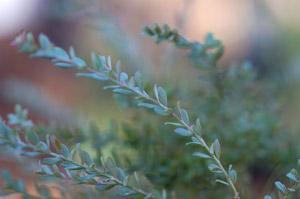 Photo: Ed McDowell.
Photo: Ed McDowell.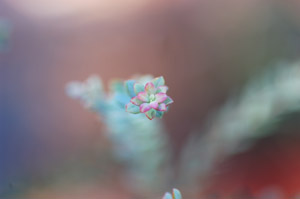 Photo: Ed McDowell.
Photo: Ed McDowell.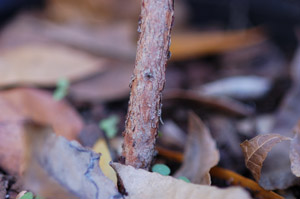 Photo: Ed McDowell.
Photo: Ed McDowell.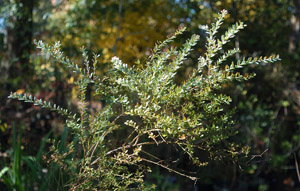 Photo: Ed McDowell.
Photo: Ed McDowell.
 Photo: Dennis Girard.
Photo: Dennis Girard.Mayberry / Vaccinium elliottii
Family: Heath / Ericaceae
Characteristics:
Mayberry is the earliest blueberry to bloom in Georgia, often blooming in late February with white, bell-shaped flowers tinged with pink. Fruit are a half-inch in diameter, black and glossy. Growth habit is bushy, branched and 6 to 8 feet tall. Foliage is glossy green. The green, zigzag twigs are a distinguishing feature of this plant. The leaves are semi-evergreen, and some plants have scarlet fall color.
Landscape Uses:
Mayberry is useful for screening in partial shade. This shrub grows well and flowers in pine-oak forests; it is one of the most common shrubs on acidic pinelands in the Piedmont.
Size:
6 to 8 feet tall and 6 feet wide (can grow to 15 feet tall)
Zones:
7a, 7b, 8a, 8b
Habitat:
Occurs in moist sand near riverbanks and on higher ground in swamps and floodplains as well as in sandy pinelands, thin hardwood forests or at forest edges.
Native To:
Southeastern Virginia to north Florida, westward to east Texas and Arkansas.
Comments:
Not yet available in the nursery trade.
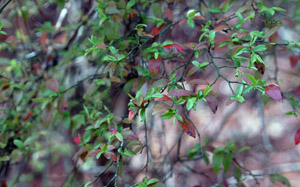 Photo: Chris Evans, Bugwood.org.
Photo: Chris Evans, Bugwood.org.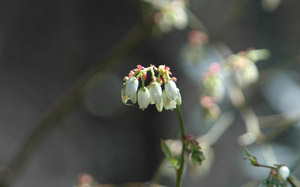 Photo: Chris Evans, Bugwood.org.
Photo: Chris Evans, Bugwood.org.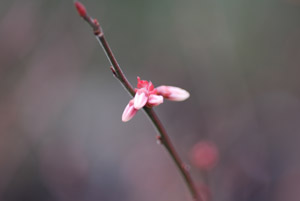 Photo: Ed McDowell.
Photo: Ed McDowell.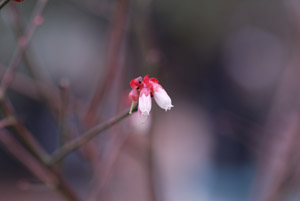 Photo: Ed McDowell.
Photo: Ed McDowell.Hillside Blueberry or Blue Ridge Blueberry / Vaccinium pallidum
Family: Heath / Ericaceae
Characteristics:
Hillside Blueberry is a low-growing, deciduous shrub occurring in small to large open colonies. It spreads by rhizomes. Flowers bloom in March and are white to pink. Leaves are pale to dark blue-green and lighter underneath.
Landscape Uses:
Use Hillside Blueberry as a hillside groundcover in dry, open, oak-pine woodlands.
Size:
Up to 2 feet tall, with a spread of several feet
Zones:
7a, 7b, 8a
Habitat:
Acidic dry soil, oak-pine forests and, occasionally, on moister slopes in the interior of the Southeast.
Native To:
Minnesota to Maine, south to Florida; west to Mississippi, Arkansas, Oklahoma and Kansas.
Comments:
A common shrub in dry upland woods.
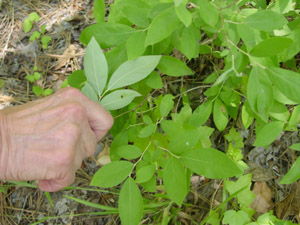 Photo: Gary Wade.
Photo: Gary Wade.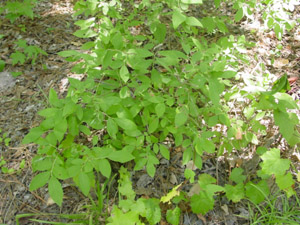 Photo: Gary Wade.
Photo: Gary Wade.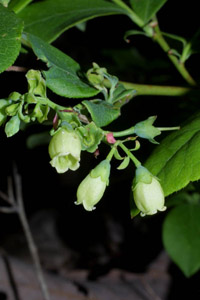 Photo: Steve Baskauf.
Photo: Steve Baskauf.Deerberry / Vaccinium stamineum
Family: Heath / Ericaceae
Characteristics:
Deerberry is a multi-stemmed deciduous shrub with a fern-like branching pattern. It sometimes forms colonies from its suckering root system. Showy white, pendulous flowers have leafy bracts. The bracts are smaller than the leaves. Flowering occurs after the early-blooming blueberries and before Sparkleberry.
Landscape Uses:
Use Deerberry in a mixed-shrub border with azaleas or along a woodland edge.
Size:
6 to 12 feet tall
Zones:
7a, 7b, 8a, 8b
Habitat:
Occurs in a variety of habitats from high Appalachian elevations to dry or moist woodlands; extends into coastal forests.
Native To:
New York to Missouri, south to Florida and west to Louisiana.
Comments:
Adapted to dry soils, Deerberry deserves to be grown in southern gardens and xeric landscapes. The highly glaucous forms have not yet been exploited by the nursery industry.
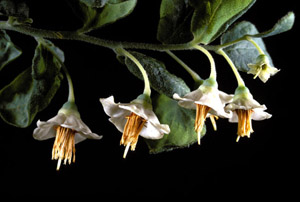 Photo: Alan S. Heilman.
Photo: Alan S. Heilman.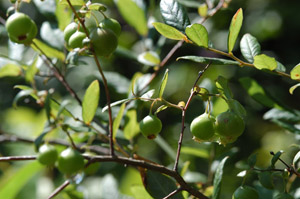 Photo: Ed McDowell.
Photo: Ed McDowell.
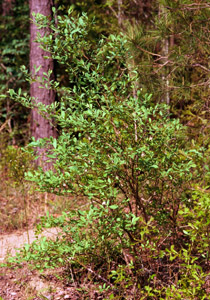 Photo: James H. Miller, Bugwood.org.
Photo: James H. Miller, Bugwood.org.Mapleleaf Viburnum / Viburnum acerifolium
Family: Honeysuckle / Caprifoliaceae
Characteristics:
Mapleleaf Viburnum is an attractive, loosely branched, deciduous, low-growing shrub. Yellow-white flowers appear in a flat head in April. Leaves are palmate and three-lobed. Fruit are black. The plant is stoloniferous and forms colonies. Fall color is variable but usually colorful.
Landscape Uses:
Mapleleaf Viburnum prefers dense shade and moist, well-drained soils. It develops large, loose colonies when planted in the understory.
Size:
6 feet tall and up to 10 feet wide
Zones:
6b, 7a, 7b, 8a, 8b
Habitat:
An understory plant of moist and rocky woodlands.
Native To:
New Brunswick to Minnesota, south to North Carolina and Georgia.
Comments:
Migrating birds eat the fruit in the fall.
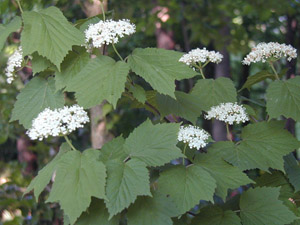 Photo: Theresa Schrum.
Photo: Theresa Schrum.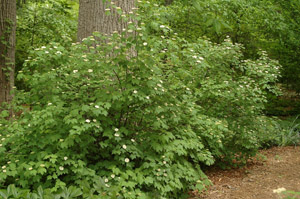 Photo: Steve Sanchez.
Photo: Steve Sanchez.
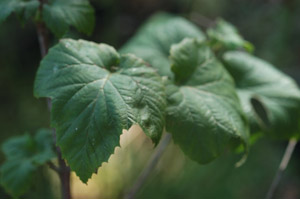 Photo: Ed McDowell.
Photo: Ed McDowell.Arrowwood Viburnum / Viburnum dentatum
Family: Honeysuckle / Caprifoliaceae
Characteristics:
Arrowwood Viburnum is a deciduous flowering shrub with medium texture and medium growth rate. Upright branches form a spreading crown. Creamy-white flower clusters are borne in a flat head in May. Fall color ranges from yellow to red or purple. The leaves are a glossy, dark green.
Landscape Uses:
Use Arrowwood Viburnum for hedges, group plantings or screening. It prefers moist, sandy-loam soils and full sun to partial shade. Shows good site tolerance and will grow in heavy soils. Fruit color, which changes as the season progresses, adds interest to the landscape.
Size:
6 to 15 feet tall and wide
Zones:
6b, 7a, 7b, 8a, 8b
Habitat:
Typically grows in wet soils near water — in bottomlands, stream beds and bogs.
Native To:
New Brunswick to Minnesota, south to Georgia.
Comments:
Fruit are attractive to birds.
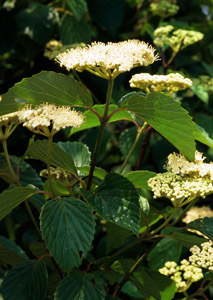 Photo: Ted Bodner.
Photo: Ted Bodner.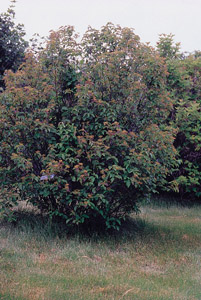 Photo: USDA.
Photo: USDA.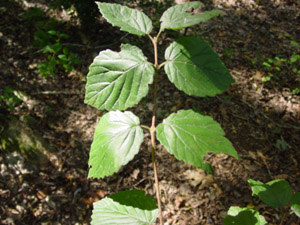 Photo: Gary Wade.
Photo: Gary Wade.Swamp-Haw / Viburnum nudum
Family: Honeysuckle / Caprifoliaceae
Characteristics:
Swamp-Haw is a deciduous shrub bearing white blooms in flat heads in May. Fruit color changes from green to pink to dark blue and are covered in a waxy bloom. Arching branches often take root and spread.
Landscape Uses:
Use Swamp-Haw in groups for massing or in a shrub border. It prefers moist soils, but it may adapt to sun if irrigated. Fruit change color as the season progresses, which adds interest to the landscape.
Size:
Up to 20 feet tall with variable spread
Zones:
6b, 7a, 7b, 8a, 8b
Habitat:
River bottoms, stream beds, bogs.
Native To:
Maine to Florida, west to Texas; north to Arkansas, Illinois, Wisconsin.
Comments:
Fruit are attractive to birds.
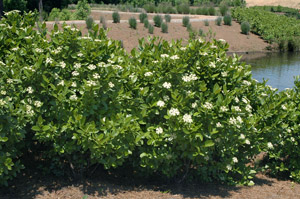 Photo: Steve Sanchez.
Photo: Steve Sanchez.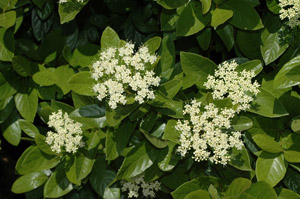 Photo: Steve Sanchez.
Photo: Steve Sanchez.Blackhaw Viburnum / Viburnum prunifolium
Family: Honeysuckle / Caprifoliaceae
Characteristics:
Blackhaw Viburnum is a deciduous, multi-stemmed, flowering shrub or small tree with medium texture, slow to medium growth rate, and rounded form. Creamy-white flowers are borne in flat heads in May. Fruit are bluish-black drupes in fall. Dark green foliage in summer turns beautiful red-bronze in fall. The rigid horizontal branches and spur-like twigs give it the name Blackhaw.
Landscape Uses:
Use Blackhaw Viburnum as a specimen tree. It is adaptable to many sites from sun to partial shade and shows good drought tolerance. It transplants easily.
Size:
12 to 20 feet tall and 8 to 15 feet wide
Zones:
6a, 7a, 7b, 8a, 8b
Habitat:
A wide variety of woodlands and forest edges, roadsides and fence rows.
Native To:
Connecticut to Florida, west to Michigan and Texas.
Comments:
Birds enjoy the fruit.
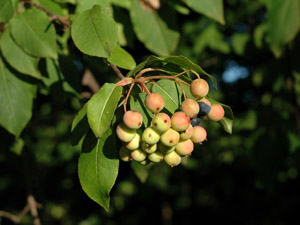 Photo: Steve Sanchez.
Photo: Steve Sanchez.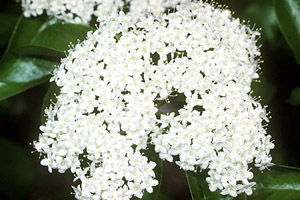 Photo: R.H. Mohlenbrock, USDA-NRCS PLANTS Database.
Photo: R.H. Mohlenbrock, USDA-NRCS PLANTS Database.
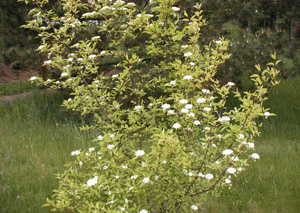 Photo: Dow Gardens Archive, Bugwood.org.
Photo: Dow Gardens Archive, Bugwood.org.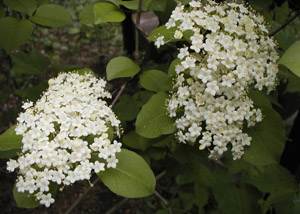 Photo: Dow Gardens Archive, Bugwood.org.
Photo: Dow Gardens Archive, Bugwood.org.Rusty Blackhaw / Viburnum rufidulum
Family: Honeysuckle / Caprifoliaceae
Characteristics:
Rusty Blackhaw is a deciduous shrub with leathery, pubescent foliage. Flowers are creamy white and borne in flat heads in April and May. Fruit are dark blue and have a waxy bloom. The undersides of leaves and buds have short, dense, rusty-red hairs that are useful in identifying this species. Fall color is burgundy red.
Landscape Uses:
Use Rusty Blackhaw as an understory plant in partial shade or as a specimen plant in full sun. It grows more densely when planted in full sun. It has excellent drought and cold tolerance.
Size:
6 to 10 feet tall with an equal spread
Zones:
6b, 7a, 7b, 8a, 8b
Habitat:
A variety of upland wooded habitats; most common in calcareous or dry habitats.
Native To:
Virginia to Florida, west to Illinois and Texas.
Comments:
Birds enjoy the fruit.
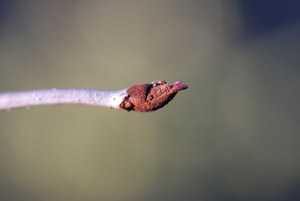 Photo: Ed McDowell.
Photo: Ed McDowell.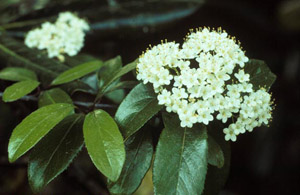 Photo: Gil Nelson.
Photo: Gil Nelson.
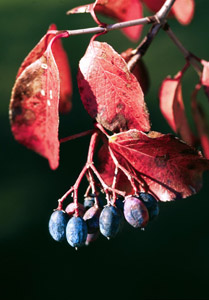 Photo: James H. Miller, Bugwood.org.
Photo: James H. Miller, Bugwood.org. Photo: Ted Bodner, Bugwood.org.
Photo: Ted Bodner, Bugwood.org.
Yellow-Root / Xanthorhiza simplicissima
Family: Buttercup or Crowfoot / Ranunculaceae
Characteristics:
Yellow-Root is a low-growing, erect shrub that spreads and forms colonies via root suckers. The leaves are deciduous and alternate, and consist of five leaflets. Flowers are brown-purple, less than 0.25-inches across, and appear in early spring. The bark and roots are bitter and bright yellow, and yield a yellow dye.
Landscape Uses:
Yellow-Root is not often seen in the landscape, except in natural settings and along stream banks. However, it would make a good ground cover plant along a shady foundation where there are no gutters. It also could be used on a pond or lake edge under deciduous trees and shrubs, or to hold a wet, shaded ditch area. Yellow-Root is an excellent choice for naturalizing in boggy soil.
Size:
1 to 2.5 feet tall and spreading
Zone:
6b, 7a, 7b, 8a, 8b
Habitat:
Moist soils along shaded stream banks or on wet, rocky ledges.
Native To:
New England to Florida, Ohio to Mississippi, and west to Texas.
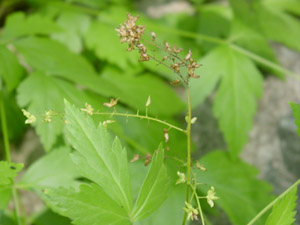 Photo: Gary Wade.
Photo: Gary Wade.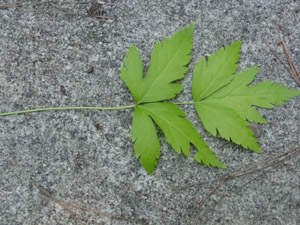 Photo: Gary Wade.
Photo: Gary Wade.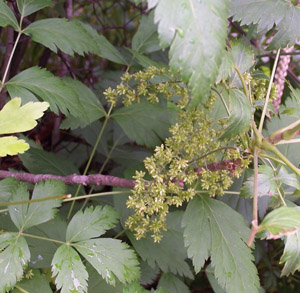 Photo: Michael Strickland.
Photo: Michael Strickland.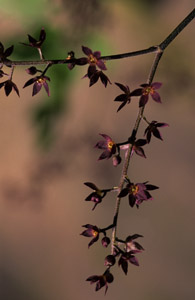 Photo: Hugh & Carol Nourse.
Photo: Hugh & Carol Nourse.
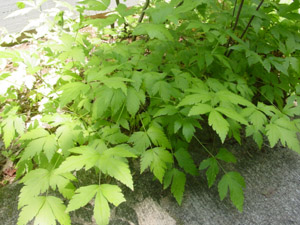 Photo: Gary Wade.
Photo: Gary Wade.Adam’s Needle, Beargrass, Spanish Bayonet, Curly Leaf Yucca / Yucca filamentosa
Family: Agave / Agavaceae
Characteristics:
Adam’s Needle, also called Beargrass, Spanish Bayonet and Curly Leaf Yucca, is an evergreen shrub with coarse texture and a medium growth rate. It usually grows as a multi-stemmed shrub with a bold, erect, upright appearance. White, showy flowers are borne in terminal clusters in May and June. Flowers are pollinated by only one insect — the yucca moth.
Landscape Uses:
Use Adam’s Needle as an accent plant. The sharp, terminal spines are potentially dangerous. Avoid using the plant in pedestrian areas. This is a tough plant for hot, dry to moist sites in full sun. It does not tolerate shade or wet conditions.
Size:
4 to 10 feet tall and 5 to 15 feet wide
Zones:
6b, 7a, 7b, 8a, 8b
Habitat:
Hot, dry, rocky areas in the lower south.
Native To:
South Carolina to Mississippi and Florida.
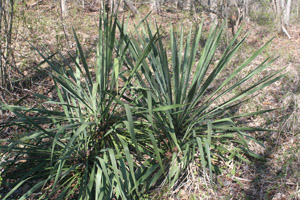 Photo: Bob Westerfield.
Photo: Bob Westerfield.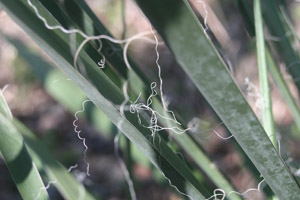 Photo: Bob Westerfield.
Photo: Bob Westerfield.
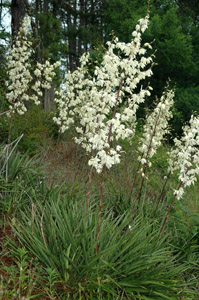 Photo: Steve Sanchez.
Photo: Steve Sanchez.Honeycup / Zenobia pulverulenta
Family: Heath / Ericaceae
Characteristics:
 Photo: Walter S. Judd, USDA-NRCS PLANTS Database.
Photo: Walter S. Judd, USDA-NRCS PLANTS Database.Honeycup, or Zenobia, is a medium-size, stoloniferous shrub. Leaves are deciduous or semi-evergreen, alternate, leathery, pale green to bluish-white. The underside of the leaf is whitish and smooth. Flowers are white, showy, fragrant, nodding downward in clusters at leaf axils of the previous year’s growth. Fruit are globose, five-valved capsules with a white bloom.
Landscape Uses:
Use Honeycup as a specimen plant or in a mixed foundation planting near a downspout. It is a showy shrub with handsome, fragrant flowers and bluish-white leaves. It requires moist, acid soil, good drainage and afternoon shade.
Size:
3 to 6 feet tall by 4 feet wide
Zones:
7b, 8a, 8b
Habitat:
Bogs, bays, wet savannahs and swamps in the Coastal Plain.
Native To:
Virginia to Georgia.
Comment:
This species is rare in Georgia.
Woody Vines
In this section:
- American Wisteria / Wisteria frutescens
- Carolina Yellow Jessamine / Gelsemium sempervirens
- Climbing Hydrangea / Decumaria barbara
- Crossvine / Bignonia capreolata
- Dwarf Smilax, Sarsaparilla Vine / Smilax pumila
- Lanceleaf Smilax, Sweet-Scented Smilax / Smilax smallii
- Trumpet Honeysuckle / Lonicera sempervirens
- Trumpetcreeper / Campsis radicans
- Virginia Creeper / Parthenocissus quinquefolia
Crossvine / Bignonia capreolata
Family: Bignonia / Bignoniaceae
Characteristics:
Crossvine is a semi-evergreen to evergreen vine, medium in texture, with a fast growth rate. It climbs by twining and tendrils or grows along the ground. The foliage is dark green in summer with a purplish cast in winter. Trumpet-shaped orange-red flowers are borne from April to June. Its common name refers to the cross pattern seen when the stem is cut.
Landscape Uses:
Crossvine is a good plant for quickly covering trellises and fences. It is easy to grow when provided with adequate moisture and full sun to light shade. Crossvine is a tough plant that will tolerate environmental extremes. It needs training for the first few years after transplanting.
Size:
A climbing vine growing to 30 to 50 feet
Zones:
6b, 7a, 7b, 8a, 8b
Habitat:
Moist, forested areas.
Native To:
Maryland, Virginia and southern Illinois; south to Florida and Louisiana.
Comments:
A good hummingbird plant. Cultivars are available.
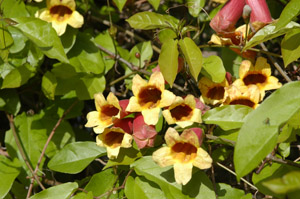 Photo: Ed McDowell.
Photo: Ed McDowell.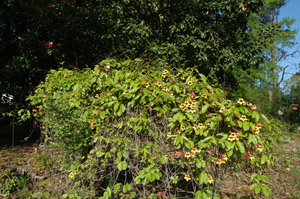 Photo: Ed McDowell.
Photo: Ed McDowell.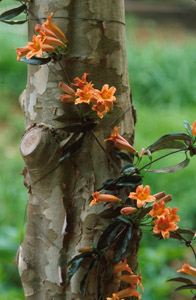 Photo: Hugh & Carol Nourse.
Photo: Hugh & Carol Nourse.Trumpetcreeper / Campsis radicans
Family: Bignonia / Bignoniaceae
Characteristics:
Trumpetcreeper is a deciduous vine with medium texture and a fast growth rate. It is a twining, clinging and climbing vine; it will also spread along the ground. The leaf is compound, and flowers are trumpet-shaped, orange to red. They bloom from June to August in clusters of four to 12 flowers. The fruit is an elongated capsule bearing numerous seeds.
Landscape Uses:
Trumpetcreeper is easy to grow and useful for quickly covering fences or trellises, particularly when a deciduous vine is needed to allow for winter sun. It does well in almost any situation, from wet to dry, full sun to partial shade. Full sun is best. Trumpetcreeper is aggressive and will climb poles or other plants, so plant it where it will not become a pest. It will require pruning.
Size:
A climbing vine reaching 30 to 40 feet
Zones:
6b, 7a, 7b, 8a, 8b
Habitat:
Upland wooded areas, fence rows.
Native To:
Pennsylvania to Missouri, south to Florida and Texas.
Comments:
A good hummingbird plant.
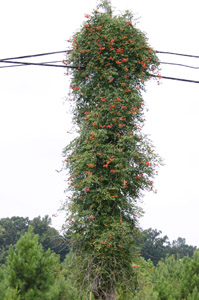 Photo: Theresa Schrum.
Photo: Theresa Schrum.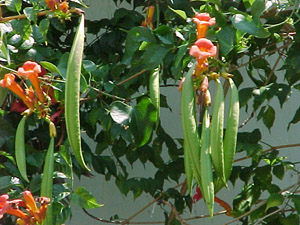 Photo: Gary Wade.
Photo: Gary Wade.Climbing Hydrangea / Decumaria barbara
Family: Hydrangea / Hydrangeaceae
Characteristics:
Climbing Hydrangea is a deciduous vine with medium-coarse texture and a medium growth rate. It climbs by aerial root-like holdfasts. Fragrant, small white flowers are borne in terminal clusters from May to June. The unusual fruit is a capsule shaped like a small urn.
Landscape Uses:
Climbing Hydrangea does best when planted in moist soils with good drainage and partial shade. Fertilize regularly for best growth. It does not do well in dry, poor soils. It will climb trees and masonry structures but is not overly aggressive.
Size:
A climbing vine growing 30 to 40 feet
Zones:
6b, 7a, 7b, 8a, 8b
Habitat:
Moist, fertile woodlands and along sandy streams.
Native To:
Virginia to Florida, west to Louisiana.
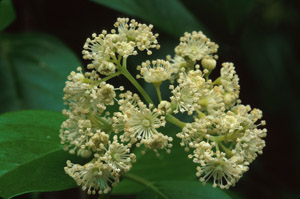 Photo: Hugh & Carol Nourse.
Photo: Hugh & Carol Nourse.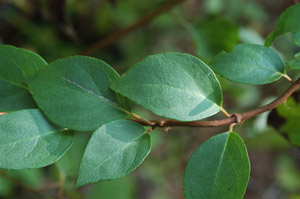 Photo: Ed McDowell.
Photo: Ed McDowell.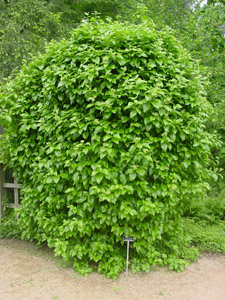 Photo: Gary Wade.
Photo: Gary Wade.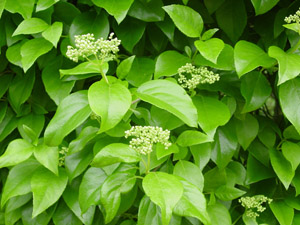 Photo: Gary Wade.
Photo: Gary Wade.Carolina Yellow Jessamine / Gelsemium sempervirens
Family: Logania / Loganiaceae
Characteristics:
Carolina Yellow Jessamine is an evergreen vine with fine texture and a fast growth rate. Fragrant, yellow, trumpet-shaped flowers are borne in February and March. It climbs by twining around branches of other plants.
Landscape Uses:
Use Carolina Yellow Jessamine on trellises, fences, mailboxes, etc. It may need training. It prefers moist, well-drained soils in full sun or partial shade. It can be used as a groundcover in full sun, but flowering will be sparse. It will look spindly in shade.
Size:
Climbing vine growing 10 to 20 feet. It also can be allowed to ramble on the ground.
Zones:
6b, 7a, 7b, 8a, 8b
Habitat:
Moist, wooded, deciduous forests
Native To:
Virginia to Florida, west to Arkansas and Texas; south to Central America.
Comments:
Attractive to hummingbirds and songbirds. Other species, such as the popular repeat-blooming Swamp Jessamine (Gelsemium rankinii) are available. Swamp Jessamine flowers are not fragrant.
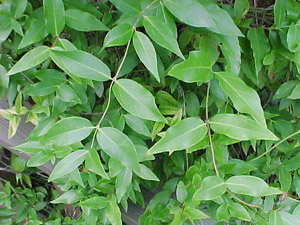 Photo: Gary Wade.
Photo: Gary Wade.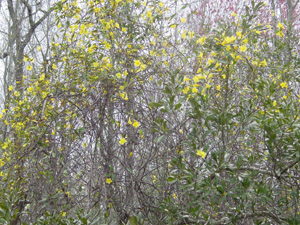 Photo: Gary Wade.
Photo: Gary Wade.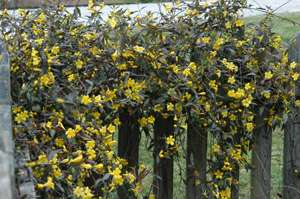 Photo: Ed McDowell.
Photo: Ed McDowell.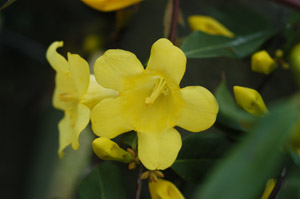 Photo: Ed McDowell.
Photo: Ed McDowell.Trumpet Honeysuckle / Lonicera sempervirens
Family: Honeysuckle / Caprifoliaceae
Characteristics:
Trumpet Honeysuckle is an evergreen vine with medium texture and a medium growth rate. It climbs by twining. Orange to scarlet trumpet-shaped flowers, 2 inches long, are borne in March and April. Fruit are red and moderately showy.
Landscape Uses:
Use Trumpet Honeysuckle on arbors, trellises, fences and walls. It does best when planted in moist, fertile soils in full sun. It is not aggressive and can be kept within bounds with regular pruning. For best flowering, do not over-fertilize.
Size:
Climbing vine growing 10 to 20 feet
Zones:
6b, 7a, 7b, 8a, 8b
Habitat:
Roadsides, fence rows and forest margins in moist, fertile soil.
Native To:
Connecticut to Florida, west to Nebraska and Texas.
Comments:
Birds eat the fruit, and hummingbirds enjoy the flowers, which are pollinated by birds, not bees. Trumpet Honeysuckle is a good choice for people allergic to bee stings. Several cultivars are available.
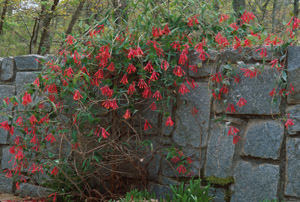 Photo: Hugh & Carol Nourse.
Photo: Hugh & Carol Nourse.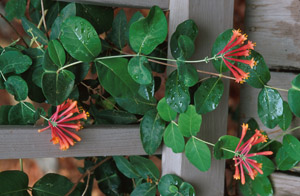 Photo: Hugh & Carol Nourse.
Photo: Hugh & Carol Nourse.
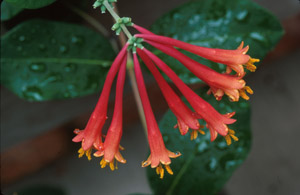 Photo: Hugh & Carol Nourse.
Photo: Hugh & Carol Nourse.Virginia Creeper / Parthenocissus quinquefolia
Family: Grape / Vitaceae
Characteristics:
Virginia Creeper is a deciduous vine with palmate compound leaves, medium texture and a fast growth rate. It climbs by branched tendrils (slender, curling extensions along the stems) that have adhesive-like tips that attach to a structure. Blue berries are borne in fall. Autumn leaf color is scarlet red.
Landscape Uses:
Virginia Creeper is a good plant for quickly covering fences, walls and arbors. It is easy to grow and is tolerant of most sites and soil conditions. In nature, it may be somewhat invasive. For landscapes, it is a low-maintenance vine with excellent fall color.
Size:
A climbing vine growing 30 to 50 feet
Zones:
6b, 7a, 7b, 8a, 8b
Habitat:
Bottomlands and oak hickory forests in moist shade.
Native To:
New England to Florida and Mexico; west to Ohio, Illinois and Missouri.
Comments:
Birds eat the seeds.
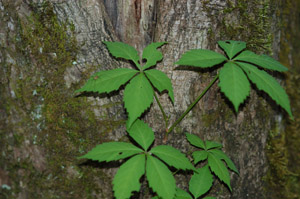 Photo: Ed McDowell.
Photo: Ed McDowell.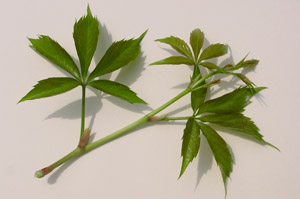 Photo: Gary Wade.
Photo: Gary Wade.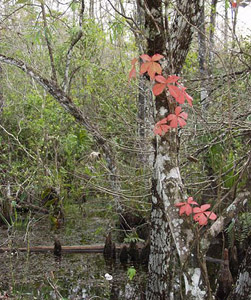 Photo: Shirley Denton.
Photo: Shirley Denton.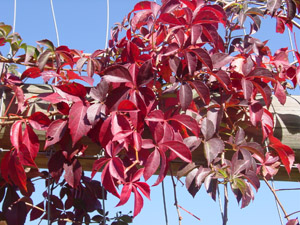 Photo: Gary Wade.
Photo: Gary Wade.Dwarf Smilax (Sarsaparilla Vine) / Smilax pumila
Family: Smilacaceae
Characteristics:
Dwarf Smilax is a thornless, broadleaf evergreen vine with medium texture and a slow growth rate. It is a ground cover plant rather than a climbing vine. It spreads by underground stems. Foliage is a lustrous, dark green. It bears bright-red berries in fall through winter.
Landscape Uses:
Use Dwarf Smilax as a ground cover plant. It looks particularly nice when combined with flowering bulbs or perennials. It requires adequate moisture and some shade for best performance. It does not like hot, dry, exposed locations. It can be established by division or from container-grown plants.
Size:
6 to 8 inches tall and slowly spreading
Zones:
8a, 8b
Habitat:
An understory plant on hardwood forest slopes with good moisture and sandy soils.
Native To:
Coastal Plain from Georgia to Texas.
Comments:
Birds eat the berries.
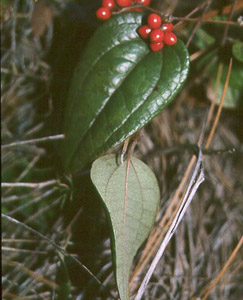 Photo: Fred Nation.
Photo: Fred Nation.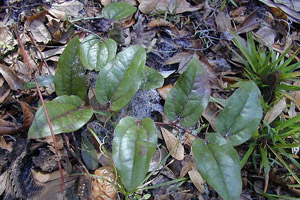 Photo: Shirley Denton.
Photo: Shirley Denton.Lanceleaf Smilax, Sweet-Scented Smilax / Smilax smallii
Family: Smilacaceae
Characteristics:
Lanceleaf Smilax is a climbing evergreen vine with spineless stems. The leaves are lance-shaped, 2 to 3 inches long and about 1 inch wide. Male and female flowers appear in April and May and are borne in umbels at the leaf axils. The female flowers produce berries about 0.25-inches in diameter; they change from white to orange, then to black by late summer.
Landscape Uses:
Lanceleaf Smilax will complement arbors, trellises and fences in full sun to partial shade. Plant in well-drained soils.
Size:
8 to 10 feet
Zones:
6b, 7a, 7b, 8a, 8b
Habitat:
Usually found in sandy, floodplain forests.
Native To:
Virginia to Florida; west to Texas, Oklahoma and Arkansas.
Comments:
The cut vines hold up well and are used by florists. The plant is a good food source for wildlife.
 Photo: Chris Evans, Bugwood.org.
Photo: Chris Evans, Bugwood.org.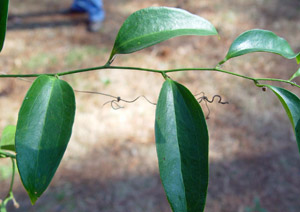 Photo: Chris Evans, Bugwood.org.
Photo: Chris Evans, Bugwood.org.
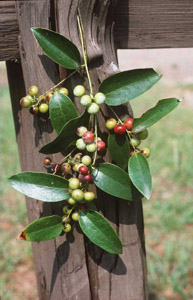 Photo: Robert H. Mohlenbrock, USDA-NRCS PLANTS Database.
Photo: Robert H. Mohlenbrock, USDA-NRCS PLANTS Database.American Wisteria / Wisteria frutescens
Family: Pea / Fabaceae
Characteristics:
American Wisteria is a twining, deciduous, woody vine that bears light lavender flowers in spring. The flowers are pea-like and borne in 2- to 4-inch-long clusters, called racemes. Leaves are pinnately compound with five to seven pairs of leaflets. Seeds are borne in a legume-like pod.
Landscape Uses:
Use American Wisteria on arbors, trellises, fences and walls. It is not nearly as aggressive or invasive as the exotic wisterias, and it is a much better choice for the landscape. It performs best in moist, fertile soil.
Size:
A climbing vine growing 15 to 30 feet
Zones:
7b, 8a, 8b
Habitat:
Along stream banks of creeks and rivers, and at woodland borders in the Coastal Plain and Piedmont.
Native To:
Virginia to Florida and Texas.
Comments:
Cultivars such as "Amethyst Falls" are available.
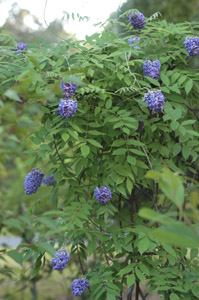 Photo: Ed McDowell.
Photo: Ed McDowell.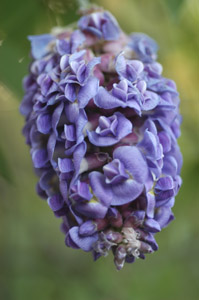 Photo: Ed McDowell.
Photo: Ed McDowell.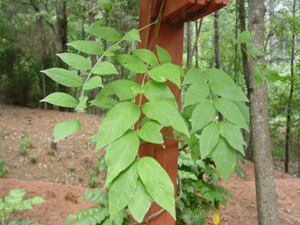 Photo: Gary Wade.
Photo: Gary Wade.
Glossary
- Acute:
- Terminating with a sharp or well-defined angle.
- Anther:
- The organ at the upper end of a stamen that secretes and discharges pollen. The male part of a flower.
- Appressed:
- Lying flat or pressed closely against.
- Axil:
- The angle between a stem and the upper side of a leaf.
- Bipinnately Compound:
- A compound leaf arrangement whereby several side leaflets are arranged along the central leaf axis, called a rachis, and these leaflets are again divided into several leaflets.
- Bluff:
- A steep headland, promontory, river bank or cliff.
- Calcareous:
- Containing calcium carbonate, calcium or limestone; chalky.
- Capsule:
- A fruit that contains two or more seeds, and that dries and splits open.
- Colonial:
- Forming colonies by means of underground rhizomes, stolons, etc.
- Compound Leaf:
- A leaf divided into two or more leaflets.
- Conifer:
- A predominately evergreen, cone-bearing tree.
- Deciduous:
- Descriptive of a plant that sheds its leaves at the end of the growing season.
- Dioecious:
- Male and female flowers borne on separate plants, as in hollies.
- Dunes:
- Ridges or hills of wind-blown sand.
- Ecotype:
- A plant adapted to a specific environment that has not undergone sufficient genetic change to be considered a separate species or sub-species.
- Elliptic:
- Narrow at the ends and broad near the center.
- Fascicle:
- A close bundle or cluster.
- Glabrous:
- Smooth
- Glaucous:
- Grayish green or bluish green due to a fine, whitish, powdery coating.
- Hammock (syn. Hummock):
- A low mound or ridge of earth.
- Lance-shaped:
- Elongate in shape, broadest below the middle, and gradually pointed toward the tip.
- Lobe:
- A subdivision distinguishable by some structural boundary.
- Mesic:
- Moderately moist.
- Midden:
- A refuse heap.
- Obovate:
- Egg-shaped, with the narrow end attached to the stalk.
- Palmate:
- Describes a leaf that is radially lobed, like the spokes of a wheel. Imagine a leaf shaped like the palm of the hand, with lobes radiating outward from one central point.
- Panicles:
- Loose, irregularly-compound inflorescence flowers borne on short stems or pedicels.
- Pedicel:
- A flower stalk; the support of a single flower.
- Pinnately Compound:
- With leaflets arranged in two rows along an axis.
- Pioneer species:
- A species that establishes itself in a previously barren environment.
- Pistil:
- The seed-bearing organ of a flower, including the stigma, style and ovary.
- Pistillate:
- Describes a flower bearing only female parts (stigma, style, ovary) and no stamens (filament, anther).
- Pocosins:
- Depressions in open areas of pine savannahs and seepage slopes near streams.
- Pubescence:
- A covering of soft, short hairs.
- Raceme:
- An elongate cluster of flowers along the main stem in which the flowers at the base open first.
- Revolute:
- Rolled backward from the margins or apex.
- Rhizome:
- An underground stem that is usually horizontal in position and frequently woody or fleshy.
- Samara:
- A dry, one-seeded, winged fruit that remains closed and does not split open at maturity (indehiscent).
- Serrated:
- With many small protrusions or teeth along the margins.
- Stamen:
- The male reproductive part of a flower, usually consisting of a slender threadlike filament and the pollen-bearing anther.
- Staminate:
- A flower lacking female parts, having only stamens (male parts).
- Stigma:
- The tip of a pistil, usually expanded and sticky, that receives pollen.
- Stolon:
- An elongated horizontal stem creeping along the surface of the ground and rooting at the tip and nodes to produce a new plant.
- Stoloniferous:
- Describes plants that produce slender, above-ground stems that spread outward, rooting and forming new shoots at nodes. Strawberry is a stoloniferous plant.
- Succession:
- Gradual changes in species populations culminating in a climax characteristic of a particular geographic region.
- Thicket:
- A dense growth of shrubs or undergrowth.
- Trifoliate:
- Having three leaflets.
- Umbel:
- A flower cluster, usually rounded or flat-topped, with all stems springing from the same point.
Suggested References
Brown, Claude L., and L. Katherine Kirkman. 1990. Trees of Georgia and Adjacent States. Timber Press, ISBN 0-88192-148-3.
Cullina, William. 2002. Native Trees, Shrubs and Vines. New York: Houghton Mifflin Co. ISBN 0-618-09858-5.
Dirr, Michael A. 1998. Manual of Woody Landscape Plants. Stipes Publishing Co. ISBN 0-87563-795-7.
Duncan, Wilbur, and Marion Duncan. 1988. Trees of the Southeastern United States. University of Georgia Press. ISBN 0-8203-0954-0.
Foote, Leonard E., and Samuel B. Jones Jr. 1989. Native Shrubs and Woody Vines of the Southeast. Timber Press. ISBN 0-88192-128-9.
Lance, Ron. 2004. Woody Plants of the Southeastern United States: A Winter Guide. University of Georgia Press. ISBN 0-8203-2524-4.
Godfrey, Robert K. 1988. Trees, Shrubs and Woody Vines of Northern Florida and Adjacent Georgia and Alabama. University of Georgia Press. ISBN 0-8203-1035-2.
Nelson, Gil. 2003. Florida’s Best Native Landscape Plants. University Press of Florida, Gainesville. ISBN 0-8130-2644-X.
Stein, J., D. Binion, and R. Acciavatti. 2003. Field Guide to Native Oak Species of Eastern North America. U.S. Forest Service publication FHTET-2003-01.
Weakley, Alan S. 2005. Flora of the Carolinas, Virginia and Georgia. University of North Carolina Herbarium, North Carolina Botanical Garden, Chapel Hill, N.C. Online publication at www.herbarium.une.edu
Status and Revision History
Published on Aug 11, 2008
Published with Full Review on Aug 17, 2011
Published with Full Review on Aug 01, 2014
Published with Full Review on Aug 07, 2017
Published with Full Review on Apr 01, 2021
Published with Full Review on Aug 29, 2024



























































